Exhibit 15(a)(i)
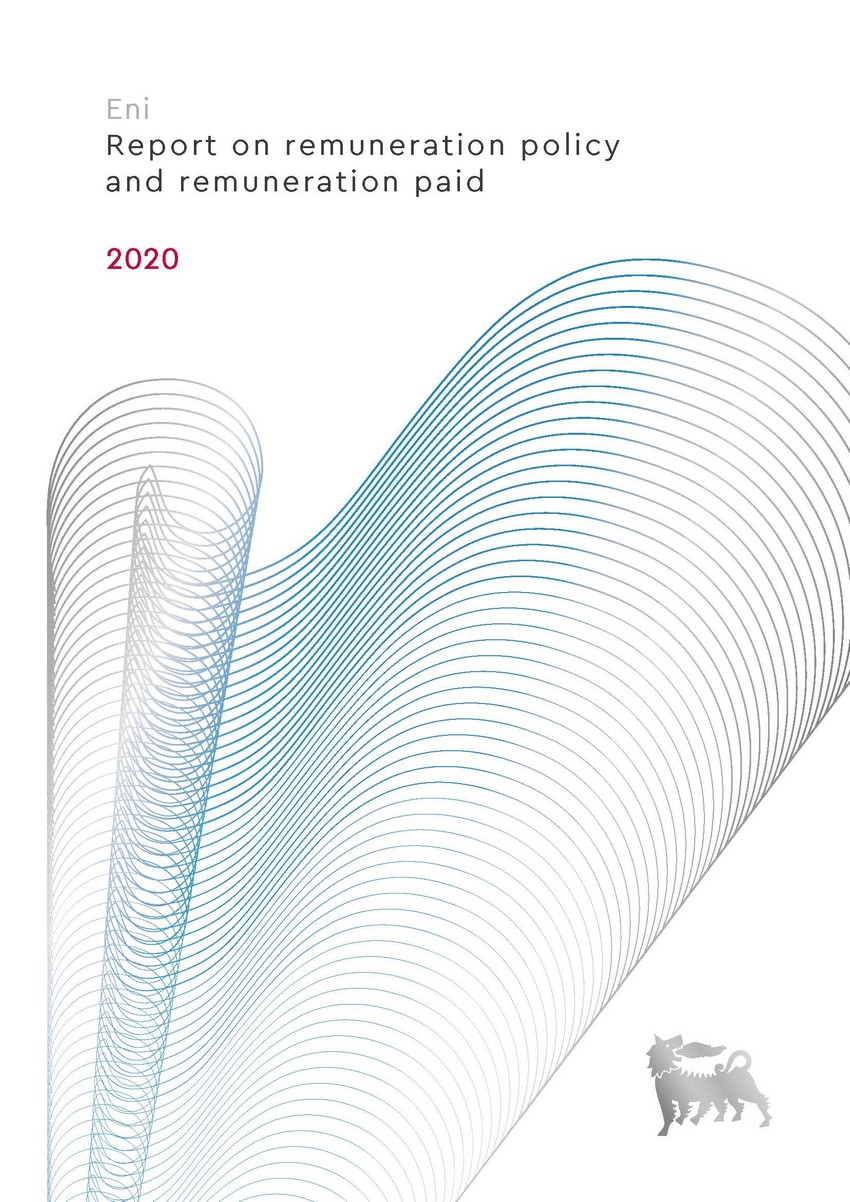 | Eni Reportonremunerationpolicy andremunerationpaid 2020 |
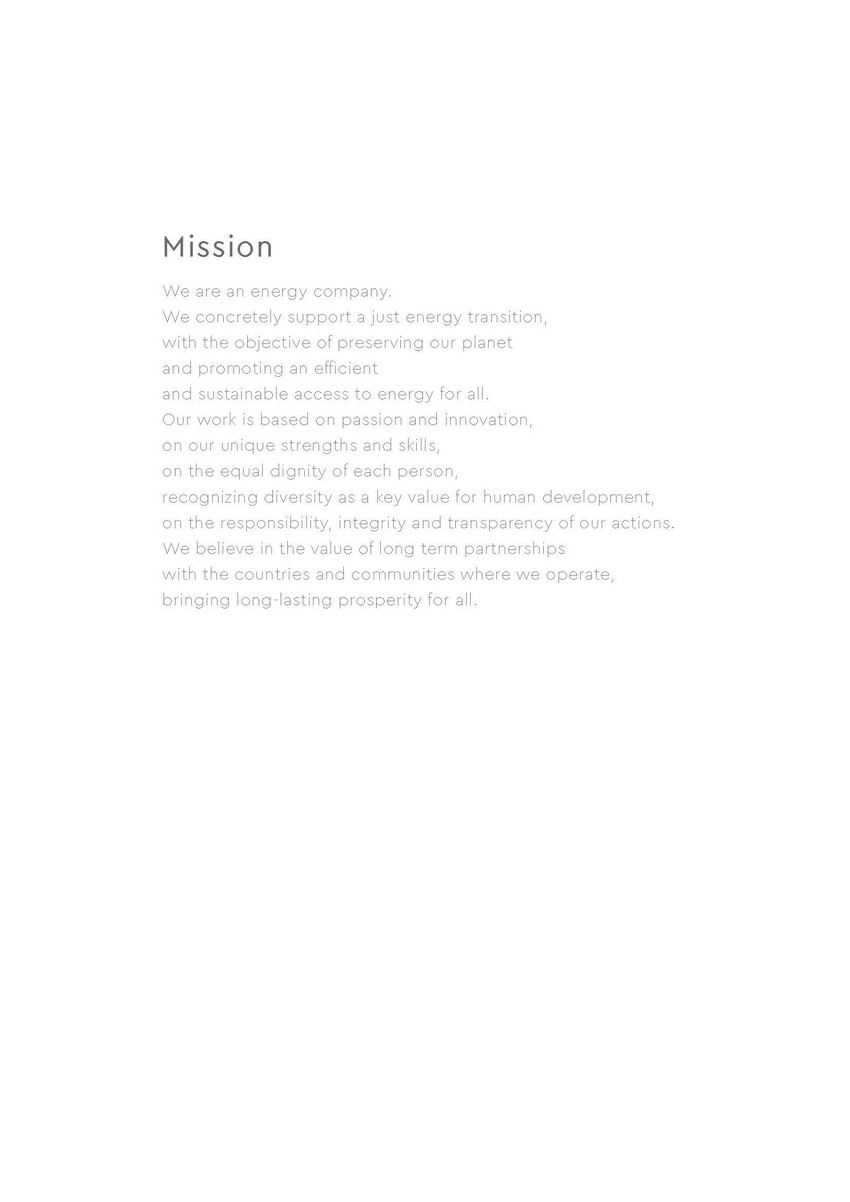 | Mission We are an energy company. We concretely support a just energy transition, with the objective of preserving our planet and promoting an effi and sustainable access to energy for all. Our work is based on passion and innovation, on our unique strengths and skills, on the equal dignity of each person, recognizing diversity as a key value for human development, on the responsibility, integrity and transparency of our actions. We believe in the value of long term partnerships with the countries and communities where we operate, bringing long-lasting prosperity for all. |
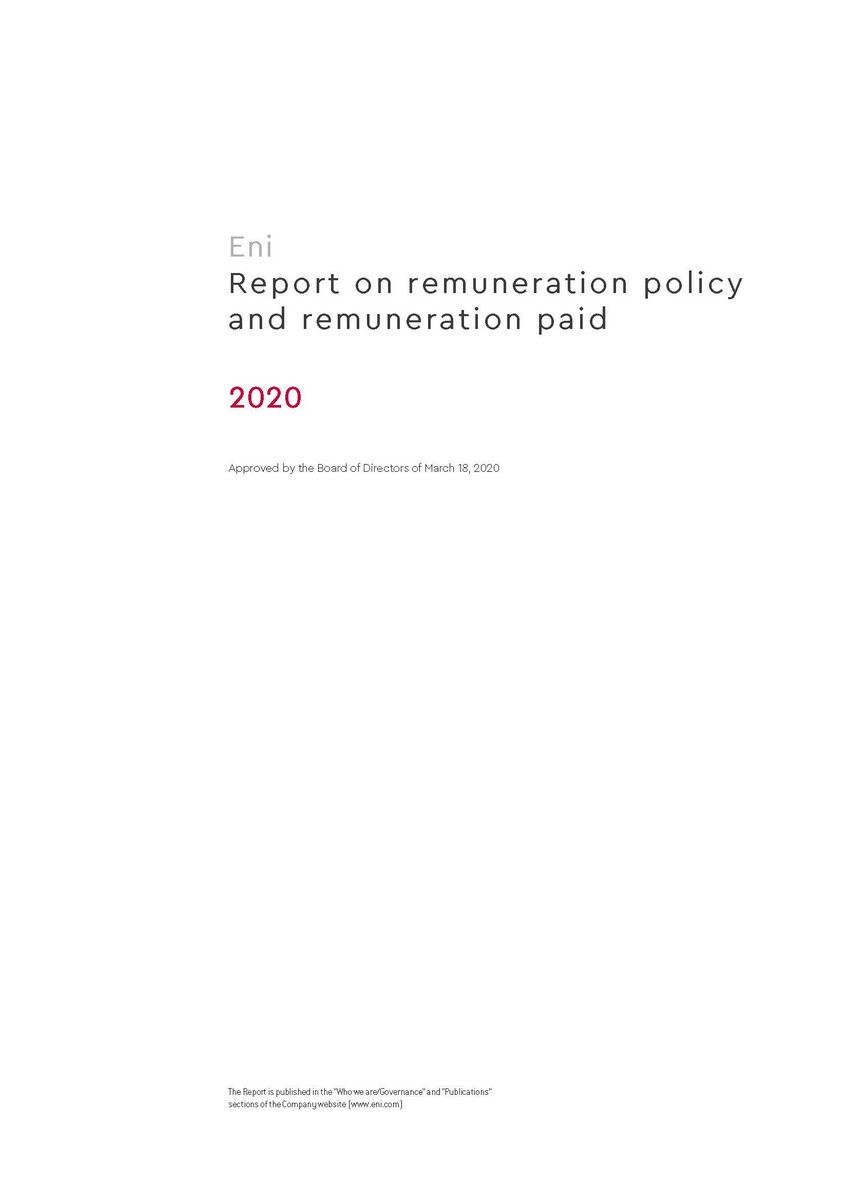 | Eni Reportonremunerationpolicy andremunerationpaid 2020 Approved by the Board of Directors of March 18, 2020 The Report is published in the “Who we are/Governance” and “Publications” sections of the Company website (www.eni.com) |
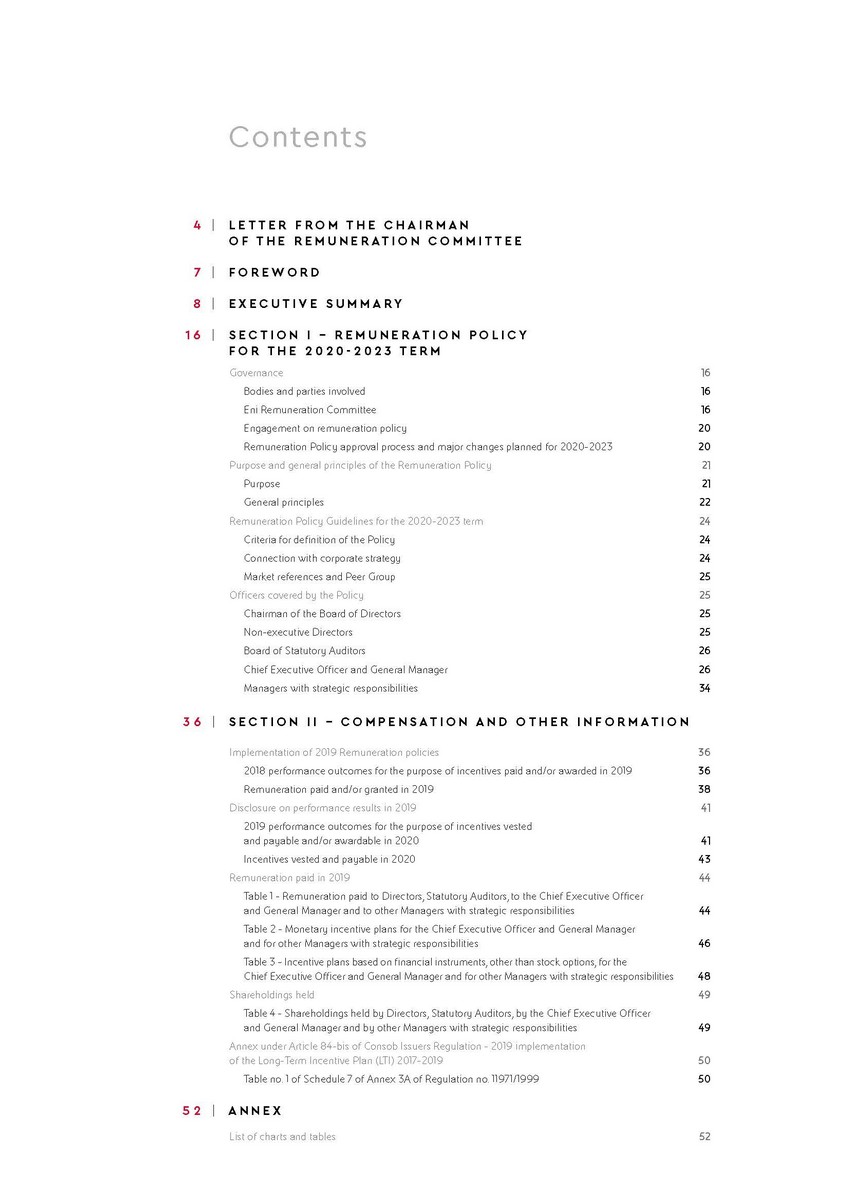 | Contents 4 | 7 | 8 | 16 | LETTER FR OM THE CHAIRMAN OF THE REMUNERA TION C OMMITTEE F OREW ORD EXE CUTIVE SUMMAR Y SE CTION I - REMUNERA TION POLIC Y F OR THE 2020-2023 TERM Governance16 Bodies and parties involved16 Eni Remuneration Committee16 Engagement on remuneration policy20 Remuneration Policy approval process and major changes planned for 2020-202320 Purpose and general principles of the Remuneration Policy21 Purpose21 General principles22 Remuneration Policy Guidelines for the 2020-2023 term24 Criteria for definition of the Policy24 Connection with corporate strategy24 Market references and Peer Group25 Officers covered by the Policy25 Chairman of the Board of Directors25 Non-executive Directors25 Board of Statutory Auditors26 Chief Executive Officer and General Manager26 Managers with strategic responsibilities34 36 | SE CTION II - C OMPENS A TION AND O THER INF ORMA TION 52 | ANNEX List of charts and tables52 |
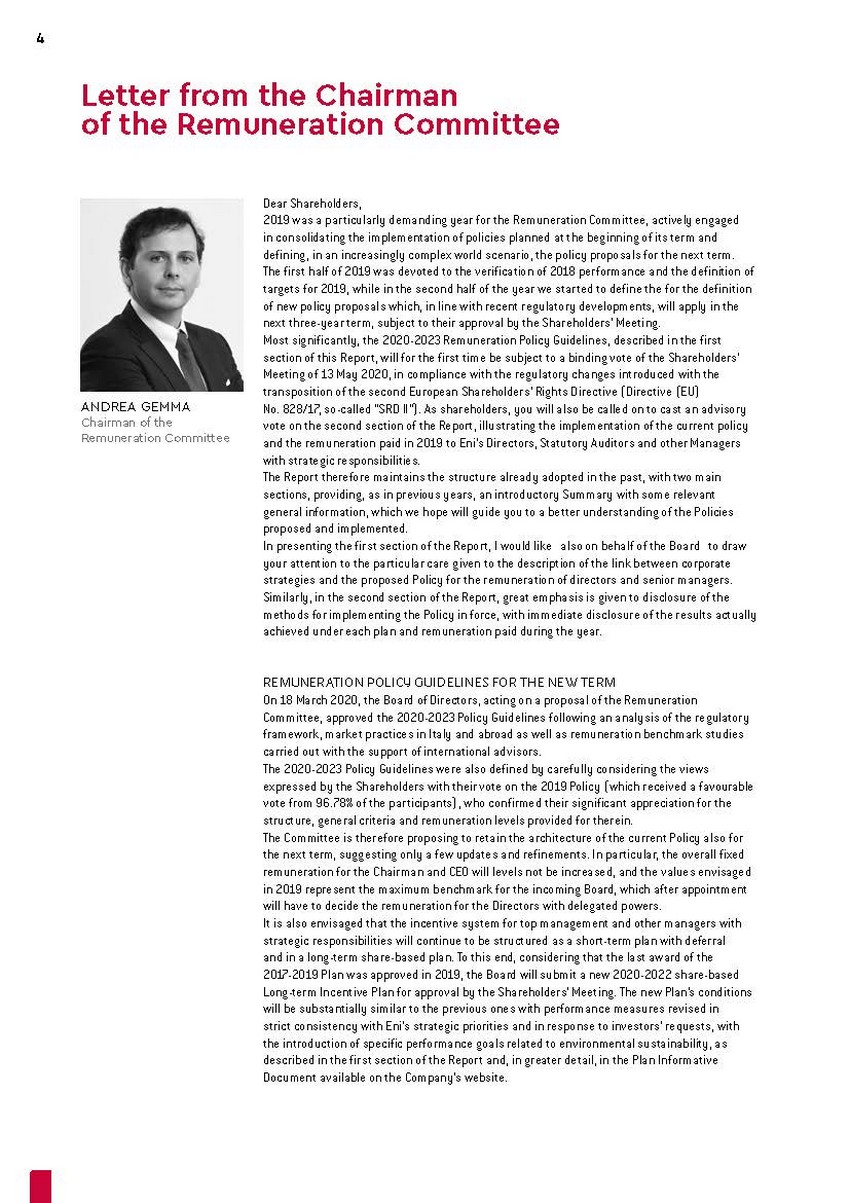 | Letter from the Chairman of the Remuneration Committee ANDREA GEMMA Chairman of the Remuneration Committee Dear Shareholders, 2019 was a particularly demanding year for the Remuneration Committee, actively engaged in consolidating the implementation of policies planned at the beginning of its term and defining, in an increasingly complex world scenario, the policy proposals for the next term. The first half of 2019 was devoted to the verification of 2018 performance and the definition of targets for 2019, while in the second half of the year we started to define the for the definition of new policy proposals which, in line with recent regulatory developments, will apply in the next three-year term, subject to their approval by the Shareholders’ Meeting. Most significantly, the 2020-2023 Remuneration Policy Guidelines, described in the first section of this Report, will for the first time be subject to a binding vote of the Shareholders’ Meeting of 13 May 2020, in compliance with the regulatory changes introduced with the transposition of the second European Shareholders' Rights Directive (Directive (EU) No. 828/17, so-called “SRD II”). As shareholders, you will also be called on to cast an advisory vote on the second section of the Report, illustrating the implementation of the current policy and the remuneration paid in 2019 to Eni’s Directors, Statutory Auditors and other Managers with strategic responsibilities. The Report therefore maintains the structure already adopted in the past, with two main sections, providing, as in previous years, an introductory Summary with some relevant general information, which we hope will guide you to a better understanding of the Policies proposed and implemented. In presenting the first section of the Report, I would like also on behalf of the Board to draw your attention to the particular care given to the description of the link between corporate strategies and the proposed Policy for the remuneration of directors and senior managers. Similarly, in the second section of the Report, great emphasis is given to disclosure of the methods for implementing the Policy in force, with immediate disclosure of the results actually achieved under each plan and remuneration paid during the year. REMUNERATION POLICY GUIDELINES FOR THE NEW TERM On 18 March 2020, the Board of Directors, acting on a proposal of the Remuneration Committee, approved the 2020-2023 Policy Guidelines following an analysis of the regulatory framework, market practices in Italy and abroad as well as remuneration benchmark studies carried out with the support of international advisors. The 2020-2023 Policy Guidelines were also defined by carefully considering the views expressed by the Shareholders with their vote on the 2019 Policy (which received a favourable vote from 96.78% of the participants), who confirmed their significant appreciation for the structure, general criteria and remuneration levels provided for therein. The Committee is therefore proposing to retain the architecture of the current Policy also for the next term, suggesting only a few updates and refinements. In particular, the overall fixed remuneration for the Chairman and CEO will levels not be increased, and the values envisaged in 2019 represent the maximum benchmark for the incoming Board, which after appointment will have to decide the remuneration for the Directors with delegated powers. It is also envisaged that the incentive system for top management and other managers with strategic responsibilities will continue to be structured as a short-term plan with deferral and in a long-term share-based plan. To this end, considering that the last award of the 2017-2019 Plan was approved in 2019, the Board will submit a new 2020-2022 share-based Long-term Incentive Plan for approval by the Shareholders’ Meeting. The new Plan’s conditions will be substantially similar to the previous ones with performance measures revised in strict consistency with Eni’s strategic priorities and in response to investors’ requests, with the introduction of specific performance goals related to environmental sustainability, as described in the first section of the Report and, in greater detail, in the Plan Informative Document available on the Company’s website. |
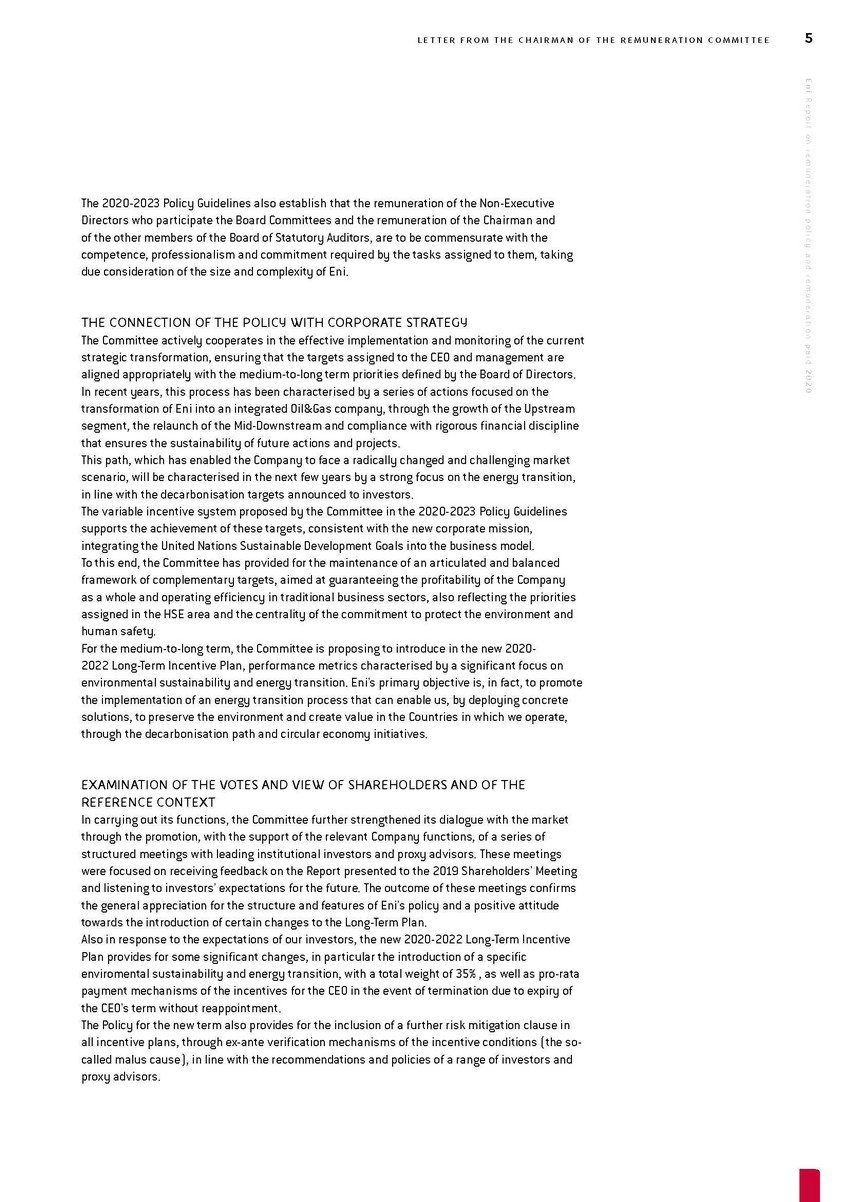 | L ETTER FR OM TH E CHAI R MAN OF TH E REMU N ER A TION C OMMITTEE5 Eni R eport on r emuner ation policy and r emuner ation paid 20 20 competence, professionalism and commitment required by the tasks assigned to them, taking due consideration of the size and complexity of Eni. THE CONNECTION OF THE POLICY WITH CORPORATE STRATEGY The Committee actively cooperates in the effective implementation and monitoring of the current strategic transformation, ensuring that the targets assigned to the CEO and management are aligned appropriately with the medium-to-long term priorities defined by the Board of Directors. In recent years, this process has been characterised by a series of actions focused on the transformation of Eni into an integrated Oil&Gas company, through the growth of the Upstream segment, the relaunch of the Mid-Downstream and compliance with rigorous financial discipline that ensures the sustainability of future actions and projects. This path, which has enabled the Company to face a radically changed and challenging market scenario, will be characterised in the next few years by a strong focus on the energy transition, in line with the decarbonisation targets announced to investors. The variable incentive system proposed by the Committee in the 2020-2023 Policy Guidelines supports the achievement of these targets, consistent with the new corporate mission, integrating the United Nations Sustainable Development Goals into the business model. To this end, the Committee has provided for the maintenance of an articulated and balanced framework of complementary targets, aimed at guaranteeing the profitability of the Company as a whole and operating efficiency in traditional business sectors, also reflecting the priorities assigned in the HSE area and the centrality of the commitment to protect the environment and human safety. For the medium-to-long term, the Committee is proposing to introduce in the new 2020-2022 Long-Term Incentive Plan, performance metrics characterised by a significant focus on environmental sustainability and energy transition. Eni’s primary objective is, in fact, to promote the implementation of an energy transition process that can enable us, by deploying concrete solutions, to preserve the environment and create value in the Countries in which we operate, through the decarbonisation path and circular economy initiatives. EXAMINATION OF THE VOTES AND VIEW OF SHAREHOLDERS AND OF THE REFERENCE CONTEXT In carrying out its functions, the Committee further strengthened its dialogue with the market through the promotion, with the support of the relevant Company functions, of a series of structured meetings with leading institutional investors and proxy advisors. These meetings were focused on receiving feedback on the Report presented to the 2019 Shareholders’ Meeting and listening to investors’ expectations for the future. The outcome of these meetings confirms the general appreciation for the structure and features of Eni’s policy and a positive attitude towards the introduction of certain changes to the Long-Term Plan. Also in response to the expectations of our investors, the new 2020-2022 Long-Term Incentive Plan provides for some significant changes, in particular the introduction of a specific enviromental sustainability and energy transition, with a total weight of 35% , as well as pro-rata payment mechanisms of the incentives for the CEO in the event of termination due to expiry of the CEO’s term without reappointment. The Policy for the new term also provides for the inclusion of a further risk mitigation clause in all incentive plans, through ex-ante verification mechanisms of the incentive conditions (the so-called malus cause), in line with the recommendations and policies of a range of investors and proxy advisors. |
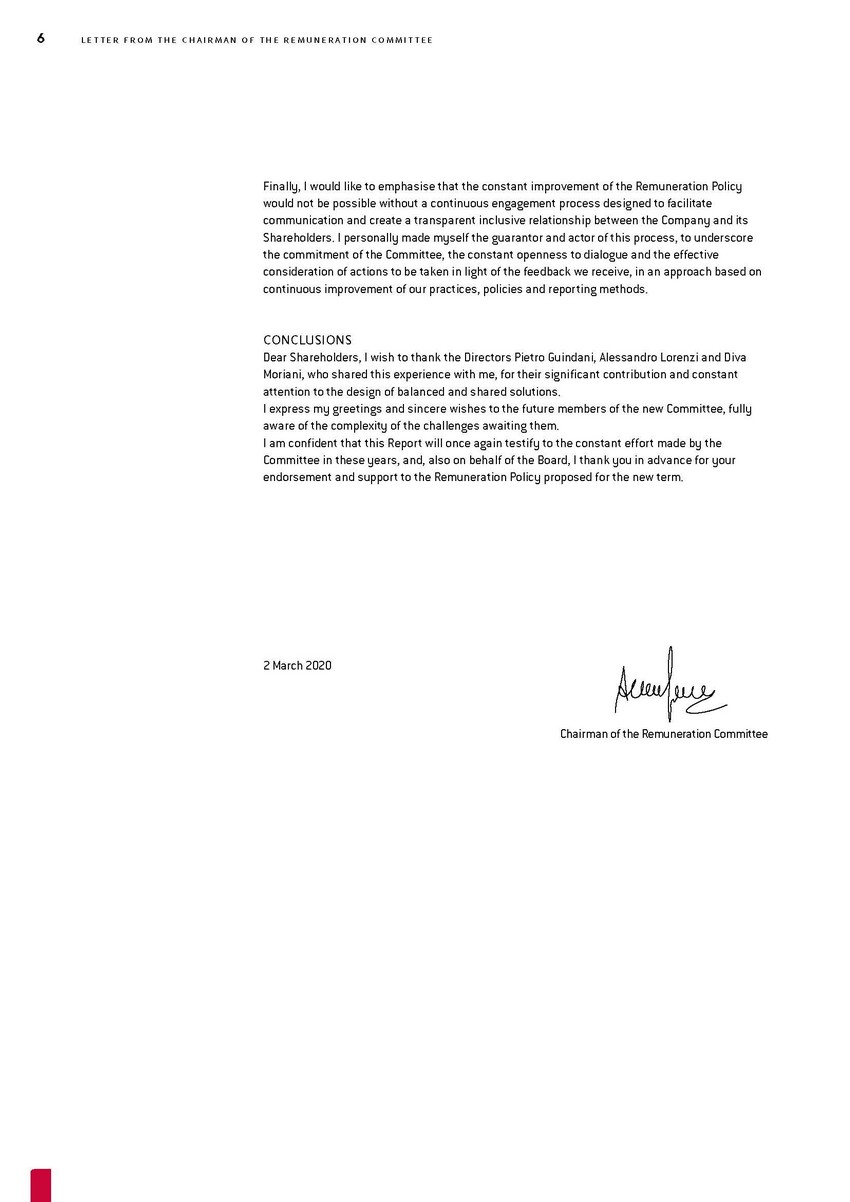 | Finally, I would like to emphasise that the constant improvement of the Remuneration Policy would not be possible without a continuous engagement process designed to facilitate communication and create a transparent inclusive relationship between the Company and its Shareholders. I personally made myself the guarantor and actor of this process, to underscore the commitment of the Committee, the constant openness to dialogue and the effective consideration of actions to be taken in light of the feedback we receive, in an approach based on continuous improvement of our practices, policies and reporting methods. CONCLUSIONS Dear Shareholders, I wish to thank the Directors Pietro Guindani, Alessandro Lorenzi and Diva Moriani, who shared this experience with me, for their significant contribution and constant attention to the design of balanced and shared solutions. I express my greetings and sincere wishes to the future members of the new Committee, fully aware of the complexity of the challenges awaiting them. I am confident that this Report will once again testify to the constant effort made by the Committee in these years, and, also on behalf of the Board, I thank you in advance for your endorsement and support to the Remuneration Policy proposed for the new term. 2 March 2020 Chairman of the Remuneration Committee |
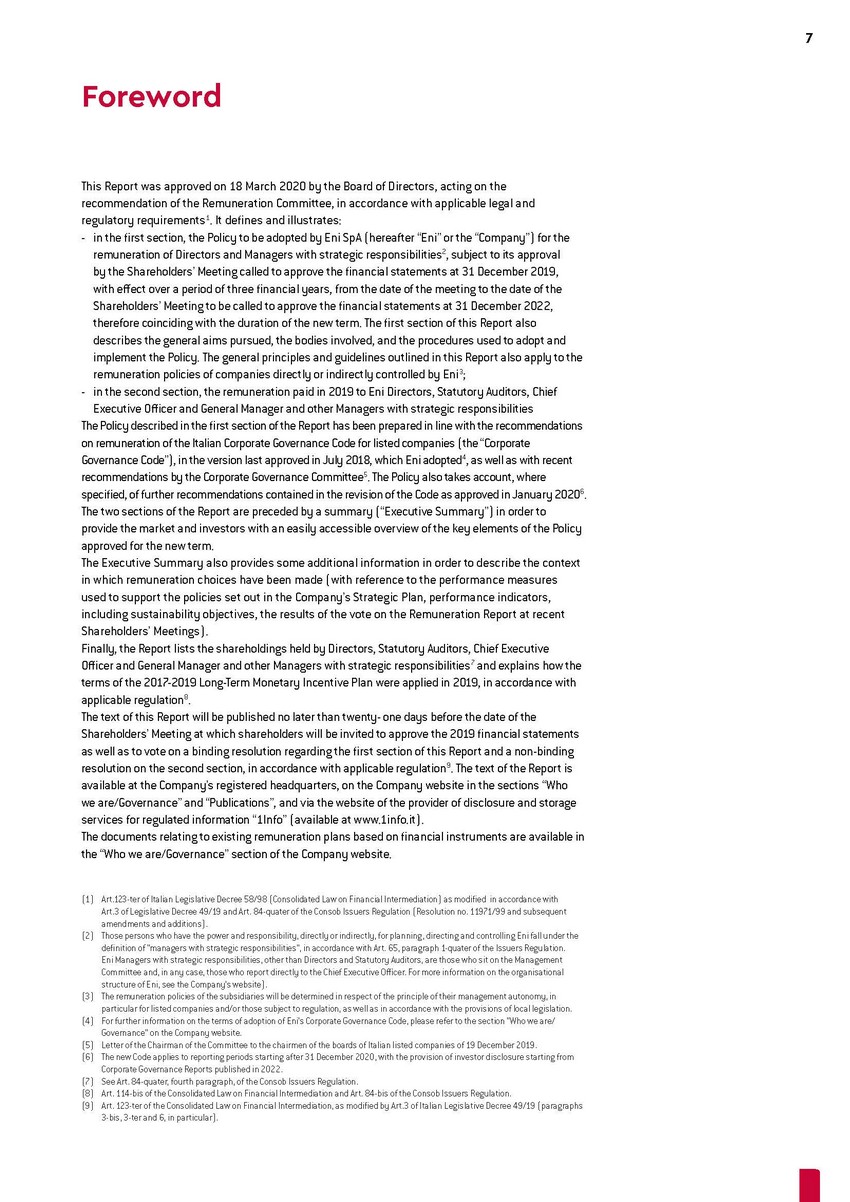 | 7 Foreword This Report was approved on 18 March 2020 by the Board of Directors, acting on the recommendation of the Remuneration Committee, in accordance with applicable legal and regulatory requirements1. It defi es and illustrates: in the first section, the Policy to be adopted by Eni SpA (hereafter “Eni” or the “Company”) for the remuneration of Directors and Managers with strategic responsibilities2, subject to its approval by the Shareholders’ Meeting called to approve the financial statements at 31 December 2019, with effect over a period of three financial years, from the date of the meeting to the date of the Shareholders’ Meeting to be called to approve the financial statements at 31 December 2022, therefore coinciding with the duration of the new term. The first section of this Report also describes the general aims pursued, the bodies involved, and the procedures used to adopt and implement the Policy. The general principles and guidelines outlined in this Report also apply to the remuneration policies of companies directly or indirectly controlled by Eni3; in the second section, the remuneration paid in 2019 to Eni Directors, Statutory Auditors, Chief Executive Officer and General Manager and other Managers with strategic responsibilities The Policy described in the fi t section of the Report has been prepared in line with the recommendations on remuneration of the Italian Corporate Governance Code for listed companies (the “Corporate Governance Code”), in the version last approved in July 2018, which Eni adopted4, as well as with recent recommendations by the Corporate Governance Committee5. The Policy also takes account, where specified, of further recommendations contained in the revision of the Code as approved in January 20206. The two sections of the Report are preceded by a summary (“Executive Summary”) in order to provide the market and investors with an easily accessible overview of the key elements of the Policy approved for the new term. The Executive Summary also provides some additional information in order to describe the context in which remuneration choices have been made (with reference to the performance measures used to support the policies set out in the Company’s Strategic Plan, performance indicators, including sustainability objectives, the results of the vote on the Remuneration Report at recent Shareholders’ Meetings). Finally, the Report lists the shareholdings held by Directors, Statutory Auditors, Chief Executive Officer and General Manager and other Managers with strategic responsibilities7 and explains how the terms of the 2017-2019 Long-Term Monetary Incentive Plan were applied in 2019, in accordance with applicable regulation8. The text of this Report will be published no later than twenty-one days before the date of the Shareholders’ Meeting at which shareholders will be invited to approve the 2019 financial statements as well as to vote on a binding resolution regarding the first section of this Report and a non-binding resolution on the second section, in accordance with applicable regulation9. The text of the Report is available at the Company’s registered headquarters, on the Company website in the sections “Who we are/Governance” and “Publications”, and via the website of the provider of disclosure and storage services for regulated information “1Info” (available at www.1info.it). The documents relating to existing remuneration plans based on financial instruments are available in the “Who we are/Governance” section of the Company website. Art.123-ter of Italian Legislative Decree 58/98 (Consolidated Law on Financial Intermediation) as modified in accordance with Art.3 of Legislative Decree 49/19 and Art. 84-quater of the Consob Issuers Regulation (Resolution no. 11971/99 and subsequent amendments and additions). Those persons who have the power and responsibility, directly or indirectly, for planning, directing and controlling Eni fall under the definition of “managers with strategic responsibilities”, in accordance with Art. 65, paragraph 1-quater of the Issuers Regulation. Eni Managers with strategic responsibilities, other than Directors and Statutory Auditors, are those who sit on the Management Committee and, in any case, those who report directly to the Chief Executive Officer. For more information on the organisational structure of Eni, see the Company’s website). The remuneration policies of the subsidiaries will be determined in respect of the principle of their management autonomy, in particular for listed companies and/or those subject to regulation, as well as in accordance with the provisions of local legislation. For further information on the terms of adoption of Eni’s Corporate Governance Code, please refer to the section “Who we are/ Governance” on the Company website. Letter of the Chairman of the Committee to the chairmen of the boards of Italian listed companies of 19 December 2019. The new Code applies to reporting periods starting after 31 December 2020, with the provision of investor disclosure starting from Corporate Governance Reports published in 2022. See Art. 84-quater, fourth paragraph, of the Consob Issuers Regulation. Art. 114-bis of the Consolidated Law on Financial Intermediation and Art. 84-bis of the Consob Issuers Regulation. Art. 123-ter of the Consolidated Law on Financial Intermediation, as modified by Art.3 of Italian Legislative Decree 49/19 (paragraphs 3-bis, 3-ter and 6, in particular). |
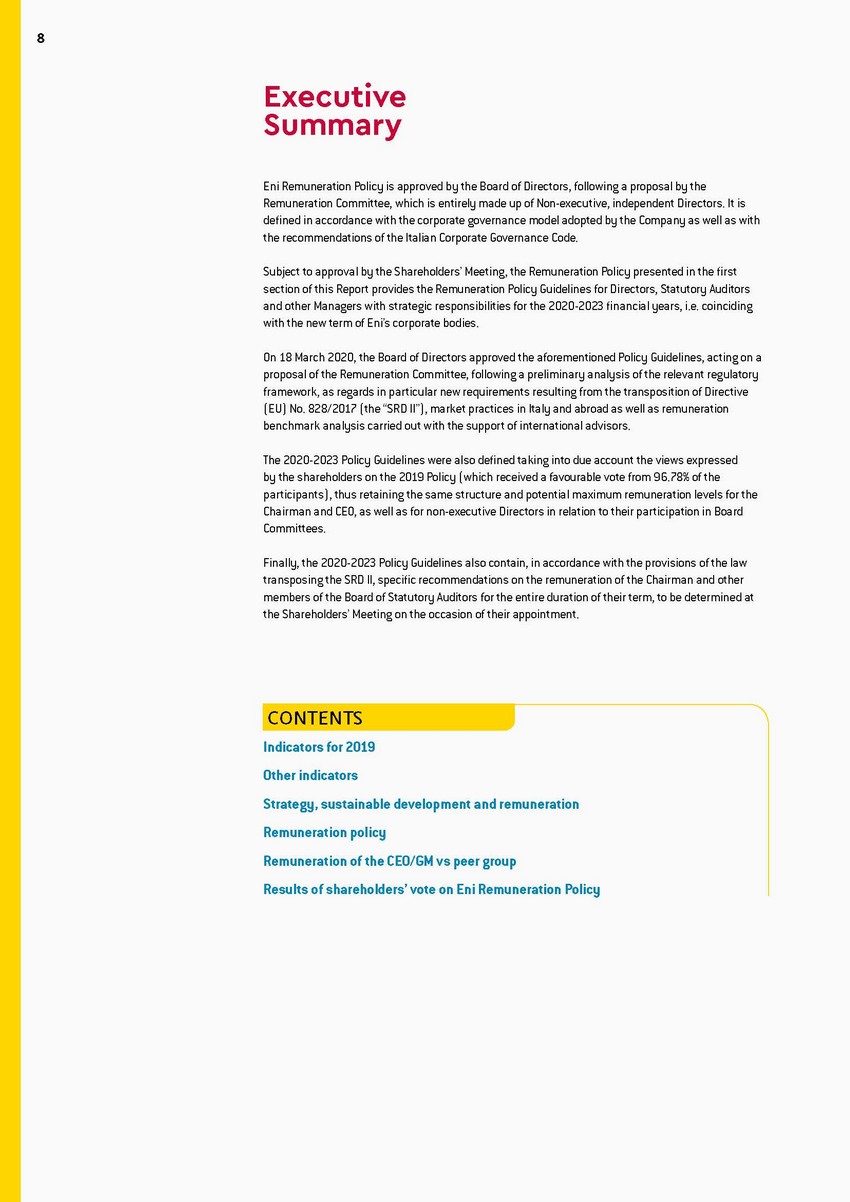 | Executive Summary Eni Remuneration Policy is approved by the Board of Directors, following a proposal by the Remuneration Committee, which is entirely made up of Non-executive, independent Directors. It is defined in accordance with the corporate governance model adopted by the Company as well as with the recommendations of the Italian Corporate Governance Code. Subject to approval by the Shareholders’ Meeting, the Remuneration Policy presented in the first section of this Report provides the Remuneration Policy Guidelines for Directors, Statutory Auditors and other Managers with strategic responsibilities for the 2020-2023 financial years, i.e. coinciding with the new term of Eni’s corporate bodies. On 18 March 2020, the Board of Directors approved the aforementioned Policy Guidelines, acting on a proposal of the Remuneration Committee, following a preliminary analysis of the relevant regulatory framework, as regards in particular new requirements resulting from the transposition of Directive (EU) No. 828/2017 (the “SRD II”), market practices in Italy and abroad as well as remuneration benchmark analysis carried out with the support of international advisors. The 2020-2023 Policy Guidelines were also defined taking into due account the views expressed by the shareholders on the 2019 Policy (which received a favourable vote from 96.78% of the participants), thus retaining the same structure and potential maximum remuneration levels for the Chairman and CEO, as well as for non-executive Directors in relation to their participation in Board Committees. Finally, the 2020-2023 Policy Guidelines also contain, in accordance with the provisions of the law transposing the SRD II, specific recommendations on the remuneration of the Chairman and other members of the Board of Statutory Auditors for the entire duration of their term, to be determined at the Shareholders’ Meeting on the occasion of their appointment. CONTENTS Indicators for 2019 Other indicators Strategy, sustainable development and remuneration Remuneration policy Remuneration of the CEO/GM vs peer group Results of shareholders’ vote on Eni Remuneration Policy |
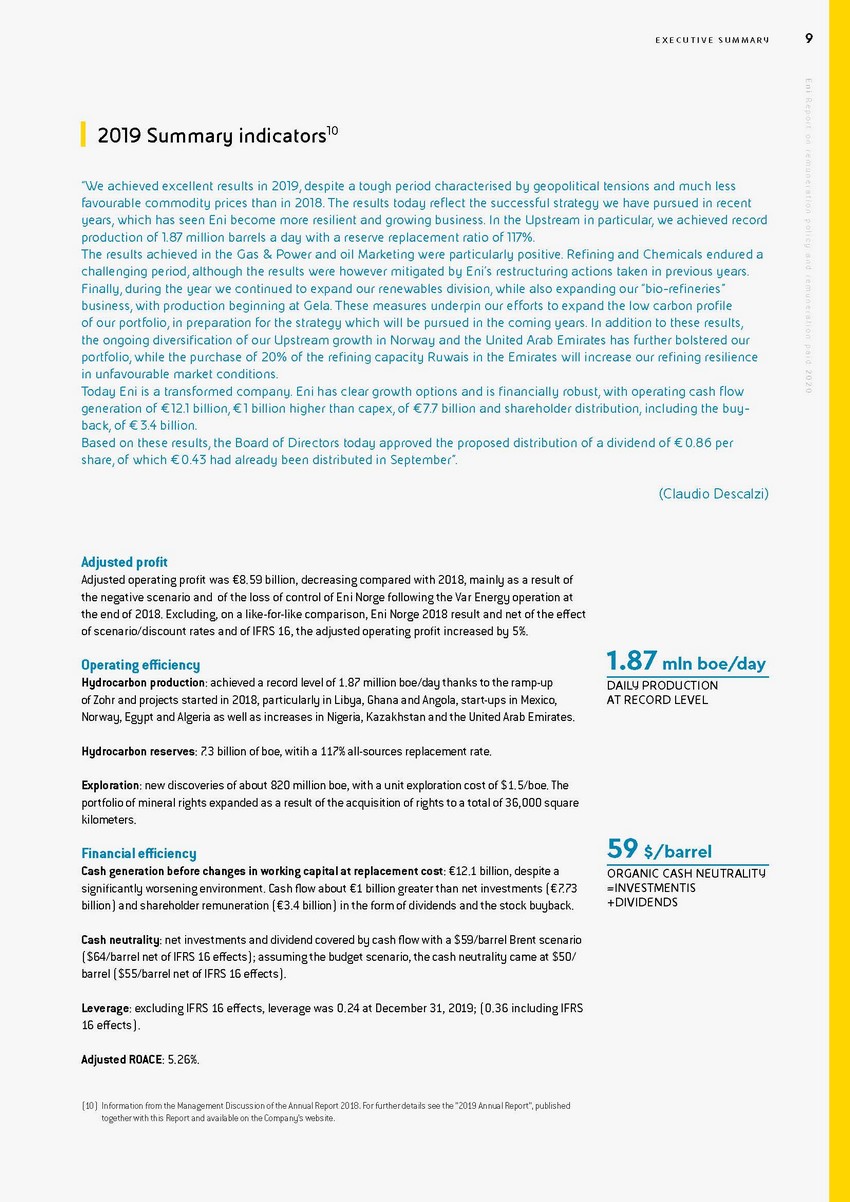 | Eni R eport on r emuner ation policy and r emuner ation paid 20 20 “We achieved excellent results in 2019, despite a tough period characterised by geopolitical tensions and much less favourable commodity prices than in 2018. The results today reflthe successful strategy we have pursued in recent years, which has seen Eni become more resilient and growing business. In the Upstream in particular, we achieved record production of 1.87 million barrels a day with a reserve replacement ratio of 117%. The results achieved in the Gas & Power and oil Marketing were particularly positive. Refiand Chemicals endured a challenging period, although the results were however mitigated by Eni’s restructuring actions taken in previous years. Finally, during the year we continued to expand our renewables division, while also expanding our “bio-refi business, with production beginning at Gela. These measures underpin our efforts to expand the low carbon profi of our portfolio, in preparation for the strategy which will be pursued in the coming years. In addition to these results, the ongoing diversifi ation of our Upstream growth in Norway and the United Arab Emirates has further bolstered our portfolio, while the purchase of 20% of the reficapacity Ruwais in the Emirates will increase our refiresilience in unfavourable market conditions. Today Eni is a transformed company. Eni has clear growth options and is firobust, with operating cash fl w generation of €12.1 billion, €1 billion higher than capex, of €7.7 billion and shareholder distribution, including the buy-back, of €3.4 billion. Based on these results, the Board of Directors today approved the proposed distribution of a dividend of €0.86 per share, of which €0.43 had already been distributed in September”. (Claudio Descalzi) Adjusted profit Adjusted operating profit was €8.59 billion, decreasing compared with 2018, mainly as a result of the negative scenario and of the loss of control of Eni Norge following the Var Energy operation at the end of 2018. Excluding, on a like-for-like comparison, Eni Norge 2018 result and net of the eff ct of scenario/discount rates and of IFRS 16, the adjusted operating profit increased by 5%. Operating efficiency Hydrocarbon production: achieved a record level of 1.87 million boe/day thanks to the ramp-up of Zohr and projects started in 2018, particularly in Libya, Ghana and Angola, start-ups in Mexico, Norway, Egypt and Algeria as well as increases in Nigeria, Kazakhstan and the United Arab Emirates. Hydrocarbon reserves: 7.3 billion of boe, witih a 117% all-sources replacement rate. Exploration: new discoveries of about 820 million boe, with a unit exploration cost of $1.5/boe. The portfolio of mineral rights expanded as a result of the acquisition of rights to a total of 36,000 square kilometers. Financial efficiency Cash generation before changes in working capital at replacement cost: €12.1 billion, despite a significantly worsening environment. Cash flow about €1 billion greater than net investments (€7.73 billion) and shareholder remuneration (€3.4 billion) in the form of dividends and the stock buyback. Cash neutrality: net investments and dividend covered by cash flow with a $59/barrel Brent scenario ($64/barrel net of IFRS 16 effects); assuming the budget scenario, the cash neutrality came at $50/ barrel ($55/barrel net of IFRS 16 effects). Leverage: excluding IFRS 16 eff cts, leverage was 0.24 at December 31, 2019; (0.36 including IFRS 16 eff cts). Adjusted ROACE: 5.26%. Information from the Management Discussion of the Annual Report 2018. For further details see the “2019 Annual Report”, published together with this Report and available on the Company’s website. 1.87 mln boe/day DAILY PRODUCTION AT RECORD LEVEL 59 $/barrel ORGANIC CASH NEUTRALITY =INVESTMENTIS +DIVIDENDS |
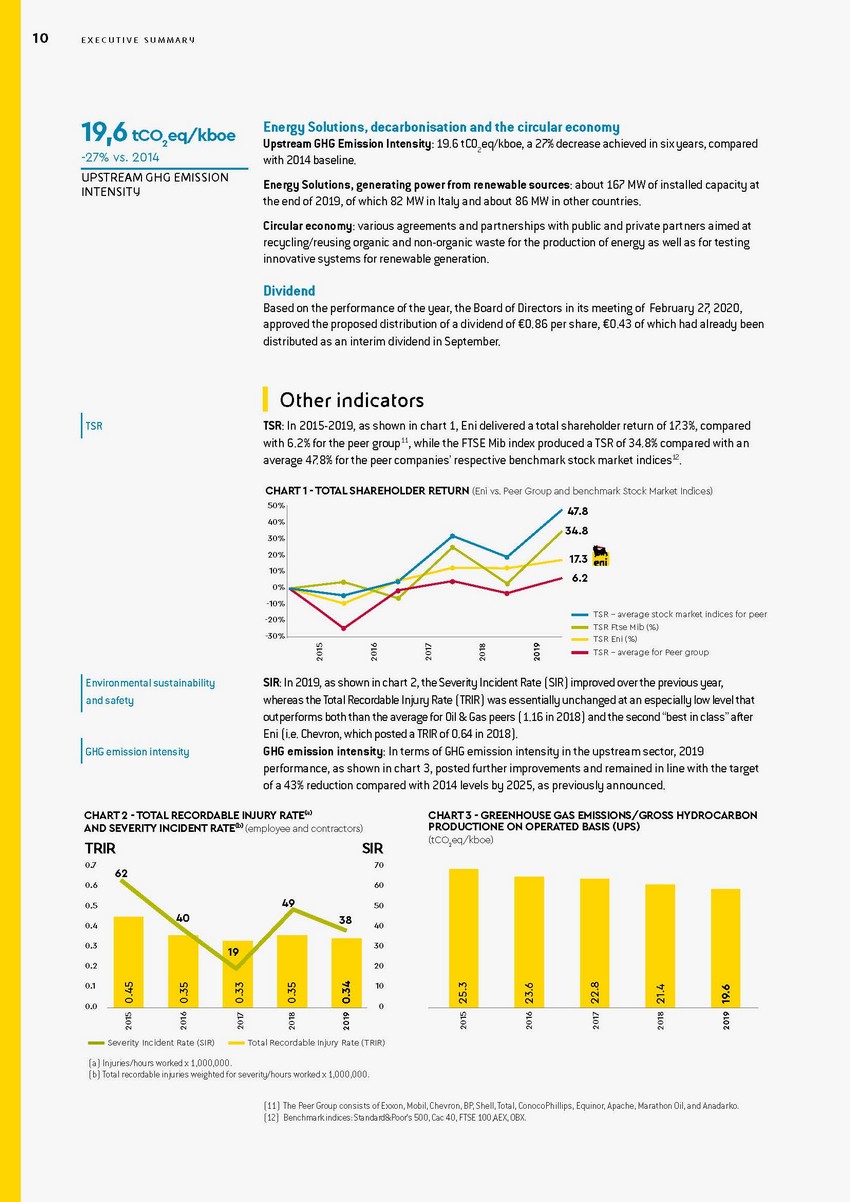 | 10EXE CUTIVE SUMMAR Y 2 -27% vs. 2014 UPSTREAM GHG EMISSION INTENSITY Energy Solutions, decarbonisation and the circular economy Upstream GHG Emission Intensity: 19.6 tCO2eq/kboe, a 27% decrease achieved in six years, compared with 2014 baseline. Energy Solutions, generating power from renewable sources: about 167 MW of installed capacity at the end of 2019, of which 82 MW in Italy and about 86 MW in other countries. Circular economy: various agreements and partnerships with public and private partners aimed at recycling/reusing organic and non-organic waste for the production of energy as well as for testing innovative systems for renewable generation. Dividend Based on the performance of the year, the Board of Directors in its meeting of February 27, 2020, approved the proposed distribution of a dividend of €0.86 per share, €0.43 of which had already been distributed as an interim dividend in September. TSR Other indicators TSR: In 2015-2019, as shown in chart 1, Eni delivered a total shareholder return of 17.3%, compared with 6.2% for the peer group11, while the FTSE Mib index produced a TSR of 34.8% compared with an average 47.8% for the peer companies’ respective benchmark stock market indices12. CHART 1 - TOTAL SHAREHOLDER RETURN (Eni vs. Peer Group and benchmark Stock Market Indices) 50% 40% 30% 20% 10% 0% -10% -20% 2015 2016 2017 2018 2019 47.8 34.8 17.3 6.2 TSR – average stock market indices for peer TSR Ftse Mib (%) TSR Eni (%) TSR – average for Peer group Environmental sustainability and safety GHG emission intensity SIR: In 2019, as shown in chart 2, the Severity Incident Rate (SIR) improved over the previous year, whereas the Total Recordable Injury Rate (TRIR) was essentially unchanged at an especially low level that outperforms both than the average for Oil & Gas peers (1.16 in 2018) and the second “best in class” after Eni (i.e. Chevron, which posted a TRIR of 0.64 in 2018). GHG emission intensity: In terms of GHG emission intensity in the upstream sector, 2019 performance, as shown in chart 3, posted further improvements and remained in line with the target of a 43% reduction compared with 2014 levels by 2025, as previously announced. CHART 2 - TOTAL RECORDABLE INJURY RATE(a) AND SEVERITY INCIDENT RATE(b) (employee and contractors) TRIRSIR CHART 3 - GREENHOUSE GAS EMISSIONS/GROSS HYDROCARBON PRODUCTIONE ON OPERATED BASIS (UPS) 2 19 62 49 40 38 0.660 0.550 0.440 0.330 0.220 0.45 0.35 0.33 0.35 0.34 25.3 23.6 22.8 21.4 19.6 2015 2016 2017 2018 2019 2015 2016 2017 2018 2019 Severity Incident Rate (SIR)Total Recordable Injury Rate (TRIR) Injuries/hours worked x 1,000,000. Total recordable injuries weighted for severity/hours worked x 1,000,000. The Peer Group consists of Exxon, Mobil, Chevron, BP, Shell, Total, ConocoPhillips, Equinor, Apache, Marathon Oil, and Anadarko. Benchmark indices: Standard&Poor's 500, Cac 40, FTSE 100,AEX, OBX. |
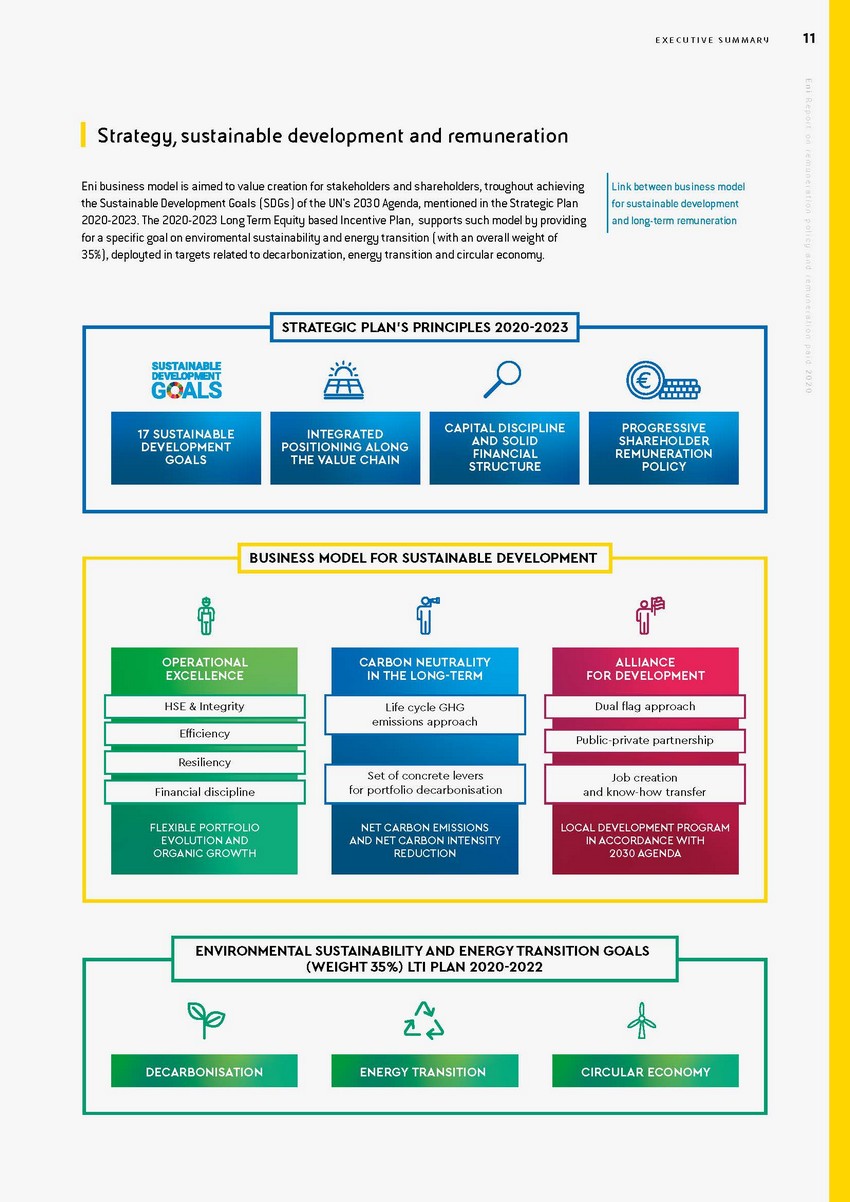 | Eni R eport on r emuner ation policy and r emuner ation paid 20 20 Eni business model is aimed to value creation for stakeholders and shareholders, troughout achieving the Sustainable Development Goals (SDGs) of the UN's 2030 Agenda, mentioned in the Strategic Plan 2020-2023. The 2020-2023 Long Term Equity based Incentive Plan, supports such model by providing for a specific goal on enviromental sustainability and energy transition (with an overall weight of 35%), deployted in targets related to decarbonization, energy transition and circular economy. Link between business model for sustainable development and long-term remuneration Life cycle GHG emissions approach Dual flag approach Public-private partnership Resiliency Set of concrete levers for portfolio decarbonisation Job creation and know-how transfer Financial discipline OPERATIONALCARBON NEUTRALITYALLIANCE EXCELLENCEIN THE LONG-TERMFOR DEVELOPMENT FLEXIBLE PORTFOLIONET CARBON EMISSIONSLOCAL DEVELOPMENT PROGRAM EVOLUTION ANDAND NET CARBON INTENSITYIN ACCORDANCE WITH ORGANIC GROWTHREDUCTION2030 AGENDA BUSINESS MODEL FOR SUSTAINABLE DEVELOPMENT STRATEGIC PLAN’S PRINCIPLES 2020-2023 17 SUSTAINABLE DEVELOPMENT GOALS INTEGRATED POSITIONING ALONG THE VALUE CHAIN CAPITAL DISCIPLINE AND SOLID FINANCIAL STRUCTURE PROGRESSIVE SHAREHOLDER REMUNERATION POLICY ENVIRONMENTAL SUSTAINABILITY AND ENERGY TRANSITION GOALS DECARBONISATIONENERGY TRANSITIONCIRCULAR ECONOMY (WEIGHT 35%) LTI PLAN 2020-2022 |
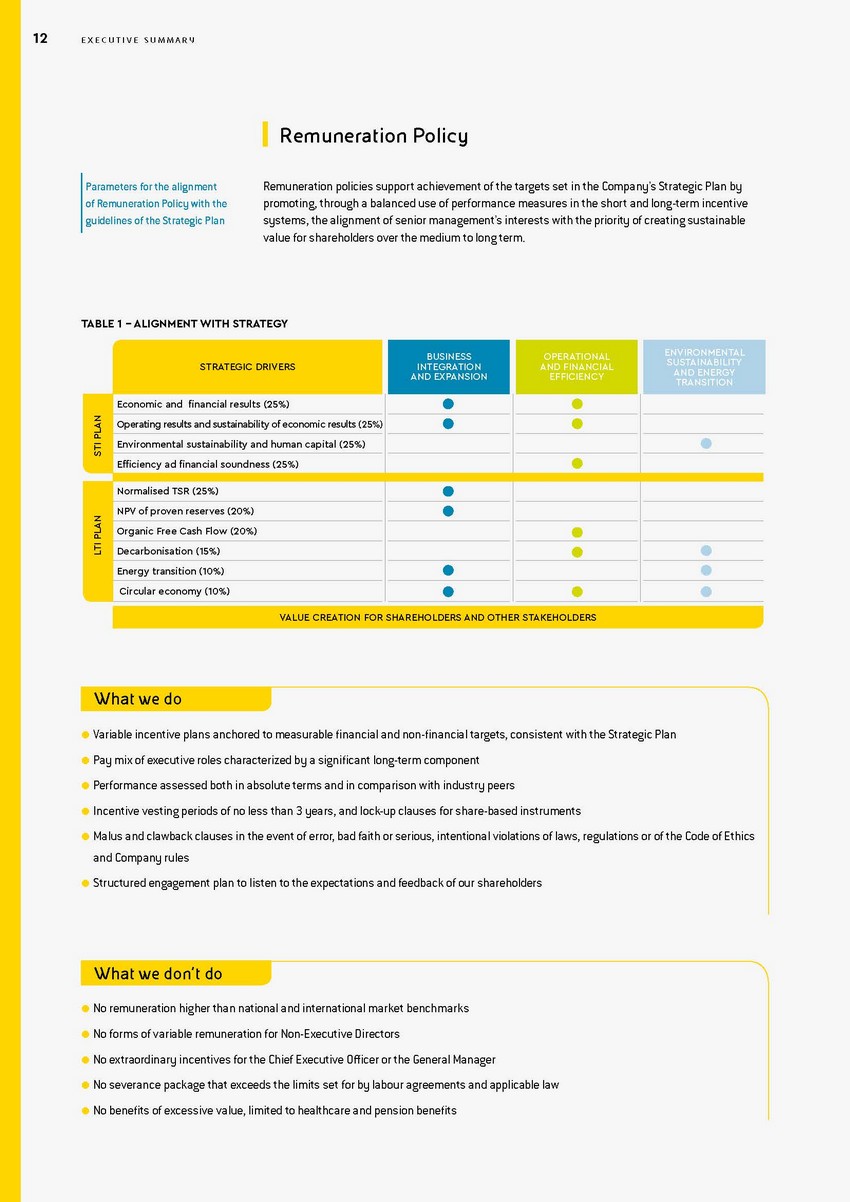 | 12EXE CUTIVE SUMMAR Y Remuneration Policy Parameters for the alignment of Remuneration Policy with the guidelines of the Strategic Plan Remuneration policies support achievement of the targets set in the Company’s Strategic Plan by promoting, through a balanced use of performance measures in the short and long-term incentive systems, the alignment of senior management’s interests with the priority of creating sustainable value for shareholders over the medium to long term. LTI PLAN ENVIRONMENTAL SUSTAINABILITY AND ENERGY TRANSITION STRATEGIC DRIVERS BUSINESS INTEGRATION AND EXPANSION OPERATIONAL AND FINANCIAL EFFICIENCY Economic and financial results (25%) Operating results and sustainability of economic results (25%) Environmental sustainability and human capital (25%) Efficiency ad financial soundness (25%) Normalised TSR (25%) NPV of proven reserves (20%) Organic Free Cash Flow (20%) Decarbonisation (15%) Energy transition (10%) Circular economy (10%) VALUE CREATION FOR SHAREHOLDERS AND OTHER STAKEHOLDERS STI PLAN What we do Variable incentive plans anchored to measurable financial and non-financial targets, consistent with the Strategic Plan Pay mix of executive roles characterized by a significant long-term component Performance assessed both in absolute terms and in comparison with industry peers Incentive vesting periods of no less than 3 years, and lock-up clauses for share-based instruments Malus and clawback clauses in the event of error, bad faith or serious, intentional violations of laws, regulations or of the Code of Ethics and Company rules Structured engagement plan to listen to the expectations and feedback of our shareholders What we don’t do No remuneration higher than national and international market benchmarks No forms of variable remuneration for Non-Executive Directors No extraordinary incentives for the Chief Executive Officer or the General Manager No severance package that exceeds the limits set for by labour agreements and applicable law No benefits of excessive value, limited to healthcare and pension benefits |
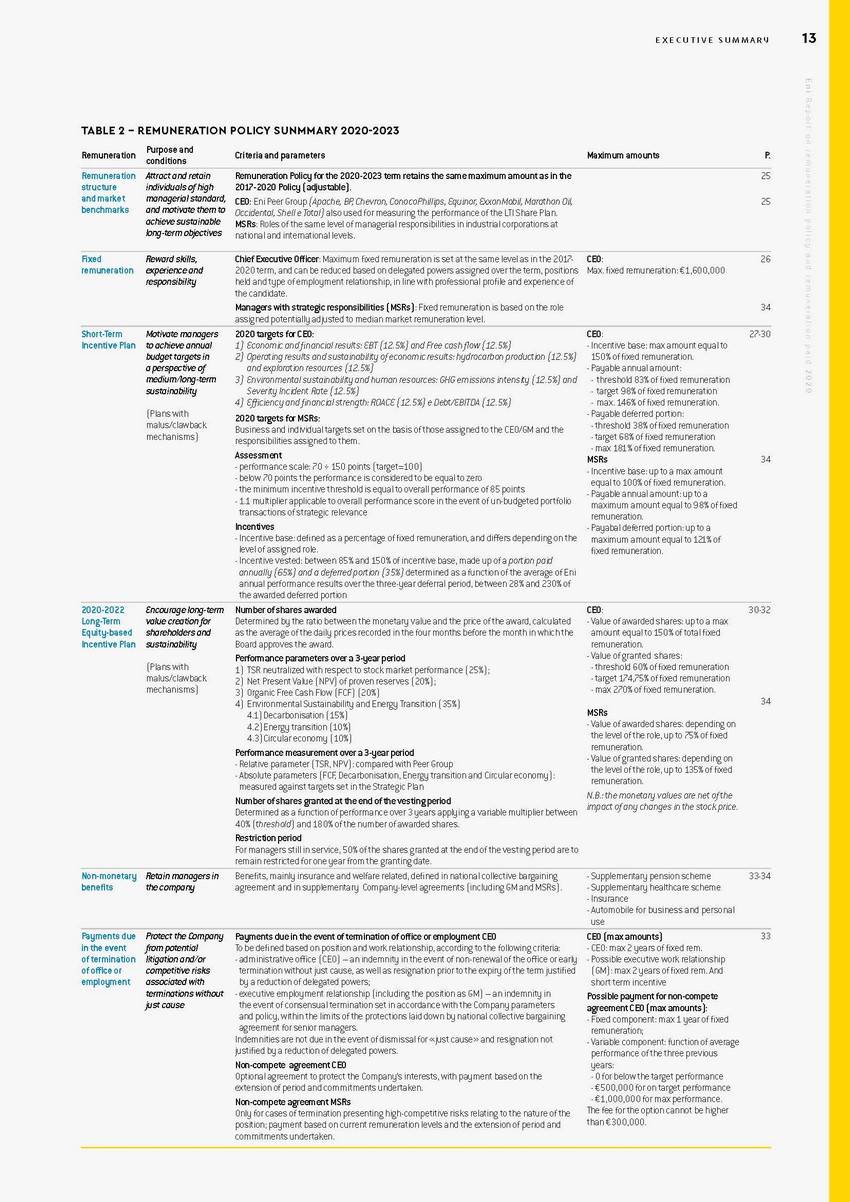 | Eni R eport on r emuner ation policy and r emuner ation paid 20 20 2020-2022 Long-Term Equity-based Incentive Plan Non-monetary benefits Payments due in the event of termination of offi e or employment (Plans with malus/clawback mechanisms) Encourage long-term value creation for shareholders and sustainability (Plans with malus/clawback mechanisms) Retain managers in the company Protect the Company from potential litigation and/or competitive risks associated with terminations without just cause 2020 targets for MSRs: Business and individual targets set on the basis of those assigned to the CEO/GM and the responsibilities assigned to them. Assessment - performance scale: 70 ÷ 150 points (target=100) - below 70 points the performance is considered to be equal to zero - the minimum incentive threshold is equal to overall performance of 85 points - 1.1 multiplier applicable to overall performance score in the event of un-budgeted portfolio transactions of strategic relevance Incentives - Incentive base: defi ed as a percentage of fi ed remuneration, and diff rs depending on the level of assigned role. - Incentive vested: between 85% and 150% of incentive base, made up of a portion paid annually (65%) andadeferred portion (35%) determined as a function of the average of Eni annual performance results over the three-year deferral period, between 28% and 230% of the awarded deferred portion Number of shares awarded Determined by the ratio between the monetary value and the price of the award, calculated as the average of the daily prices recorded in the four months before the month in which the Board approves the award. Performance parameters over a 3-year period TSR neutralized with respect to stock market performance (25%); Net Present Value (NPV) of proven reserves (20%); Organic Free Cash Flow (FCF) (20%) Environmental Sustainability and Energy Transition (35%) 4.1)Decarbonisation (15%) Energy transition (10%) Circular economy (10%) Performance measurement over a 3-year period - Relative parameter (TSR, NPV): compared with Peer Group - Absolute parameters (FCF, Decarbonisation, Energy transition and Circular economy): measured against targets set in the Strategic Plan Number of shares granted at the end of the vesting period Determined as a function of performance over 3 years applying a variable multiplier between 40% (threshold) and 180% of the number of awarded shares. Restriction period For managers still in service, 50% of the shares granted at the end of the vesting period are to remain restricted for one year from the granting date. Benefits, mainly insurance and welfare related, defi ed in national collective bargaining agreement and in supplementary Company-level agreements (including GM and MSRs). Payments due in the event of termination of offi e or employment CEO To be defi ed based on position and work relationship, according to the following criteria: - administrative offi e (CEO) – an indemnity in the event of non-renewal of the offi e or early termination without just cause, as well as resignation prior to the expiry of the term justified by a reduction of delegated powers; - executive employment relationship (including the position as GM) – an indemnity in the event of consensual termination set in accordance with the Company parameters and policy, within the limits of the protections laid down by national collective bargaining agreement for senior managers. Indemnities are not due in the event of dismissal for «just cause» and resignation not justified by a reduction of delegated powers. Non-compete agreement CEO Optional agreement to protect the Company’s interests, with payment based on the extension of period and commitments undertaken. Non-compete agreement MSRs Only for cases of termination presenting high-competitive risks relating to the nature of the position; payment based on current remuneration levels and the extension of period and commitments undertaken. - Payable deferred portion: - threshold 38% of fi ed remuneration - target 68% of fi ed remuneration - max 181% of fi ed remuneration. MSRs - Incentive base: up to a max amount equal to 100% of fi ed remuneration. - Payable annual amount: up to a maximum amount equal to 98% of fi ed remuneration. - Payabal deferred portion: up to a maximum amount equal to 121% of fi ed remuneration. CEO: - Value of awarded shares: up to a max amount equal to 150% of total fi ed remuneration. - Value of granted shares: - threshold 60% of fi ed remuneration - target 174,75% of fi ed remuneration - max 270% of fi ed remuneration. MSRs - Value of awarded shares: depending on the level of the role, up to 75% of fi ed remuneration. - Value of granted shares: depending on the level of the role, up to 135% of fi ed remuneration. .: themonetary values are net of the impact of anychanges in the stock price. - Supplementary pension scheme - Supplementary healthcare scheme - Insurance - Automobile for business and personal use CEO (max amounts) - CEO: max 2 years of fi ed rem. - Possible executive work relationship (GM): max 2 years of fi ed rem. And short term incentive Possible payment for non-compete agreement CEO (max amounts): - Fixed component: max 1 year of fi ed remuneration; - Variable component: function of average performance of the three previous years: - 0 for below the target performance - €500,000 for on target performance - €1,000,000 for max performance. The fee for the option cannot be higher than €300,000. 34 30-32 34 33-34 33 |
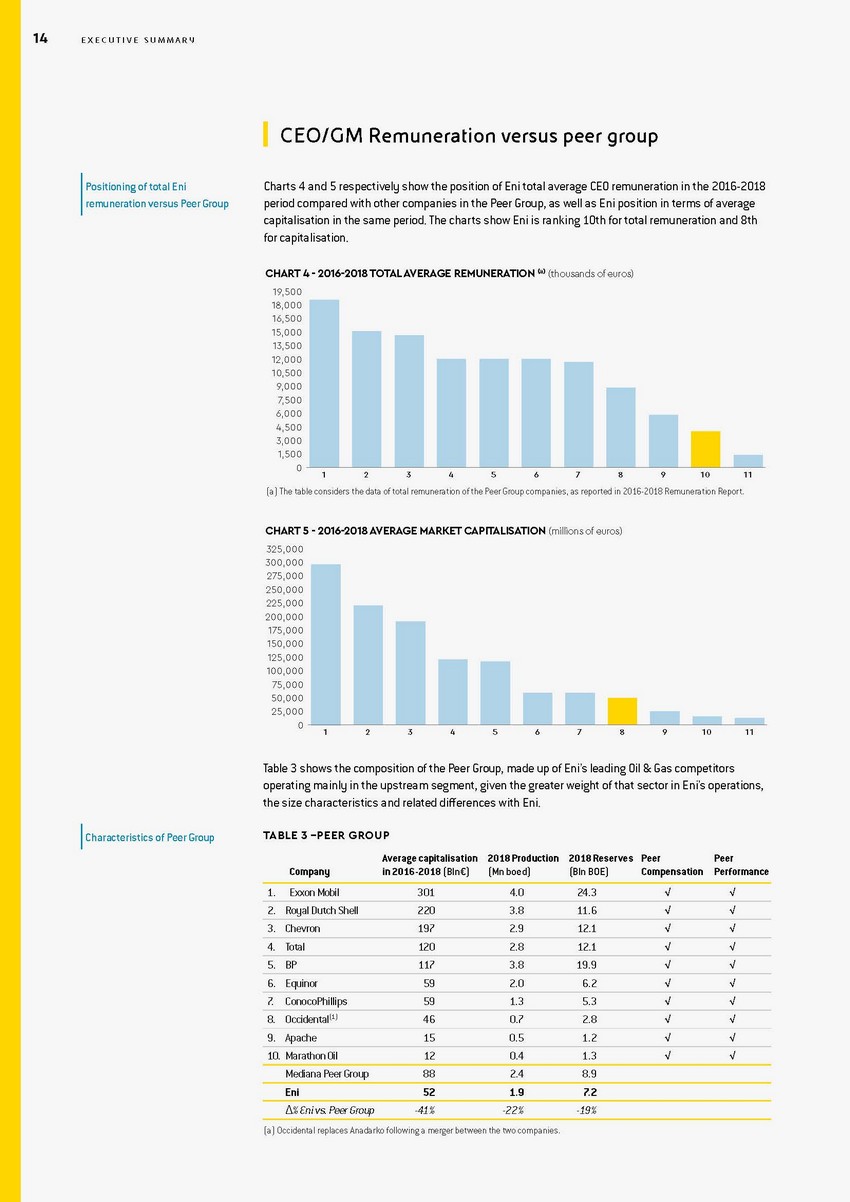 | 14EXE CUTIVE SUMMAR Y CEO/GM Remuneration versus peer group Positioning of total Eni remuneration versus Peer Group Charts 4 and 5 respectively show the position of Eni total average CEO remuneration in the 2016-2018 period compared with other companies in the Peer Group, as well as Eni position in terms of average capitalisation in the same period. The charts show Eni is ranking 10th for total remuneration and 8th for capitalisation. CHART 4 - 2016-2018 TOTAL AVERAGE REMUNERATION (a) (thousands of euros) 19,500 18,000 16,500 15,000 13,500 12,000 10,500 9,000 7,500 6,000 4,500 3,000 1,500 0 1234567891011 The table considers the data of total remuneration of the Peer Group companies, as reported in 2016-2018 Remuneration Report. CHART 5 - 2016-2018 AVERAGE MARKET CAPITALISATION (millions of euros) 325,000 300,000 275,000 250,000 225,000 200,000 175,000 150,000 125,000 100,000 75,000 50,000 25,000 0 1234567891011 Table 3 shows the composition of the Peer Group, made up of Eni’s leading Oil & Gas competitors operating mainly in the upstream segment, given the greater weight of that sector in Eni’s operations, the size characteristics and related differences with Eni. Characteristics of Peer Group TABLE 3 –PEER GROUP (a) Occidental replaces Anadarko following a merger between the two companies. |
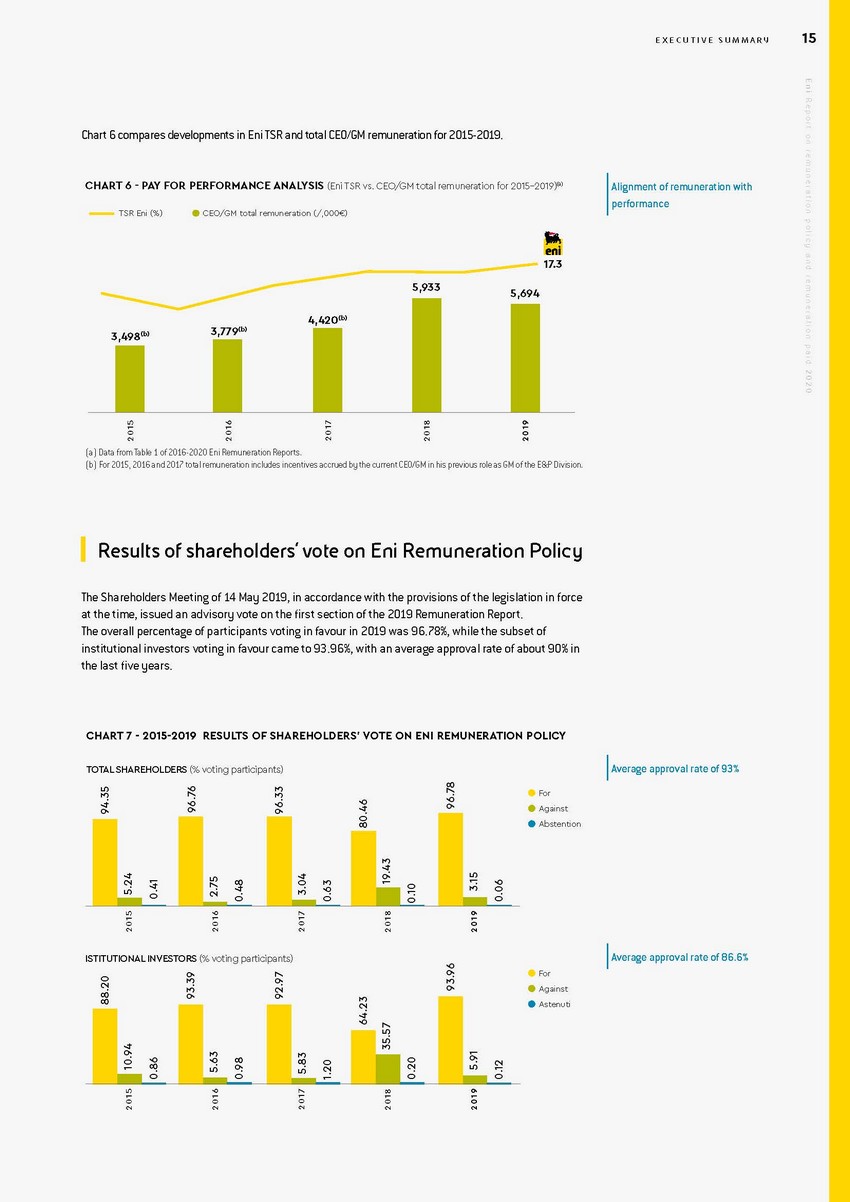 | EXE CUTIVE SUMMAR Y15 Eni R eport on r emuner ation policy and r emuner ation paid 20 20 CHART 6 - PAY FOR PERFORMANCE ANALYSIS (Eni TSR vs. CEO/GM total remuneration for 2015–2019)(a)Alignment of remuneration with performance TSR Eni (%)CEO/GM total remuneration (/,000€) 17.3 5,933 5,694 4,420(b) 3,498(b) 3,779(b) 2015 2016 2017 2018 2019 For 2015, 2016 and 2017 total remuneration includes incentives accrued by the current CEO/GM in his previous role as GM of the E&P Division. Results of shareholders’ vote on Eni Remuneration Policy The Shareholders Meeting of 14 May 2019, in accordance with the provisions of the legislation in force at the time, issued an advisory vote on the first section of the 2019 Remuneration Report. The overall percentage of participants voting in favour in 2019 was 96.78%, while the subset of institutional investors voting in favour came to 93.96%, with an average approval rate of about 90% in the last five years. CHART 7 - 2015-2019 RESULTS OF SHAREHOLDERS’ VOTE ON ENI REMUNERATION POLICY TOTAL SHAREHOLDERS (% voting participants) Average approval rate of 93% 94.35 5.24 96.76 2.75 96.33 3.04 80.46 19.43 93.96 96.78 88.20 2015 0.41 93.39 2016 0.48 92.97 2017 0.63 64.23 2018 0.10 20193.15 0.06 201510.94 0.86 20165.63 0.98 5.83 2017 1.20 35.57 2018 0.20 20195.91 0.12 Average approval rate of 86.6% |
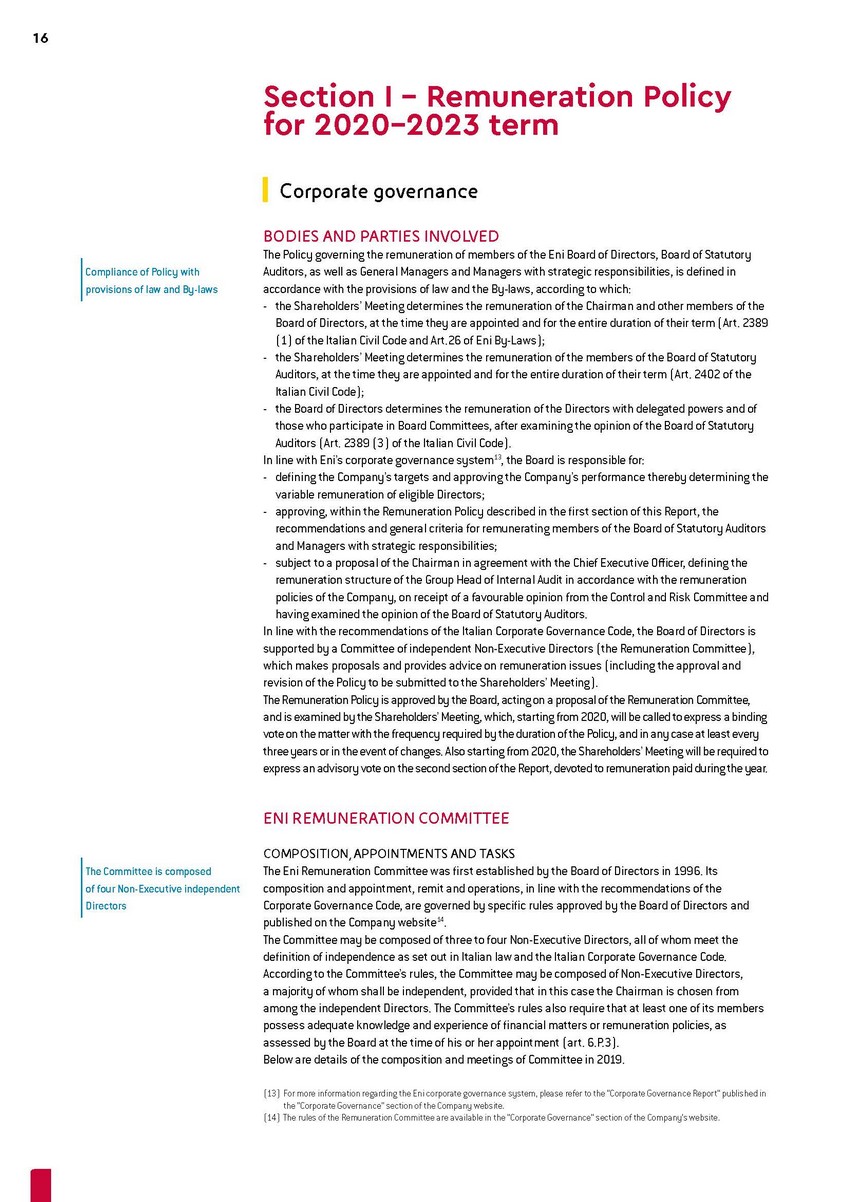 | Section I – Remuneration Policy for 2020–2023 term Corporate governance Compliance of Policy with provisions of law and By-laws The Committee is composed of four Non-Executive independent Directors BODIES AND PARTIES INVOLVED The Policy governing the remuneration of members of the Eni Board of Directors, Board of Statutory Auditors, as well as General Managers and Managers with strategic responsibilities, is defined in accordance with the provisions of law and the By-laws, according to which: the Shareholders’ Meeting determines the remuneration of the Chairman and other members of the Board of Directors, at the time they are appointed and for the entire duration of their term (Art. 2389 of the Italian Civil Code and Art.26 of Eni By-Laws); the Shareholders’ Meeting determines the remuneration of the members of the Board of Statutory Auditors, at the time they are appointed and for the entire duration of their term (Art. 2402 of the Italian Civil Code); the Board of Directors determines the remuneration of the Directors with delegated powers and of those who participate in Board Committees, after examining the opinion of the Board of Statutory Auditors (Art. 2389 (3) of the Italian Civil Code). In line with Eni’s corporate governance system13, the Board is responsible for: defining the Company’s targets and approving the Company’s performance thereby determining the variable remuneration of eligible Directors; approving, within the Remuneration Policy described in the first section of this Report, the recommendations and general criteria for remunerating members of the Board of Statutory Auditors and Managers with strategic responsibilities; subject to a proposal of the Chairman in agreement with the Chief Executive Officer, defining the remuneration structure of the Group Head of Internal Audit in accordance with the remuneration policies of the Company, on receipt of a favourable opinion from the Control and Risk Committee and having examined the opinion of the Board of Statutory Auditors. In line with the recommendations of the Italian Corporate Governance Code, the Board of Directors is supported by a Committee of independent Non-Executive Directors (the Remuneration Committee), which makes proposals and provides advice on remuneration issues (including the approval and revision of the Policy to be submitted to the Shareholders’ Meeting). The Remuneration Policy is approved by the Board, acting on a proposal of the Remuneration Committee, and is examined by the Shareholders’ Meeting, which, starting from 2020, will be called to express a binding vote on the matter with the frequency required by the duration of the Policy, and in any case at least every three years or in the event of changes. Also starting from 2020, the Shareholders’ Meeting will be required to express an advisory vote on the second section of the Report, devoted to remuneration paid during the year. ENI REMUNERATION COMMITTEE COMPOSITION, APPOINTMENTS AND TASKS The Eni Remuneration Committee was first established by the Board of Directors in 1996. Its composition and appointment, remit and operations, in line with the recommendations of the Corporate Governance Code, are governed by specific rules approved by the Board of Directors and published on the Company website14. The Committee may be composed of three to four Non-Executive Directors, all of whom meet the definition of independence as set out in Italian law and the Italian Corporate Governance Code. According to the Committee’s rules, the Committee may be composed of Non-Executive Directors, a majority of whom shall be independent, provided that in this case the Chairman is chosen from among the independent Directors. The Committee’s rules also require that at least one of its members possess adequate knowledge and experience of financial matters or remuneration policies, as assessed by the Board at the time of his or her appointment (art. 6.P.3). Below are details of the composition and meetings of Committee in 2019. For more information regarding the Eni corporate governance system, please refer to the “Corporate Governance Report” published in the “Corporate Governance” section of the Company website. The rules of the Remuneration Committee are available in the “Corporate Governance” section of the Company’s website. |
 | Eni R eport on r emuner ation policy and r emuner ation paid 20 20 Andrea Gemma (Chairman) Pietro A. Guindani(b) Alessandro Lorenzi(b) 10meetings in 2019* Average duration: 2hand 10minuti Diva Moriani Composition following renewal of corporate bodies (Board of Directors’ decision of 13 April 2017 as announced in the press release of the same date). The Committee is entirely composed of Non-Executive independent Directors, pursuant to law and Corporate Governance Code. Directors Guindani and Lorenzi have been appointed from the minority slate. (*) As per the Board of Directors’ decision of 25 July 2019, the meetings held on 9 October and 7 November were chaired by Director Lorenzi. The Chief Services & Stakeholder Relations Officer of Eni or, on his behalf, the Executive Vice President Compensation & Benefits, acts as Secretary to the Committee. The Secretary assists the Committee and its Chairman in the performance of their activities, with the support of the competent Compensation & Benefit units. In line with the recommendations of the Italian Corporate Governance Code (Art. 6.P.4 and Art. 6.C.5), the Committee performs the following advisory functions for the Board of Directors: submits the Remuneration Report and in particular the Remuneration Policy for Directors and Managers with strategic responsibilities to the Board of Directors for approval, prior to its presentation at the Shareholders’ Meeting called to approve the year’s financial statements, in accordance with the time limits set by applicable law; periodically evaluates the adequacy, overall consistency and effective implementation of the Policy, formulating proposals as appropriate for approval by the Board of Directors; presents proposals for the remuneration of the Chairman and the Chief Executive Officer, including the various components of compensation and benefits; presents proposals for the remuneration of Board Committee members; having examined the Chief Executive Officer’s input, proposes general criteria for the compensation of Managers with strategic responsibilities, the annual and Long-Term incentive plans, including equity-based plans, sets performance objectives and assesses performance against them, thereby determining the variable awards due to Executive Directors pursuant to the implementation of the approved incentive plans; monitors execution of decisions taken by the Board; reports at the first available meeting of the Board of Directors through the Committee Chairman on the most significant issues addressed by the Committee during the meetings. It also reports to the Board on its activities at least every six months and no later than the time limit for the approval of the Annual Report and the Interim Report at 30 June, at the Board meeting designated by the Chairman of the Board of Directors. Furthermore, in exercising its functions, the Committee may issue opinions as required by Company procedures in relation to operations with related parties, in accordance with specified procedures. OPERATING PROCEDURES The Committee meets as often as necessary to fulfi its functions, usually on the dates established in the annual meeting schedule approved by the Committee itself, and in the presence of at least the majority of its current members. The Chairman of the Committee calls and chairs the meetings; in case of absence or impediment, the meeting is chaired by the oldest attending member. The Committee decides with an absolute majority of those present; in the case of tied votes, the Committee Chairman has a casting vote. The Committee Secretary, who may be assisted in this function by the Executive Vice President Compensation & Benefits, produces the minutes of the meetings. The Chairman of the Board of Statutory Auditors (or another Statutory Auditor appointed by said Chairman) may attend the meetings of the Committee; other Statutory Auditors may also participate. Meetings may be attended, at the invitation of the Chairman of the Committee acting on behalf the Committee, by the Chairman of the Board of Directors and the Chief Executive Officer; the meetings may also be attended by Managers of the Company or other persons, including other members of the Board of Directors, to provide information and feedback on individual agenda items. Advisory functions of the Remuneration Committee Minutes of meetings and participation of Statutory Auditors in Committee meetings |
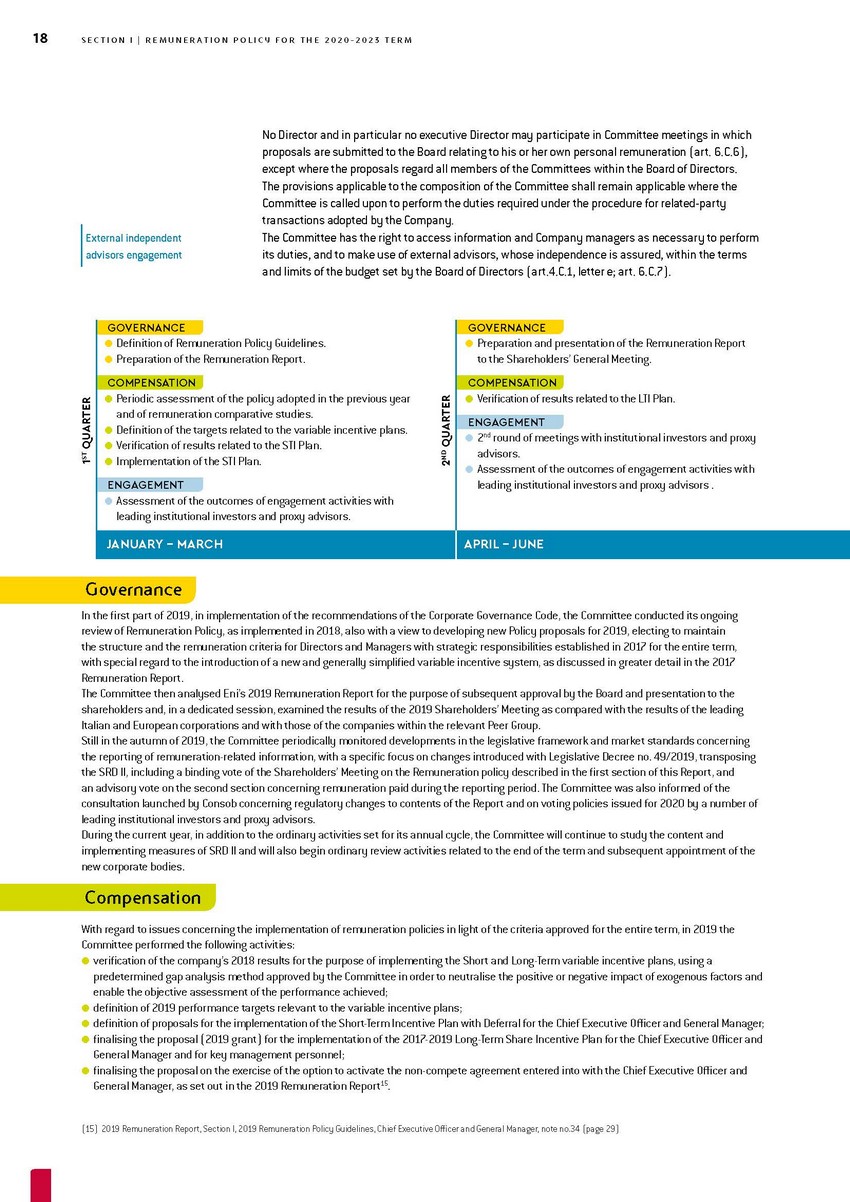 | External independent advisors engagement No Director and in particular no executive Director may participate in Committee meetings in which proposals are submitted to the Board relating to his or her own personal remuneration (art. 6.C.6), except where the proposals regard all members of the Committees within the Board of Directors. The provisions applicable to the composition of the Committee shall remain applicable where the Committee is called upon to perform the duties required under the procedure for related-party transactions adopted by the Company. The Committee has the right to access information and Company managers as necessary to perform its duties, and to make use of external advisors, whose independence is assured, within the terms and limits of the budget set by the Board of Directors (art.4.C.1, letter e; art. 6.C.7). 1ST QUARTER 2ND QUARTER GOVERNANCE Definition of Remuneration Policy Guidelines. Preparation of the Remuneration Report. COMPENSATION Periodic assessment of the policy adopted in the previous year and of remuneration comparative studies. Definition of the targets related to the variable incentive plans. Verification of results related to the STI Plan. Implementation of the STI Plan. ENGAGEMENT Assessment of the outcomes of engagement activities with leading institutional investors and proxy advisors. GOVERNANCE Preparation and presentation of the Remuneration Report to the Shareholders’ General Meeting. COMPENSATION Verification of results related to the LTI Plan. ENGAGEMENT 2nd round of meetings with institutional investors and proxy advisors. Assessment of the outcomes of engagement activities with leading institutional investors and proxy advisors . JANUARY – MARCH APRIL – JUNE In the first part of 2019, in implementation of the recommendations of the Corporate Governance Code, the Committee conducted its ongoing review of Remuneration Policy, as implemented in 2018, also with a view to developing new Policy proposals for 2019, electing to maintain the structure and the remuneration criteria for Directors and Managers with strategic responsibilities established in 2017 for the entire term, with special regard to the introduction of a new and generally simplified variable incentive system, as discussed in greater detail in the 2017 Remuneration Report. The Committee then analysed Eni’s 2019 Remuneration Report for the purpose of subsequent approval by the Board and presentation to the shareholders and, in a dedicated session, examined the results of the 2019 Shareholders’ Meeting as compared with the results of the leading Italian and European corporations and with those of the companies within the relevant Peer Group. Still in the autumn of 2019, the Committee periodically monitored developments in the legislative framework and market standards concerning the reporting of remuneration-related information, with a specific focus on changes introduced with Legislative Decree no. 49/2019, transposing the SRD II, including a binding vote of the Shareholders’ Meeting on the Remuneration policy described in the first section of this Report, and an advisory vote on the second section concerning remuneration paid during the reporting period. The Committee was also informed of the consultation launched by Consob concerning regulatory changes to contents of the Report and on voting policies issued for 2020 by a number of leading institutional investors and proxy advisors. During the current year, in addition to the ordinary activities set for its annual cycle, the Committee will continue to study the content and implementing measures of SRD II and will also begin ordinary review activities related to the end of the term and subsequent appointment of the new corporate bodies. Compensation With regard to issues concerning the implementation of remuneration policies in light of the criteria approved for the entire term, in 2019 the Committee performed the following activities: verification of the company’s 2018 results for the purpose of implementing the Short and Long-Term variable incentive plans, using a predetermined gap analysis method approved by the Committee in order to neutralise the positive or negative impact of exogenous factors and enable the objective assessment of the performance achieved; definition of 2019 performance targets relevant to the variable incentive plans; definition of proposals for the implementation of the Short-Term Incentive Plan with Deferral for the Chief Executive Officer and General Manager; finalising the proposal (2019 grant) for the implementation of the 2017-2019 Long-Term Share Incentive Plan for the Chief Executive Officer and General Manager and for key management personnel; finalising the proposal on the exercise of the option to activate the non-compete agreement entered into with the Chief Executive Officer and General Manager, as set out in the 2019 Remuneration Report15. 2019 Remuneration Report, Section I, 2019 Remuneration Policy Guidelines, Chief Executive Officer and General Manager, note no.34 (page 29) |
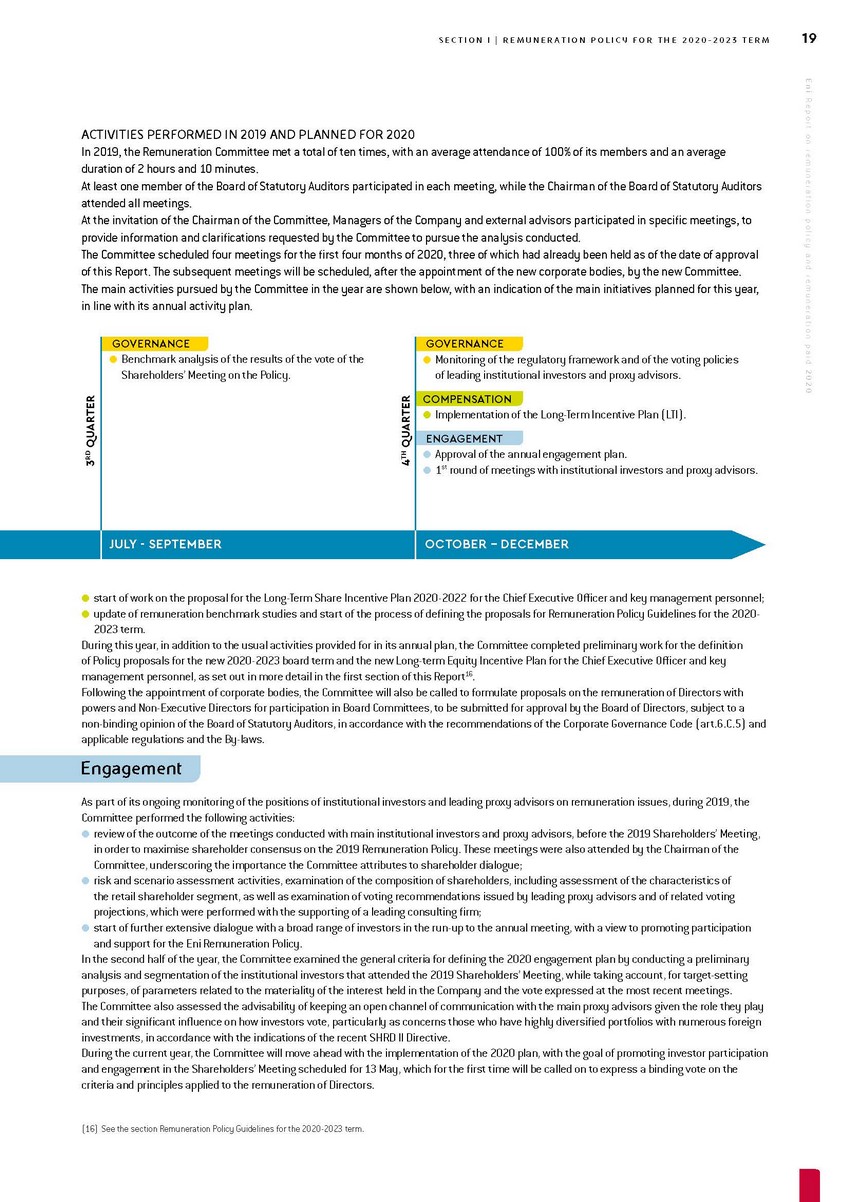 | Eni R eport on r emuner ation policy and r emuner ation paid 20 20 In 2019, the Remuneration Committee met a total of ten times, with an average attendance of 100% of its members and an average duration of 2 hours and 10 minutes. At least one member of the Board of Statutory Auditors participated in each meeting, while the Chairman of the Board of Statutory Auditors attended all meetings. At the invitation of the Chairman of the Committee, Managers of the Company and external advisors participated in specific meetings, to provide information and clarifications requested by the Committee to pursue the analysis conducted. The Committee scheduled four meetings for the first four months of 2020, three of which had already been held as of the date of approval of this Report. The subsequent meetings will be scheduled, after the appointment of the new corporate bodies, by the new Committee. GOVERNANCE Benchmark analysis of the results of the vote of the Shareholders’ Meeting on the Policy. GOVERNANCE Monitoring of the regulatory framework and of the voting policies of leading institutional investors and proxy advisors. COMPENSATION Implementation of the Long-Term Incentive Plan (LTI). ENGAGEMENT Approval of the annual engagement plan. 1st round of meetings with institutional investors and proxy advisors. JULY - SEPTEMBER OCTOBER – DECEMBER 3RD QUARTER 4TH QUARTER start of work on the proposal for the Long-Term Share Incentive Plan 2020-2022 for the Chief Executive Officer and key management personnel; update of remuneration benchmark studies and start of the process of defining the proposals for Remuneration Policy Guidelines for the 2020-2023 term. During this year, in addition to the usual activities provided for in its annual plan, the Committee completed preliminary work for the definition of Policy proposals for the new 2020-2023 board term and the new Long-term Equity Incentive Plan for the Chief Executive Officer and key management personnel, as set out in more detail in the first section of this Report16. Following the appointment of corporate bodies, the Committee will also be called to formulate proposals on the remuneration of Directors with powers and Non-Executive Directors for participation in Board Committees, to be submitted for approval by the Board of Directors, subject to a non-binding opinion of the Board of Statutory Auditors, in accordance with the recommendations of the Corporate Governance Code (art.6.C.5) and applicable regulations and the By-laws. Engagement As part of its ongoing monitoring of the positions of institutional investors and leading proxy advisors on remuneration issues, during 2019, the Committee performed the following activities: review of the outcome of the meetings conducted with main institutional investors and proxy advisors, before the 2019 Shareholders’ Meeting, in order to maximise shareholder consensus on the 2019 Remuneration Policy. These meetings were also attended by the Chairman of the Committee, underscoring the importance the Committee attributes to shareholder dialogue; risk and scenario assessment activities, examination of the composition of shareholders, including assessment of the characteristics of the retail shareholder segment, as well as examination of voting recommendations issued by leading proxy advisors and of related voting projections, which were performed with the supporting of a leading consulting firm; start of further extensive dialogue with a broad range of investors in the run-up to the annual meeting, with a view to promoting participation and support for the Eni Remuneration Policy. In the second half of the year, the Committee examined the general criteria for defining the 2020 engagement plan by conducting a preliminary analysis and segmentation of the institutional investors that attended the 2019 Shareholders’ Meeting, while taking account, for target-setting purposes, of parameters related to the materiality of the interest held in the Company and the vote expressed at the most recent meetings. The Committee also assessed the advisability of keeping an open channel of communication with the main proxy advisors given the role they play and their significant influence on how investors vote, particularly as concerns those who have highly diversified portfolios with numerous foreign investments, in accordance with the indications of the recent SHRD II Directive. During the current year, the Committee will move ahead with the implementation of the 2020 plan, with the goal of promoting investor participation and engagement in the Shareholders’ Meeting scheduled for 13 May, which for the first time will be called on to express a binding vote on the criteria and principles applied to the remuneration of Directors. See the section Remuneration Policy Guidelines for the 2020-2023 term. |
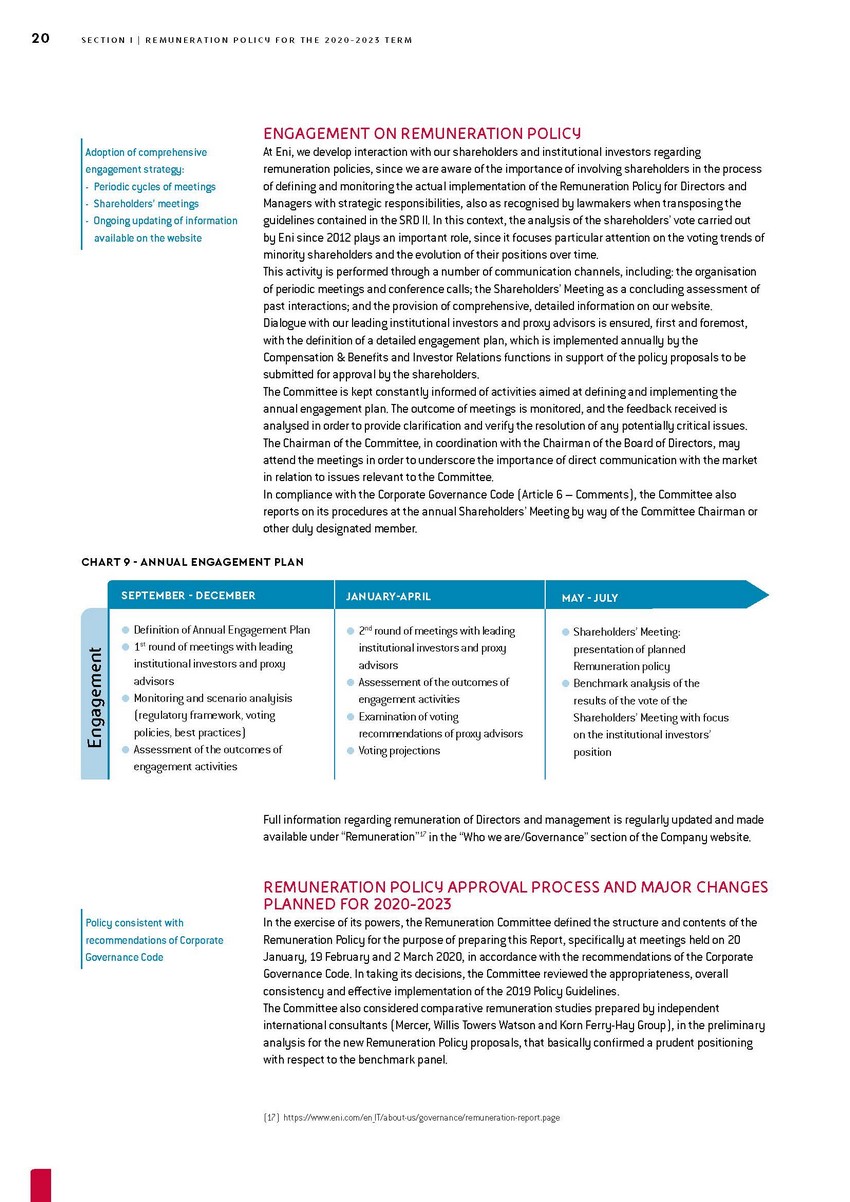 | Adoption of comprehensive engagement strategy: Periodic cycles of meetings Shareholders’ meetings Ongoing updating of information available on the website ENGAGEMENT ON REMUNERATION POLICY At Eni, we develop interaction with our shareholders and institutional investors regarding remuneration policies, since we are aware of the importance of involving shareholders in the process of defining and monitoring the actual implementation of the Remuneration Policy for Directors and Managers with strategic responsibilities, also as recognised by lawmakers when transposing the guidelines contained in the SRD II. In this context, the analysis of the shareholders’ vote carried out by Eni since 2012 plays an important role, since it focuses particular attention on the voting trends of minority shareholders and the evolution of their positions over time. This activity is performed through a number of communication channels, including: the organisation of periodic meetings and conference calls; the Shareholders’ Meeting as a concluding assessment of past interactions; and the provision of comprehensive, detailed information on our website. Dialogue with our leading institutional investors and proxy advisors is ensured, first and foremost, with the definition of a detailed engagement plan, which is implemented annually by the Compensation & Benefits and Investor Relations functions in support of the policy proposals to be submitted for approval by the shareholders. The Committee is kept constantly informed of activities aimed at defining and implementing the annual engagement plan. The outcome of meetings is monitored, and the feedback received is analysed in order to provide clarification and verify the resolution of any potentially critical issues. The Chairman of the Committee, in coordination with the Chairman of the Board of Directors, may attend the meetings in order to underscore the importance of direct communication with the market in relation to issues relevant to the Committee. In compliance with the Corporate Governance Code (Article 6 – Comments), the Committee also reports on its procedures at the annual Shareholders’ Meeting by way of the Committee Chairman or other duly designated member. SEPTEMBER - DECEMBER JANUARY-APRIL MAY - JULY Definition of Annual Engagement Plan 1st round of meetings with leading institutional investors and proxy advisors Monitoring and scenario analyisis (regulatory framework, voting policies, best practices) Assessment of the outcomes of engagement activities 2nd round of meetings with leading institutional investors and proxy advisors Assessement of the outcomes of engagement activities Examination of voting recommendations of proxy advisors Voting projections Shareholders’ Meeting: presentation of planned Remuneration policy Benchmark analysis of the results of the vote of the Shareholders’ Meeting with focus on the institutional investors’ position Engagement Policy consistent with recommendations of Corporate Governance Code REMUNERATION POLICY APPROVAL PROCESS AND MAJOR CHANGES PLANNED FOR 2020-2023 In the exercise of its powers, the Remuneration Committee defined the structure and contents of the Remuneration Policy for the purpose of preparing this Report, specifically at meetings held on 20 January, 19 February and 2 March 2020, in accordance with the recommendations of the Corporate Governance Code. In taking its decisions, the Committee reviewed the appropriateness, overall consistency and effective implementation of the 2019 Policy Guidelines. The Committee also considered comparative remuneration studies prepared by independent international consultants (Mercer, Willis Towers Watson and Korn Ferry-Hay Group), in the preliminary analysis for the new Remuneration Policy proposals, that basically confirmed a prudent positioning with respect to the benchmark panel. https://www.eni.com/en_IT/about-us/governance/remuneration-report.page |
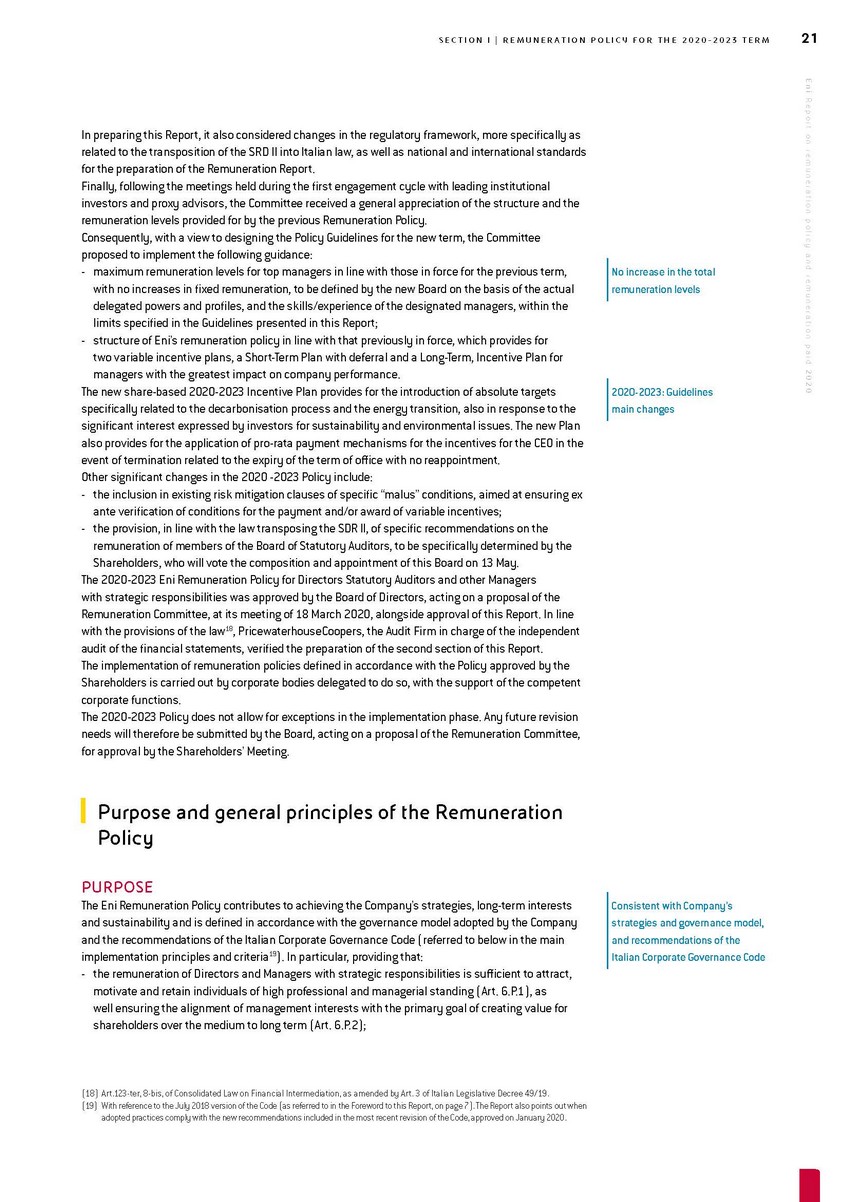 | In preparing this Report, it also considered changes in the regulatory framework, more specifically as related to the transposition of the SRD II into Italian law, as well as national and international standards for the preparation of the Remuneration Report. Finally, following the meetings held during the first engagement cycle with leading institutional investors and proxy advisors, the Committee received a general appreciation of the structure and the remuneration levels provided for by the previous Remuneration Policy. Consequently, with a view to designing the Policy Guidelines for the new term, the Committee proposed to implement the following guidance: maximum remuneration levels for top managers in line with those in force for the previous term, with no increases in fixed remuneration, to be defined by the new Board on the basis of the actual delegated powers and profiles, and the skills/experience of the designated managers, within the limits specified in the Guidelines presented in this Report; structure of Eni’s remuneration policy in line with that previously in force, which provides for two variable incentive plans, a Short-Term Plan with deferral and a Long-Term, Incentive Plan for managers with the greatest impact on company performance. The new share-based 2020-2023 Incentive Plan provides for the introduction of absolute targets specifically related to the decarbonisation process and the energy transition, also in response to the significant interest expressed by investors for sustainability and environmental issues. The new Plan also provides for the application of pro-rata payment mechanisms for the incentives for the CEO in the event of termination related to the expiry of the term of office with no reappointment. Other significant changes in the 2020 -2023 Policy include: the inclusion in existing risk mitigation clauses of specific “malus” conditions, aimed at ensuring ex ante verification of conditions for the payment and/or award of variable incentives; the provision, in line with the law transposing the SDR II, of specific recommendations on the remuneration of members of the Board of Statutory Auditors, to be specifically determined by the Shareholders, who will vote the composition and appointment of this Board on 13 May. The 2020-2023 Eni Remuneration Policy for Directors Statutory Auditors and other Managers with strategic responsibilities was approved by the Board of Directors, acting on a proposal of the Remuneration Committee, at its meeting of 18 March 2020, alongside approval of this Report. In line with the provisions of the law18, PricewaterhouseCoopers, the Audit Firm in charge of the independent audit of the financial statements, verified the preparation of the second section of this Report. The implementation of remuneration policies defined in accordance with the Policy approved by the Shareholders is carried out by corporate bodies delegated to do so, with the support of the competent corporate functions. The 2020-2023 Policy does not allow for exceptions in the implementation phase. Any future revision needs will therefore be submitted by the Board, acting on a proposal of the Remuneration Committee, for approval by the Shareholders’ Meeting. Eni R eport on r emuner ation policy and r emuner ation paid 20 20 2020-2023: Guidelines main changes Purpose and general principles of the Remuneration Policy PURPOSE The Eni Remuneration Policy contributes to achieving the Company’s strategies, long-term interests and sustainability and is defined in accordance with the governance model adopted by the Company and the recommendations of the Italian Corporate Governance Code (referred to below in the main implementation principles and criteria19). In particular, providing that: the remuneration of Directors and Managers with strategic responsibilities is sufficient to attract, motivate and retain individuals of high professional and managerial standing (Art. 6.P.1), as well ensuring the alignment of management interests with the primary goal of creating value for shareholders over the medium to long term (Art. 6.P.2); Art.123-ter, 8-bis, of Consolidated Law on Financial Intermediation, as amended by Art. 3 of Italian Legislative Decree 49/19. With reference to the July 2018 version of the Code (as referred to in the Foreword to this Report, on page 7). The Report also points out when adopted practices comply with the new recommendations included in the most recent revision of the Code, approved on January 2020. Consistent with Company’s strategies and governance model, and recommendations of the Italian Corporate Governance Code |
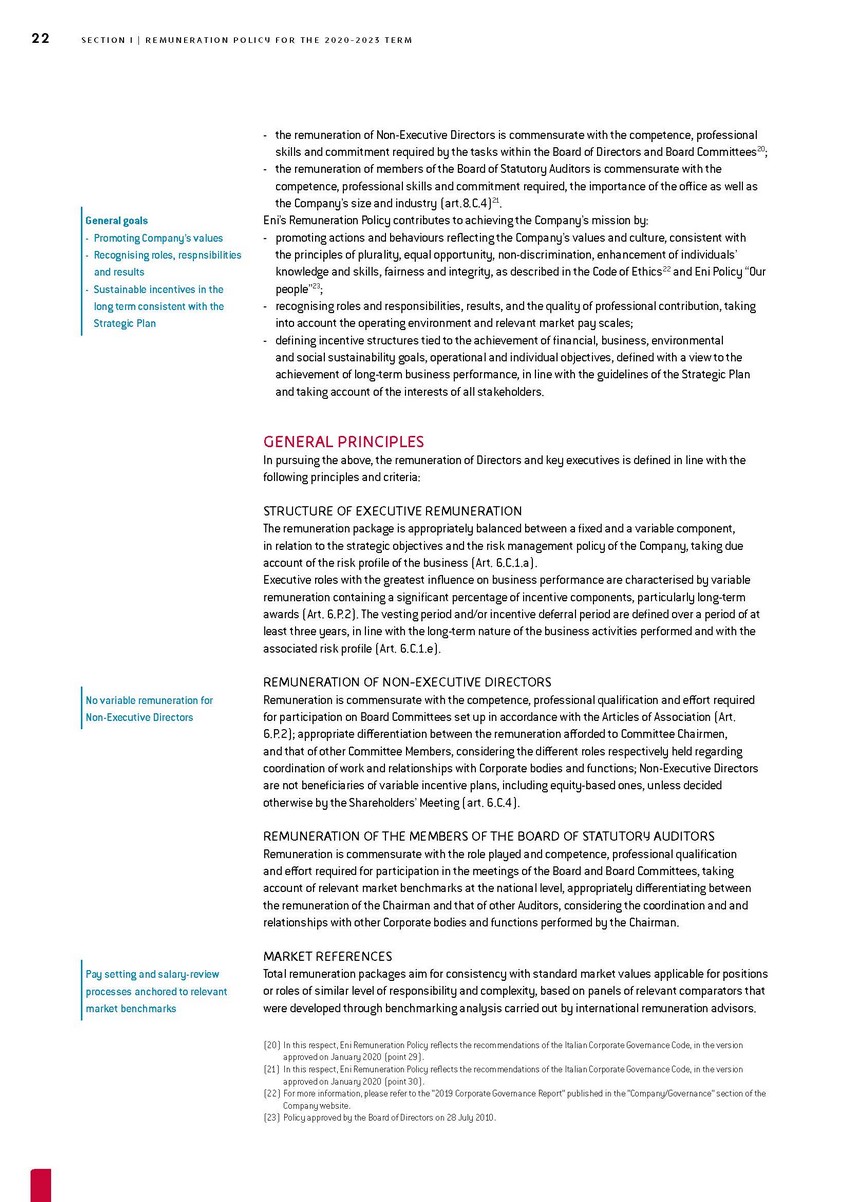 | General goals Promoting Company’s values Recognising roles, respnsibilities and results Sustainable incentives in the long term consistent with the Strategic Plan No variable remuneration for Non-Executive Directors Pay setting and salary-review processes anchored to relevant market benchmarks the remuneration of Non-Executive Directors is commensurate with the competence, professional skills and commitment required by the tasks within the Board of Directors and Board Committees20; the remuneration of members of the Board of Statutory Auditors is commensurate with the competence, professional skills and commitment required, the importance of the office as well as the Company’s size and industry (art.8.C.4)21. Eni’s Remuneration Policy contributes to achieving the Company’s mission by: promoting actions and behaviours reflecting the Company’s values and culture, consistent with the principles of plurality, equal opportunity, non-discrimination, enhancement of individuals’ knowledge and skills, fairness and integrity, as described in the Code of Ethics22 and Eni Policy “Our people”23; recognising roles and responsibilities, results, and the quality of professional contribution, taking into account the operating environment and relevant market pay scales; defining incentive structures tied to the achievement of financial, business, environmental and social sustainability goals, operational and individual objectives, defined with a view to the achievement of long-term business performance, in line with the guidelines of the Strategic Plan and taking account of the interests of all stakeholders. GENERAL PRINCIPLES In pursuing the above, the remuneration of Directors and key executives is defined in line with the following principles and criteria: STRUCTURE OF EXECUTIVE REMUNERATION The remuneration package is appropriately balanced between a fixed and a variable component, in relation to the strategic objectives and the risk management policy of the Company, taking due account of the risk profile of the business (Art. 6.C.1.a). Executive roles with the greatest influence on business performance are characterised by variable remuneration containing a significant percentage of incentive components, particularly long-term awards (Art. 6.P.2). The vesting period and/or incentive deferral period are defined over a period of at least three years, in line with the long-term nature of the business activities performed and with the associated risk profile (Art. 6.C.1.e). REMUNERATION OF NON-EXECUTIVE DIRECTORS Remuneration is commensurate with the competence, professional qualification and effort required for participation on Board Committees set up in accordance with the Articles of Association (Art. 6.P.2); appropriate differentiation between the remuneration afforded to Committee Chairmen, and that of other Committee Members, considering the different roles respectively held regarding coordination of work and relationships with Corporate bodies and functions; Non-Executive Directors are not beneficiaries of variable incentive plans, including equity-based ones, unless decided otherwise by the Shareholders’ Meeting (art. 6.C.4). REMUNERATION OF THE MEMBERS OF THE BOARD OF STATUTORY AUDITORS Remuneration is commensurate with the role played and competence, professional qualification and effort required for participation in the meetings of the Board and Board Committees, taking account of relevant market benchmarks at the national level, appropriately differentiating between the remuneration of the Chairman and that of other Auditors, considering the coordination and and relationships with other Corporate bodies and functions performed by the Chairman. MARKET REFERENCES Total remuneration packages aim for consistency with standard market values applicable for positions or roles of similar level of responsibility and complexity, based on panels of relevant comparators that were developed through benchmarking analysis carried out by international remuneration advisors. In this respect, Eni Remuneration Policy reflects the recommendations of the Italian Corporate Governance Code, in the version approved on January 2020 (point 29). In this respect, Eni Remuneration Policy reflects the recommendations of the Italian Corporate Governance Code, in the version approved on January 2020 (point 30). For more information, please refer to the “2019 Corporate Governance Report” published in the “Company/Governance” section of the Company website. Policy approved by the Board of Directors on 28 July 2010. |
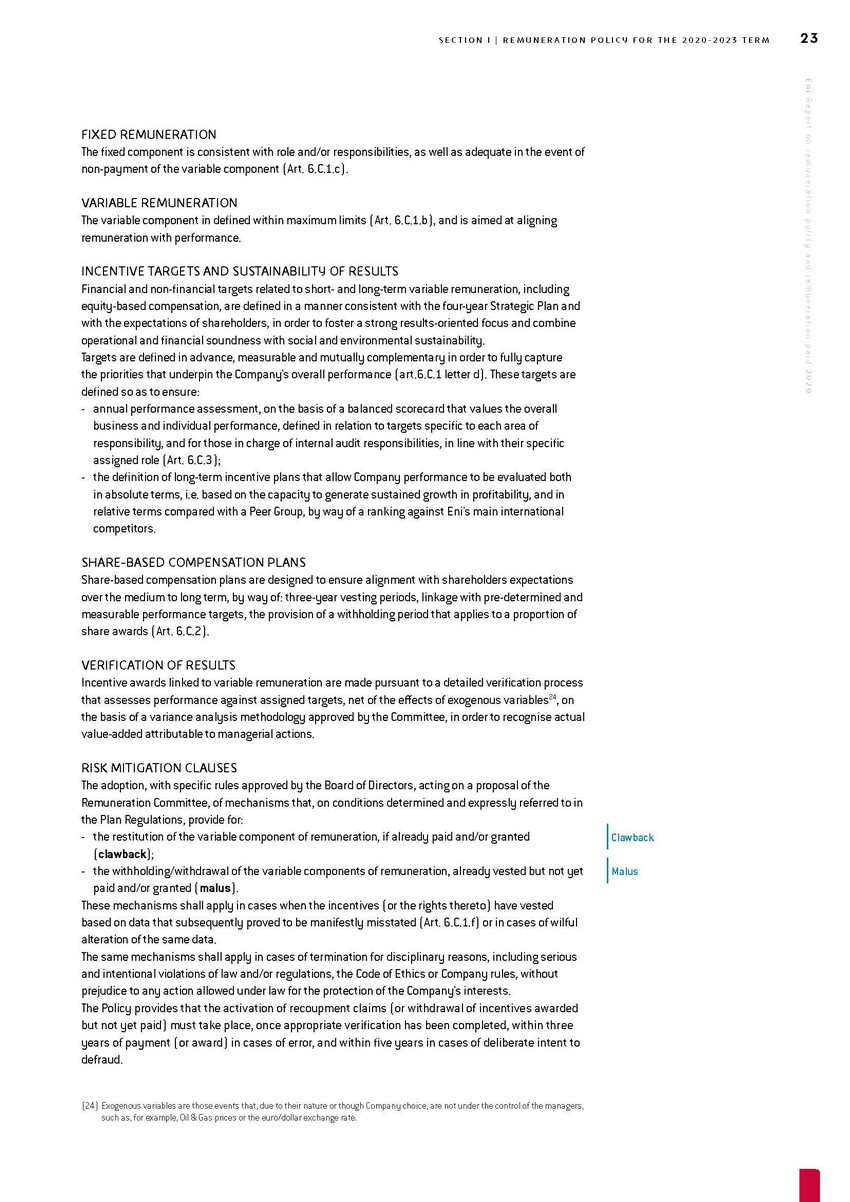 | Eni R eport on r emuner ation policy and r emuner ation paid 20 20 The fixed component is consistent with role and/or responsibilities, as well as adequate in the event of non-payment of the variable component (Art. 6.C.1.c). VARIABLE REMUNERATION The variable component in defined within maximum limits (Art. 6.C.1.b), and is aimed at aligning remuneration with performance. INCENTIVE TARGETS AND SUSTAINABILITY OF RESULTS Financial and non-financial targets related to short-and long-term variable remuneration, including equity-based compensation, are defined in a manner consistent with the four-year Strategic Plan and with the expectations of shareholders, in order to foster a strong results-oriented focus and combine operational and financial soundness with social and environmental sustainability. Targets are defined in advance, measurable and mutually complementary in order to fully capture the priorities that underpin the Company’s overall performance (art.6.C.1 letter d). These targets are defined so as to ensure: annual performance assessment, on the basis of a balanced scorecard that values the overall business and individual performance, defined in relation to targets specific to each area of responsibility, and for those in charge of internal audit responsibilities, in line with their specific assigned role (Art. 6.C.3); the definition of long-term incentive plans that allow Company performance to be evaluated both in absolute terms, i.e. based on the capacity to generate sustained growth in profitability, and in relative terms compared with a Peer Group, by way of a ranking against Eni’s main international competitors. SHARE-BASED COMPENSATION PLANS Share-based compensation plans are designed to ensure alignment with shareholders expectations over the medium to long term, by way of: three-year vesting periods, linkage with pre-determined and measurable performance targets, the provision of a withholding period that applies to a proportion of share awards (Art. 6.C.2). VERIFICATION OF RESULTS Incentive awards linked to variable remuneration are made pursuant to a detailed verification process that assesses performance against assigned targets, net of the effects of exogenous variables24, on the basis of a variance analysis methodology approved by the Committee, in order to recognise actual value-added attributable to managerial actions. RISK MITIGATION CLAUSES The adoption, with specific rules approved by the Board of Directors, acting on a proposal of the Remuneration Committee, of mechanisms that, on conditions determined and expressly referred to in the Plan Regulations, provide for: the restitution of the variable component of remuneration, if already paid and/or granted (clawback); the withholding/withdrawal of the variable components of remuneration, already vested but not yet paid and/or granted (malus). These mechanisms shall apply in cases when the incentives (or the rights thereto) have vested based on data that subsequently proved to be manifestly misstated (Art. 6.C.1.f) or in cases of wilful alteration of the same data. The same mechanisms shall apply in cases of termination for disciplinary reasons, including serious and intentional violations of law and/or regulations, the Code of Ethics or Company rules, without prejudice to any action allowed under law for the protection of the Company’s interests. The Policy provides that the activation of recoupment claims (or withdrawal of incentives awarded but not yet paid) must take place, once appropriate verification has been completed, within three years of payment (or award) in cases of error, and within fi e years in cases of deliberate intent to defraud. Exogenous variables are those events that, due to their nature or though Company choice, are not under the control of the managers, such as, for example, Oil & Gas prices or the euro/dollar exchange rate. Clawback Malus |
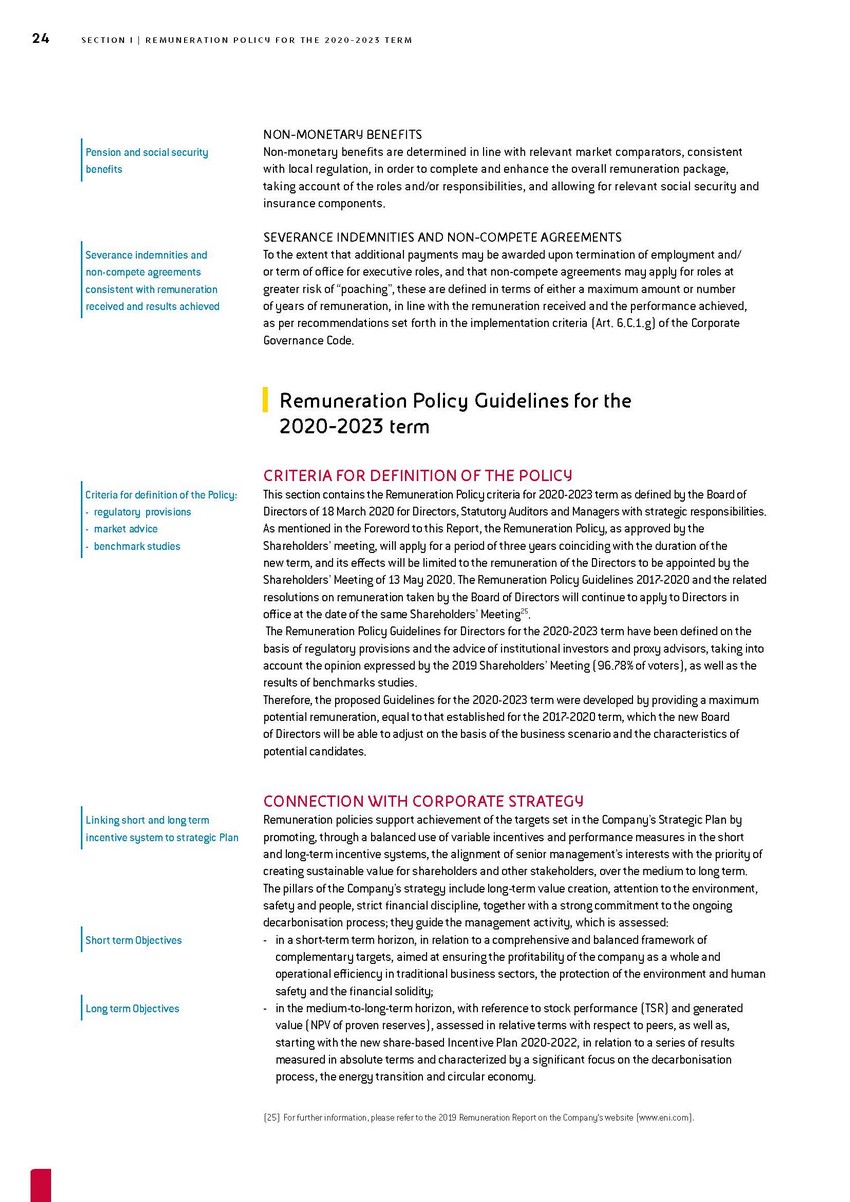 | Pension and social security benefits Severance indemnities and non-compete agreements consistent with remuneration received and results achieved NON-MONETARY BENEFITS Non-monetary benefits are determined in line with relevant market comparators, consistent with local regulation, in order to complete and enhance the overall remuneration package, taking account of the roles and/or responsibilities, and allowing for relevant social security and insurance components. SEVERANCE INDEMNITIES AND NON-COMPETE AGREEMENTS To the extent that additional payments may be awarded upon termination of employment and/ or term of offi e for executive roles, and that non-compete agreements may apply for roles at greater risk of “poaching”, these are defi ed in terms of either a maximum amount or number of years of remuneration, in line with the remuneration received and the performance achieved, as per recommendations set forth in the implementation criteria (Art. 6.C.1.g) of the Corporate Governance Code. Remuneration Policy Guidelines for the 2020-2023 term Criteria for definition of the Policy: regulatory provisions market advice benchmark studies Linking short and long term incentive system to strategic Plan Short term Objectives Long term Objectives CRITERIA FOR DEFINITION OF THE POLICY This section contains the Remuneration Policy criteria for 2020-2023 term as defi ed by the Board of Directors of 18 March 2020 for Directors, Statutory Auditors and Managers with strategic responsibilities. As mentioned in the Foreword to this Report, the Remuneration Policy, as approved by the Shareholders’ meeting, will apply for a period of three years coinciding with the duration of the new term, and its effects will be limited to the remuneration of the Directors to be appointed by the Shareholders’ Meeting of 13 May 2020. The Remuneration Policy Guidelines 2017-2020 and the related resolutions on remuneration taken by the Board of Directors will continue to apply to Directors in office at the date of the same Shareholders’ Meeting25. The Remuneration Policy Guidelines for Directors for the 2020-2023 term have been defined on the basis of regulatory provisions and the advice of institutional investors and proxy advisors, taking into account the opinion expressed by the 2019 Shareholders’ Meeting (96.78% of voters), as well as the results of benchmarks studies. Therefore, the proposed Guidelines for the 2020-2023 term were developed by providing a maximum potential remuneration, equal to that established for the 2017-2020 term, which the new Board of Directors will be able to adjust on the basis of the business scenario and the characteristics of potential candidates. CONNECTION WITH CORPORATE STRATEGY Remuneration policies support achievement of the targets set in the Company’s Strategic Plan by promoting, through a balanced use of variable incentives and performance measures in the short and long-term incentive systems, the alignment of senior management’s interests with the priority of creating sustainable value for shareholders and other stakeholders, over the medium to long term. The pillars of the Company’s strategy include long-term value creation, attention to the environment, safety and people, strict financial discipline, together with a strong commitment to the ongoing decarbonisation process; they guide the management activity, which is assessed: in a short-term term horizon, in relation to a comprehensive and balanced framework of complementary targets, aimed at ensuring the profitability of the company as a whole and operational efficiency in traditional business sectors, the protection of the environment and human safety and the financial solidity; in the medium-to-long-term horizon, with reference to stock performance (TSR) and generated value (NPV of proven reserves), assessed in relative terms with respect to peers, as well as, starting with the new share-based Incentive Plan 2020-2022, in relation to a series of results measured in absolute terms and characterized by a significant focus on the decarbonisation process, the energy transition and circular economy. For further information, please refer to the 2019 Remuneration Report on the Company’s website (www.eni.com). |
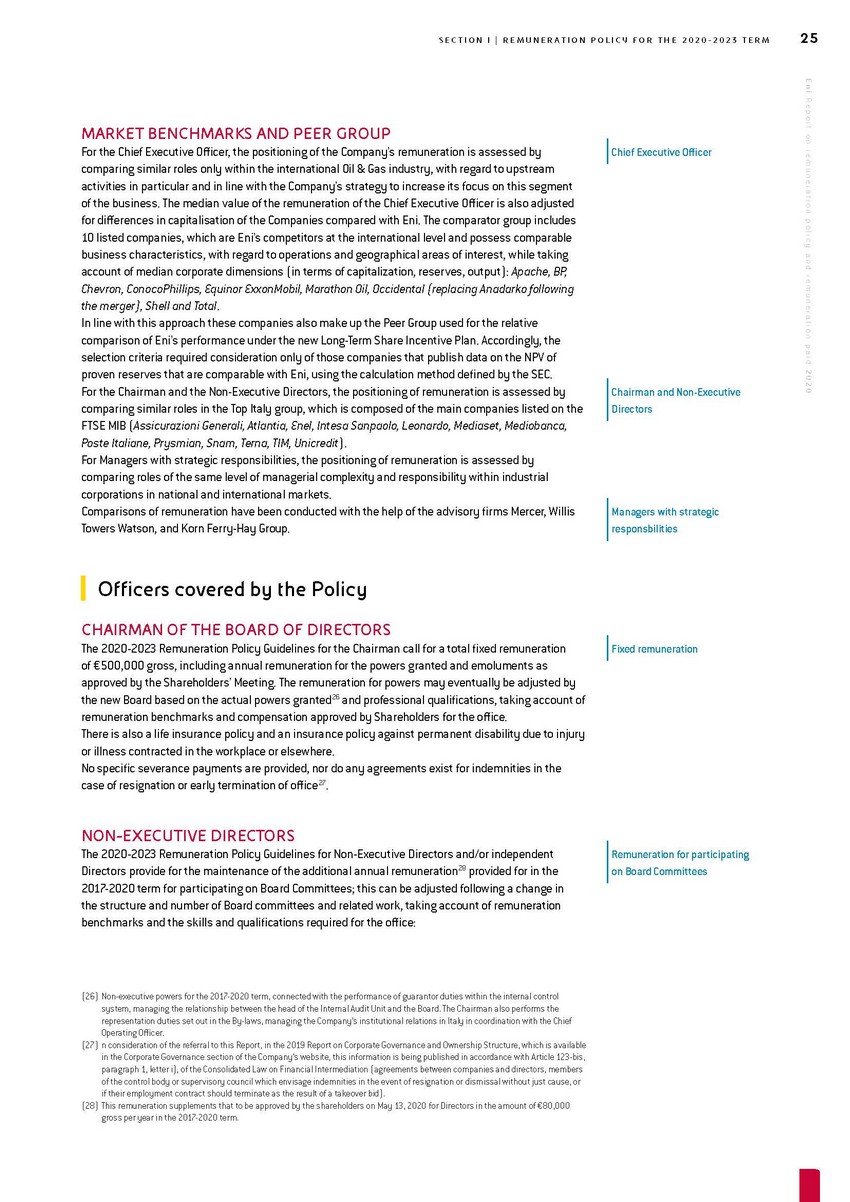 | MARKET BENCHMARKS AND PEER GROUP For the Chief Executive Officer, the positioning of the Company’s remuneration is assessed by comparing similar roles only within the international Oil & Gas industry, with regard to upstream activities in particular and in line with the Company’s strategy to increase its focus on this segment of the business. The median value of the remuneration of the Chief Executive Officer is also adjusted for differences in capitalisation of the Companies compared with Eni. The comparator group includes 10 listed companies, which are Eni’s competitors at the international level and possess comparable business characteristics, with regard to operations and geographical areas of interest, while taking account of median corporate dimensions (in terms of capitalization, reserves, output): Apache, BP, Chevron, ConocoPhillips, Equinor ExxonMobil, Marathon Oil, Occidental (replacing Anadarko following the merger), Shell and Total. In line with this approach these companies also make up the Peer Group used for the relative comparison of Eni’s performance under the new Long-Term Share Incentive Plan. Accordingly, the selection criteria required consideration only of those companies that publish data on the NPV of proven reserves that are comparable with Eni, using the calculation method defined by the SEC. For the Chairman and the Non-Executive Directors, the positioning of remuneration is assessed by comparing similar roles in the Top Italy group, which is composed of the main companies listed on the FTSE MIB (Assicurazioni Generali, Atlantia, Enel, Intesa Sanpaolo, Leonardo, Mediaset, Mediobanca, Poste Italiane, Prysmian, Snam, Terna, TIM, Unicredit). For Managers with strategic responsibilities, the positioning of remuneration is assessed by comparing roles of the same level of managerial complexity and responsibility within industrial corporations in national and international markets. Comparisons of remuneration have been conducted with the help of the advisory firms Mercer, Willis Towers Watson, and Korn Ferry-Hay Group. Eni R eport on r emuner ation policy and r emuner ation paid 20 20 Chairman and Non-Executive Directors Managers with strategic responsbilities Officers covered by the Policy CHAIRMAN OF THE BOARD OF DIRECTORS The 2020-2023 Remuneration Policy Guidelines for the Chairman call for a total fixed remuneration of €500,000 gross, including annual remuneration for the powers granted and emoluments as approved by the Shareholders’ Meeting. The remuneration for powers may eventually be adjusted by the new Board based on the actual powers granted26 and professional qualifications, taking account of remuneration benchmarks and compensation approved by Shareholders for the office. There is also a life insurance policy and an insurance policy against permanent disability due to injury or illness contracted in the workplace or elsewhere. No specific severance payments are provided, nor do any agreements exist for indemnities in the case of resignation or early termination of office27. NON-EXECUTIVE DIRECTORS The 2020-2023 Remuneration Policy Guidelines for Non-Executive Directors and/or independent Directors provide for the maintenance of the additional annual remuneration28 provided for in the 2017-2020 term for participating on Board Committees; this can be adjusted following a change in the structure and number of Board committees and related work, taking account of remuneration benchmarks and the skills and qualifications required for the office: Non-executive powers for the 2017-2020 term, connected with the performance of guarantor duties within the internal control system, managing the relationship between the head of the Internal Audit Unit and the Board. The Chairman also performs the representation duties set out in the By-laws, managing the Company’s institutional relations in Italy in coordination with the Chief Operating Officer. n consideration of the referral to this Report, in the 2019 Report on Corporate Governance and Ownership Structure, which is available in the Corporate Governance section of the Company’s website, this information is being published in accordance with Article 123-bis, paragraph 1, letter i), of the Consolidated Law on Financial Intermediation (agreements between companies and directors, members of the control body or supervisory council which envisage indemnities in the event of resignation or dismissal without just cause, or if their employment contract should terminate as the result of a takeover bid). This remuneration supplements that to be approved by the shareholders on May 13, 2020 for Directors in the amount of €80,000 gross per year in the 2017-2020 term. Fixed remuneration Remuneration for participating on Board Committees |
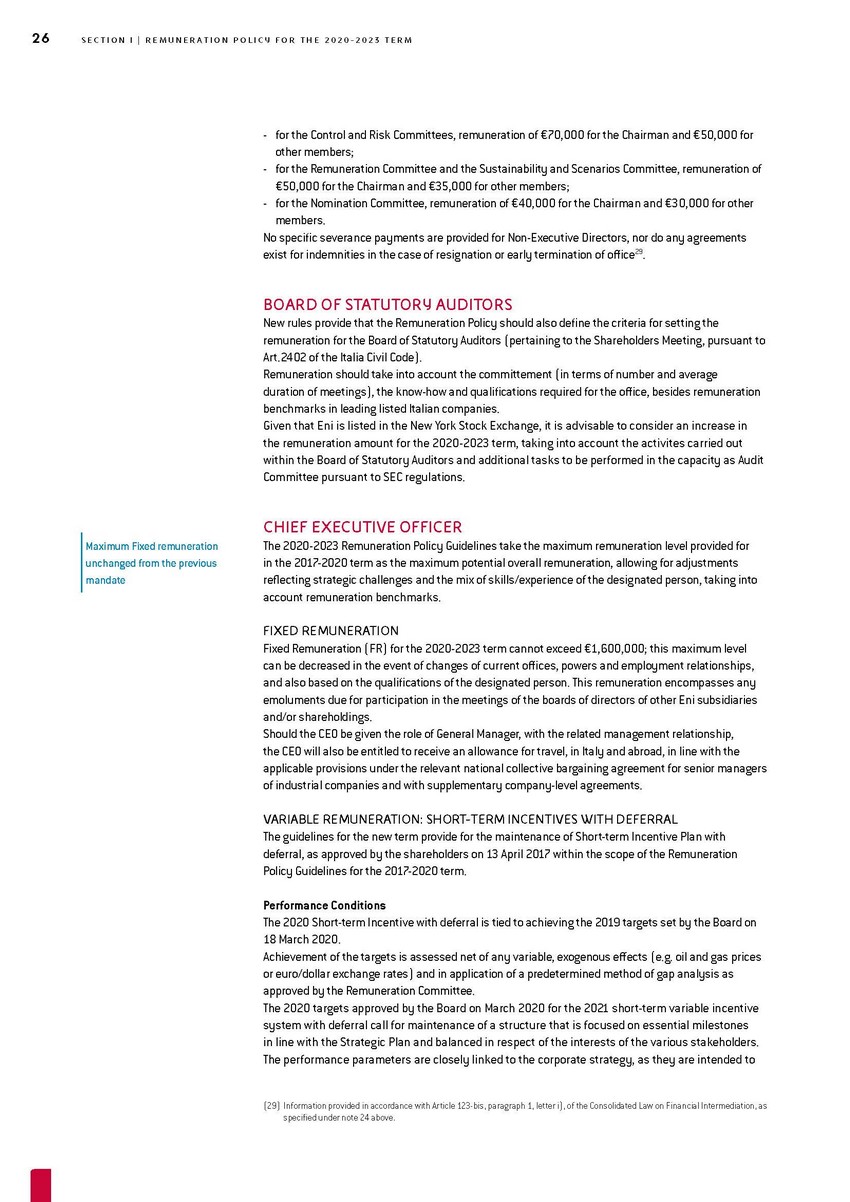 | for the Control and Risk Committees, remuneration of €70,000 for the Chairman and €50,000 for other members; for the Remuneration Committee and the Sustainability and Scenarios Committee, remuneration of €50,000 for the Chairman and €35,000 for other members; for the Nomination Committee, remuneration of €40,000 for the Chairman and €30,000 for other members. No specific severance payments are provided for Non-Executive Directors, nor do any agreements exist for indemnities in the case of resignation or early termination of office29. BOARD OF STATUTORY AUDITORS New rules provide that the Remuneration Policy should also define the criteria for setting the remuneration for the Board of Statutory Auditors (pertaining to the Shareholders Meeting, pursuant to Art.2402 of the Italia Civil Code). Remuneration should take into account the committement (in terms of number and average duration of meetings), the know-how and qualifications required for the office, besides remuneration benchmarks in leading listed Italian companies. Given that Eni is listed in the New York Stock Exchange, it is advisable to consider an increase in the remuneration amount for the 2020-2023 term, taking into account the activites carried out within the Board of Statutory Auditors and additional tasks to be performed in the capacity as Audit Committee pursuant to SEC regulations. Maximum Fixed remuneration unchanged from the previous mandate CHIEF EXECUTIVE OFFICER The 2020-2023 Remuneration Policy Guidelines take the maximum remuneration level provided for in the 2017-2020 term as the maximum potential overall remuneration, allowing for adjustments reflecting strategic challenges and the mix of skills/experience of the designated person, taking into account remuneration benchmarks. FIXED REMUNERATION Fixed Remuneration (FR) for the 2020-2023 term cannot exceed €1,600,000; this maximum level can be decreased in the event of changes of current offices, powers and employment relationships, and also based on the qualifications of the designated person. This remuneration encompasses any emoluments due for participation in the meetings of the boards of directors of other Eni subsidiaries and/or shareholdings. Should the CEO be given the role of General Manager, with the related management relationship, the CEO will also be entitled to receive an allowance for travel, in Italy and abroad, in line with the applicable provisions under the relevant national collective bargaining agreement for senior managers of industrial companies and with supplementary company-level agreements. VARIABLE REMUNERATION: SHORT-TERM INCENTIVES WITH DEFERRAL The guidelines for the new term provide for the maintenance of Short-term Incentive Plan with deferral, as approved by the shareholders on 13 April 2017 within the scope of the Remuneration Policy Guidelines for the 2017-2020 term. Performance Conditions The 2020 Short-term Incentive with deferral is tied to achieving the 2019 targets set by the Board on 18 March 2020. Achievement of the targets is assessed net of any variable, exogenous effects (e.g. oil and gas prices or euro/dollar exchange rates) and in application of a predetermined method of gap analysis as approved by the Remuneration Committee. The 2020 targets approved by the Board on March 2020 for the 2021 short-term variable incentive system with deferral call for maintenance of a structure that is focused on essential milestones in line with the Strategic Plan and balanced in respect of the interests of the various stakeholders. The performance parameters are closely linked to the corporate strategy, as they are intended to Information provided in accordance with Article 123-bis, paragraph 1, letter i), of the Consolidated Law on Financial Intermediation, as specified under note 24 above. |
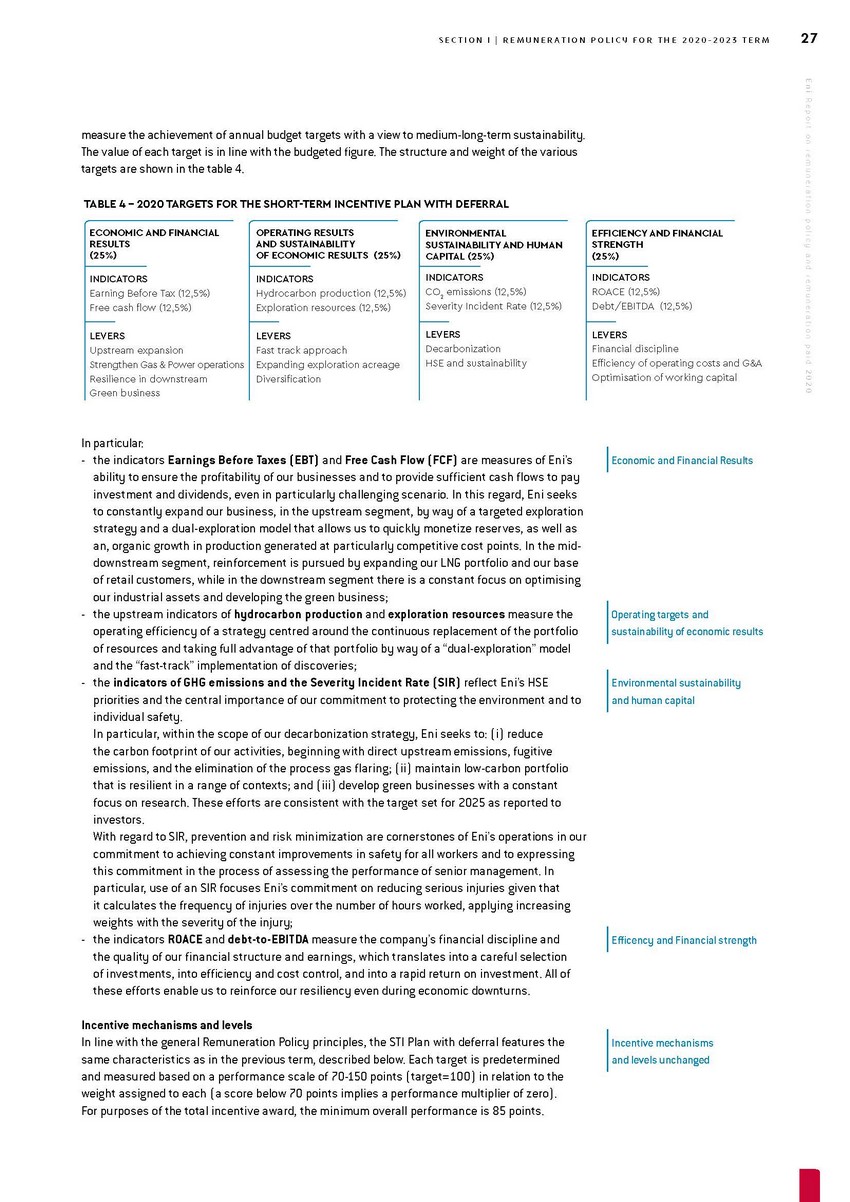 | Eni R eport on r emuner ation policy and r emuner ation paid 20 20 ENVIRONMENTAL SUSTAINABILITY AND HUMAN CAPITAL (25%) INDICATORS CO2 emissions (12,5%) Severity Incident Rate (12,5%) LEVERS Decarbonization HSE and sustainability ECONOMIC AND FINANCIAL RESULTS (25%) INDICATORS Earning Before Tax (12,5%) Free cash flow (12,5%) LEVERS Upstream expansion Strengthen Gas & Power operations Resilience in downstream Green business OPERATING RESULTS AND SUSTAINABILITY OF ECONOMIC RESULTS (25%) INDICATORS Hydrocarbon production (12,5%) Exploration resources (12,5%) LEVERS Fast track approach Expanding exploration acreage Diversification EFFICIENCY AND FINANCIAL STRENGTH (25%) INDICATORS ROACE (12,5%) Debt/EBITDA (12,5%) LEVERS Financial discipline Effiof operating costs and G&A Optimisation of working capital In particular: the indicators Earnings Before Taxes (EBT) and Free Cash Flow (FCF) are measures of Eni’s ability to ensure the profitability of our businesses and to provide sufficient cash flows to pay investment and dividends, even in particularly challenging scenario. In this regard, Eni seeks to constantly expand our business, in the upstream segment, by way of a targeted exploration strategy and a dual-exploration model that allows us to quickly monetize reserves, as well as an, organic growth in production generated at particularly competitive cost points. In the mid-downstream segment, reinforcement is pursued by expanding our LNG portfolio and our base of retail customers, while in the downstream segment there is a constant focus on optimising our industrial assets and developing the green business; the upstream indicators of hydrocarbon production and exploration resources measure the operating efficiency of a strategy centred around the continuous replacement of the portfolio of resources and taking full advantage of that portfolio by way of a “dual-exploration” model and the “fast-track” implementation of discoveries; the indicators of GHG emissions and the Severity Incident Rate (SIR) reflect Eni’s HSE priorities and the central importance of our commitment to protecting the environment and to individual safety. In particular, within the scope of our decarbonization strategy, Eni seeks to: (i) reduce the carbon footprint of our activities, beginning with direct upstream emissions, fugitive emissions, and the elimination of the process gas flaring; (ii) maintain low-carbon portfolio that is resilient in a range of contexts; and (iii) develop green businesses with a constant focus on research. These efforts are consistent with the target set for 2025 as reported to investors. With regard to SIR, prevention and risk minimization are cornerstones of Eni’s operations in our commitment to achieving constant improvements in safety for all workers and to expressing this commitment in the process of assessing the performance of senior management. In particular, use of an SIR focuses Eni’s commitment on reducing serious injuries given that it calculates the frequency of injuries over the number of hours worked, applying increasing weights with the severity of the injury; - the indicators ROACE and debt-to-EBITDA measure the company’s financial discipline and the quality of our financial structure and earnings, which translates into a careful selection of investments, into efficiency and cost control, and into a rapid return on investment. All of these efforts enable us to reinforce our resiliency even during economic downturns. Incentive mechanisms and levels In line with the general Remuneration Policy principles, the STI Plan with deferral features the same characteristics as in the previous term, described below. Each target is predetermined and measured based on a performance scale of 70-150 points (target=100) in relation to the weight assigned to each (a score below 70 points implies a performance multiplier of zero). For purposes of the total incentive award, the minimum overall performance is 85 points. Economic and Financial Results Operating targets and sustainability of economic results Environmental sustainability and human capital Efficency and Financial strength Incentive mechanisms and levels unchanged |
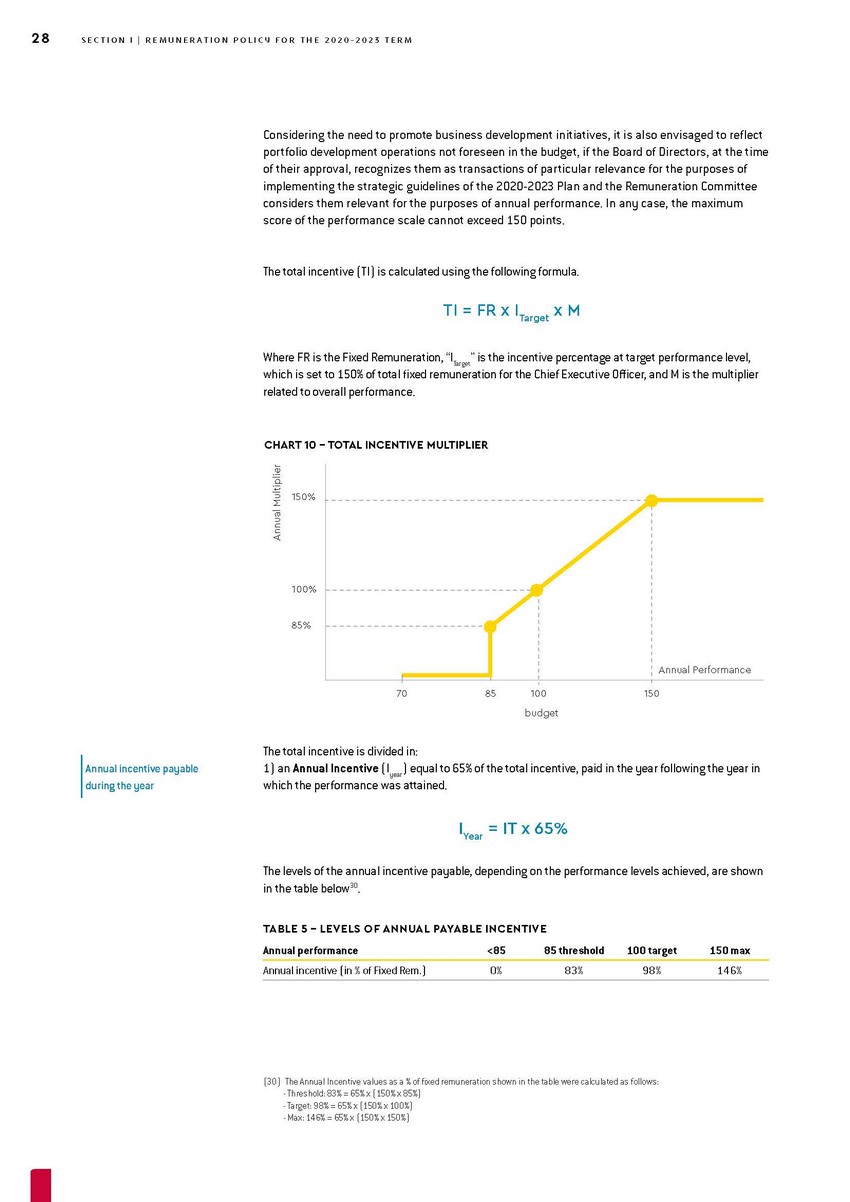 | Considering the need to promote business development initiatives, it is also envisaged to reflect portfolio development operations not foreseen in the budget, if the Board of Directors, at the time of their approval, recognizes them as transactions of particular relevance for the purposes of implementing the strategic guidelines of the 2020-2023 Plan and the Remuneration Committee considers them relevant for the purposes of annual performance. In any case, the maximum score of the performance scale cannot exceed 150 points. The total incentive (TI) is calculated using the following formula. Target Where FR is the Fixed Remuneration, “ITarget” is the incentive percentage at target performance level, which is set to 150% of total fixed remuneration for the Chief Executive Officer, and M is the multiplier related to overall performance. CHART 10 - TOTAL INCENTIVE MULTIPLIER Annual Performance Annual Multiplier 100% 85% 7085 100150 budget Annual incentive payable during the year The total incentive is divided in: an Annual Incentive (Iyear) equal to 65% of the total incentive, paid in the year following the year in which the performance was attained. I = IT x 65% The levels of the annual incentive payable, depending on the performance levels achieved, are shown in the table below30. TABLE 5 – LEVELS OF ANNUAL PAYABLE INCENTIVE The Annual Incentive values as a % of fixed remuneration shown in the table were calculated as follows: - Threshold: 83% = 65% x (150% x 85%) - Target: 98% = 65% x (150% x 100%) - Max: 146% = 65% x (150% x 150%) |
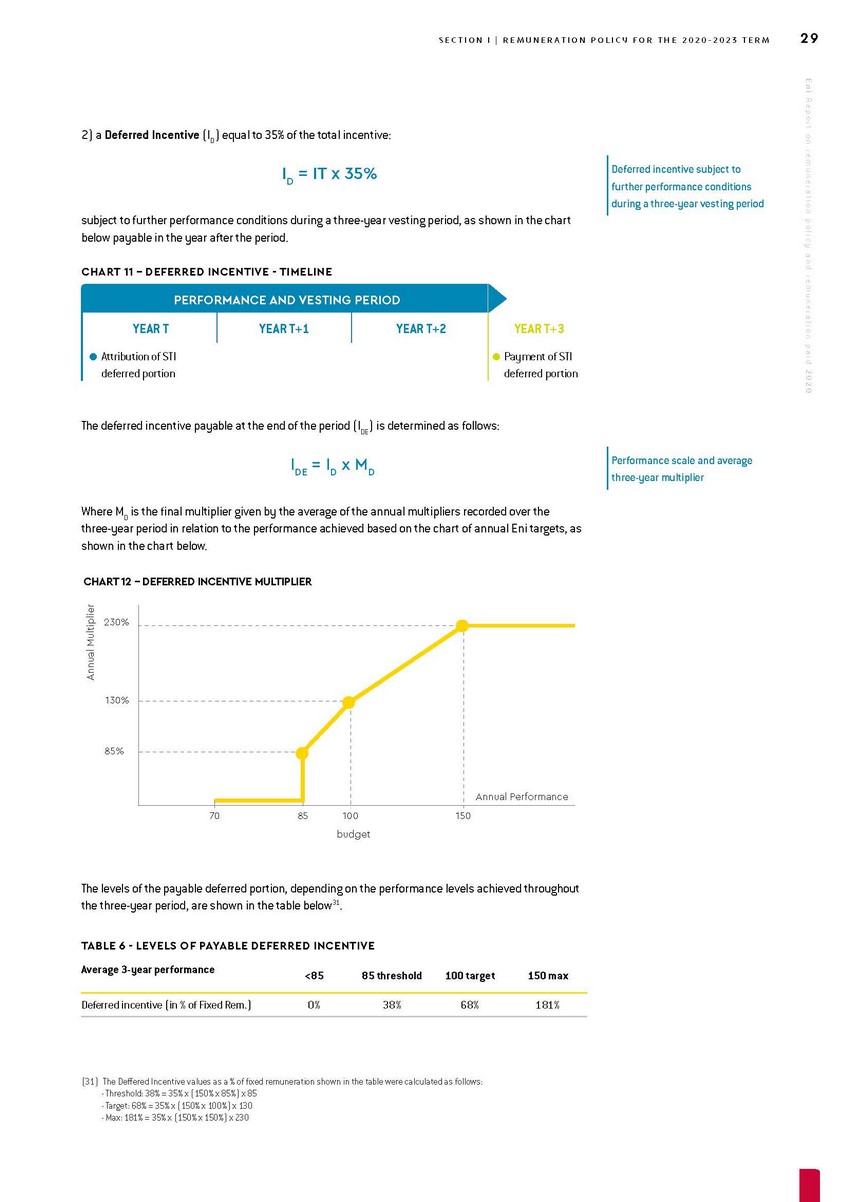 | Eni R eport on r emuner ation policy and r emuner ation paid 20 20 I D Deferred incentive subject to further performance conditions during a three-year vesting period subject to further performance conditions during a three-year vesting period, as shown in the chart below payable in the year after the period. CHART 11 – DEFERRED INCENTIVE - TIMELINE PERFORMANCE AND VESTING PERIOD YEAR T Attribution of STI deferred portion YEAR T+1YEAR T+2YEAR T+3 Payment of STI deferred portion The deferred incentive payable at the end of the period (IDE) is determined as follows: I D = I x M Performance scale and average three-year multiplier Where MD is the final multiplier given by the average of the annual multipliers recorded over the three-year period in relation to the performance achieved based on the chart of annual Eni targets, as shown in the chart below. CHART 12 - DEFERRED INCENTIVE MULTIPLIER Annual Performance Annual Multiplier 130% 85% 7085 100150 budget The levels of the payable deferred portion, depending on the performance levels achieved throughout the three-year period, are shown in the table below31. TABLE 6 - LEVELS OF PAYABLE DEFERRED INCENTIVE <85 85 threshold 100 target 150 max 0% 38% 68% 181% Deferred incentive (in % of Fixed Rem.) The Deffered Incentive values as a % of fixed remuneration shown in the table were calculated as follows: - Threshold: 38% = 35% x (150% x 85%) x 85 - Target: 68% = 35% x (150% x 100%) x 130 - Max: 181% = 35% x (150% x 150%) x 230 |
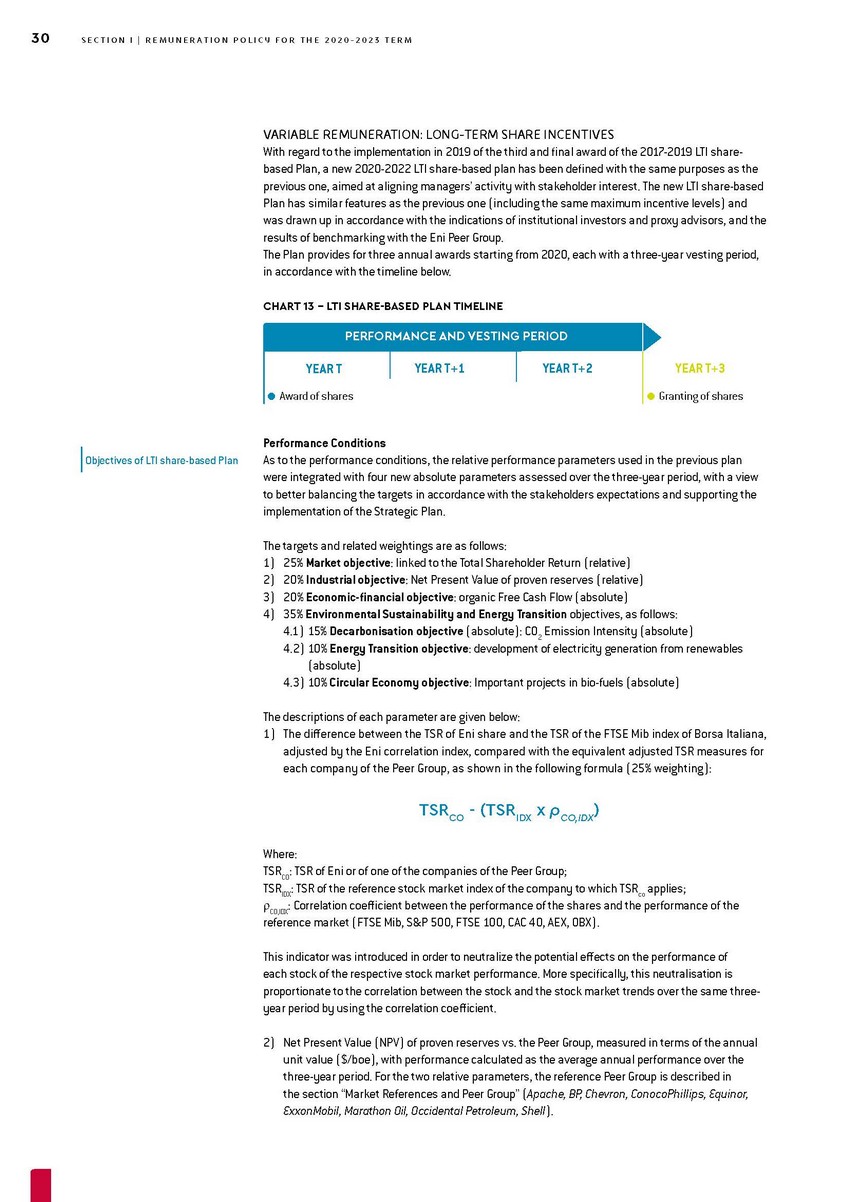 | VARIABLE REMUNERATION: LONG-TERM SHARE INCENTIVES With regard to the implementation in 2019 of the third and final award of the 2017-2019 LTI share-based Plan, a new 2020-2022 LTI share-based plan has been defined with the same purposes as the previous one, aimed at aligning managers’ activity with stakeholder interest. The new LTI share-based Plan has similar features as the previous one (including the same maximum incentive levels) and was drawn up in accordance with the indications of institutional investors and proxy advisors, and the results of benchmarking with the Eni Peer Group. The Plan provides for three annual awards starting from 2020, each with a three-year vesting period, in accordance with the timeline below. CHART 13 – LTI SHARE-BASED PLAN TIMELINE PERFORMANCE AND VESTING PERIOD YEAR T Award of shares YEAR T+1YEAR T+2YEAR T+3 Granting of shares Objectives of LTI share-based Plan Performance Conditions As to the performance conditions, the relative performance parameters used in the previous plan were integrated with four new absolute parameters assessed over the three-year period, with a view to better balancing the targets in accordance with the stakeholders expectations and supporting the implementation of the Strategic Plan. The targets and related weightings are as follows: 25% Market objective: linked to the Total Shareholder Return (relative) 20% Industrial objective: Net Present Value of proven reserves (relative) 20% Economic-financial objective: organic Free Cash Flow (absolute) 35% Environmental Sustainability and Energy Transition objectives, as follows: 4.1) 15% Decarbonisation objective (absolute): CO2 Emission Intensity (absolute) 10% Energy Transition objective: development of electricity generation from renewables (absolute) 10% Circular Economy objective: Important projects in bio-fuels (absolute) The descriptions of each parameter are given below: The diff rence between the TSR of Eni share and the TSR of the FTSE Mib index of Borsa Italiana, adjusted by the Eni correlation index, compared with the equivalent adjusted TSR measures for each company of the Peer Group, as shown in the following formula (25% weighting): TSR - (TSRx ρ) COIDX CO,IDX Where: TSRCO: TSR of Eni or of one of the companies of the Peer Group; TSRIDX: TSR of the reference stock market index of the company to which TSRco applies; ρCO,IDX: Correlation coefficient between the performance of the shares and the performance of the reference market (FTSE Mib, S&P 500, FTSE 100, CAC 40, AEX, OBX). This indicator was introduced in order to neutralize the potential effects on the performance of each stock of the respective stock market performance. More specifically, this neutralisation is proportionate to the correlation between the stock and the stock market trends over the same three-year period by using the correlation coefficient. Net Present Value (NPV) of proven reserves vs. the Peer Group, measured in terms of the annual unit value ($/boe), with performance calculated as the average annual performance over the three-year period. For the two relative parameters, the reference Peer Group is described in the section “Market References and Peer Group” (Apache, BP, Chevron, ConocoPhillips, Equinor, ExxonMobil, Marathon Oil, Occidental Petroleum, Shell). |
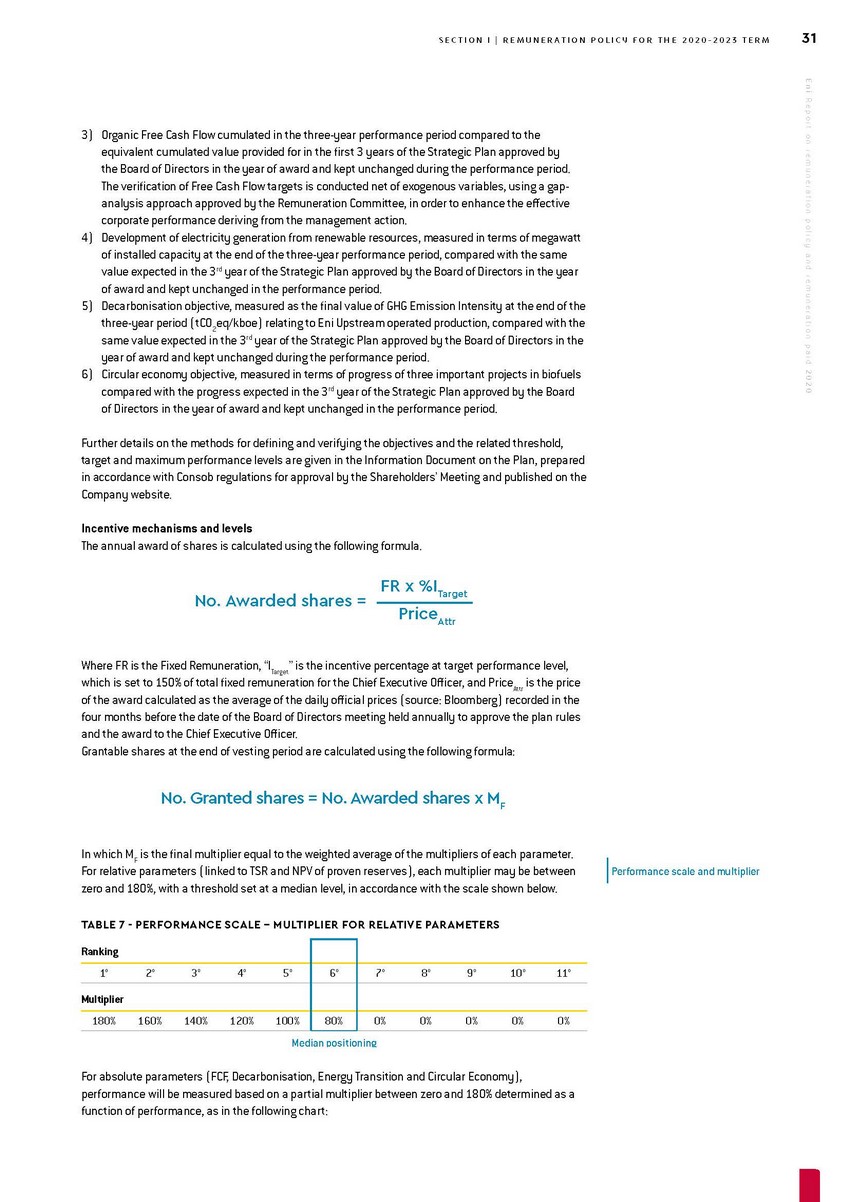 | Eni R eport on r emuner ation policy and r emuner ation paid 20 20 Development of electricity generation from renewable resources, measured in terms of megawatt of installed capacity at the end of the three-year performance period, compared with the same value expected in the 3rd year of the Strategic Plan approved by the Board of Directors in the year of award and kept unchanged in the performance period. Decarbonisation objective, measured as the final value of GHG Emission Intensity at the end of the three-year period (tCO2eq/kboe) relating to Eni Upstream operated production, compared with the same value expected in the 3rd year of the Strategic Plan approved by the Board of Directors in the year of award and kept unchanged during the performance period. Circular economy objective, measured in terms of progress of three important projects in biofuels compared with the progress expected in the 3rd year of the Strategic Plan approved by the Board of Directors in the year of award and kept unchanged in the performance period. Further details on the methods for defining and verifying the objectives and the related threshold, target and maximum performance levels are given in the Information Document on the Plan, prepared in accordance with Consob regulations for approval by the Shareholders’ Meeting and published on the Company website. Incentive mechanisms and levels The annual award of shares is calculated using the following formula. No. Awarded shares = FR x %I Attr Where FR is the Fixed Remuneration, “ITarget” is the incentive percentage at target performance level, which is set to 150% of total fixed remuneration for the Chief Executive Officer, and PriceAttr is the price of the award calculated as the average of the daily official prices (source: Bloomberg) recorded in the four months before the date of the Board of Directors meeting held annually to approve the plan rules and the award to the Chief Executive Officer. Grantable shares at the end of vesting period are calculated using the following formula: F In which MF is the final multiplier equal to the weighted average of the multipliers of each parameter. For relative parameters (linked to TSR and NPV of proven reserves), each multiplier may be between zero and 180%, with a threshold set at a median level, in accordance with the scale shown below. Performance scale and multiplier TABLE 7 - PERFORMANCE SCALE – MULTIPLIER FOR RELATIVE PARAMETERS Median positioning For absolute parameters (FCF, Decarbonisation, Energy Transition and Circular Economy), performance will be measured based on a partial multiplier between zero and 180% determined as a function of performance, as in the following chart: |
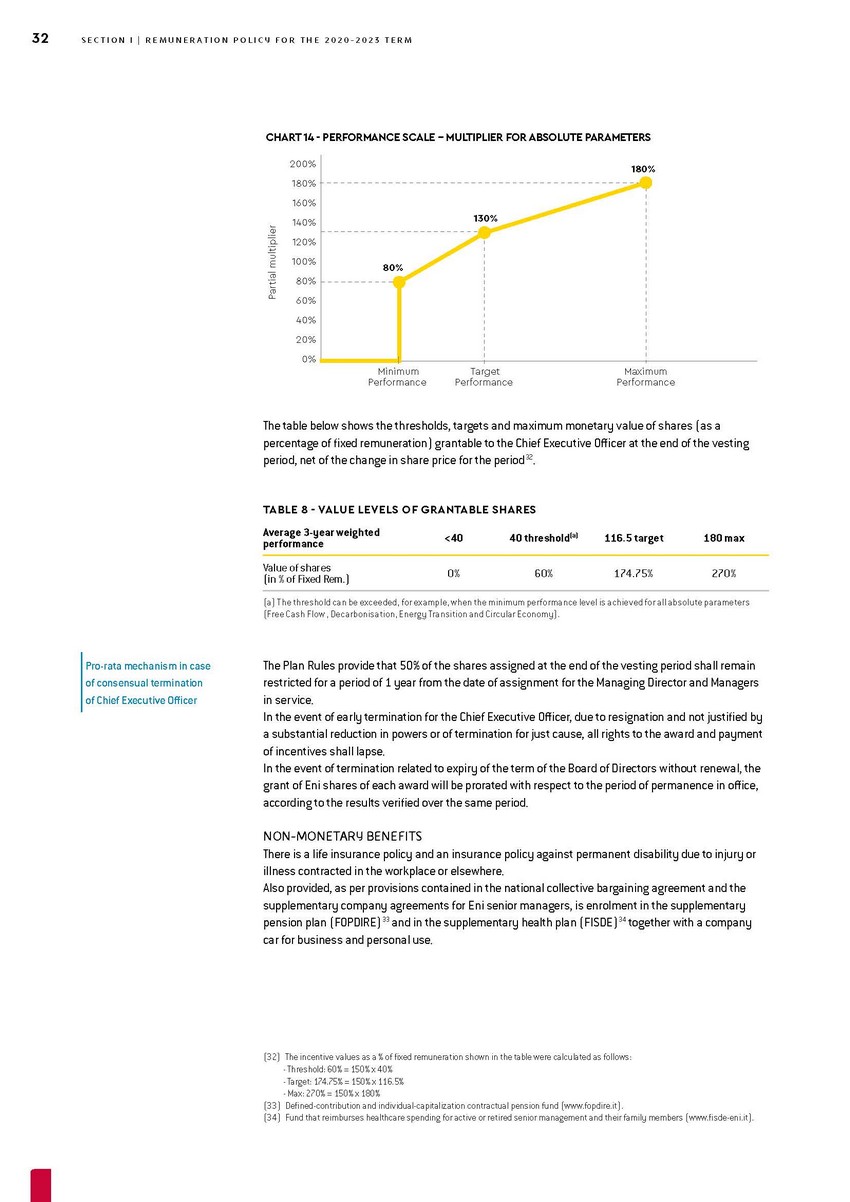 | CHART 14 - PERFORMANCE SCALE - MULTIPLIER FOR ABSOLUTE PARAMETERS 200% 180% 160% Partial multiplier 120% 100% 80% 60% 40% 20% 0% 80% Minimum Performance 130% Target Performance 180% Maximum Performance The table below shows the thresholds, targets and maximum monetary value of shares (as a percentage of fixed remuneration) grantable to the Chief Executive Officer at the end of the vesting period, net of the change in share price for the period32. TABLE 8 - VALUE LEVELS OF GRANTABLE SHARES Average 3-year weighted Value of shares The threshold can be exceeded, for example, when the minimum performance level is achieved for all absolute parameters (Free Cash Flow , Decarbonisation, Energy Transition and Circular Economy). Pro-rata mechanism in case of consensual termination of Chief Executive Officer The Plan Rules provide that 50% of the shares assigned at the end of the vesting period shall remain restricted for a period of 1 year from the date of assignment for the Managing Director and Managers in service. In the event of early termination for the Chief Executive Officer, due to resignation and not justified by a substantial reduction in powers or of termination for just cause, all rights to the award and payment of incentives shall lapse. In the event of termination related to expiry of the term of the Board of Directors without renewal, the grant of Eni shares of each award will be prorated with respect to the period of permanence in office, according to the results verified over the same period. NON-MONETARY BENEFITS There is a life insurance policy and an insurance policy against permanent disability due to injury or illness contracted in the workplace or elsewhere. Also provided, as per provisions contained in the national collective bargaining agreement and the supplementary company agreements for Eni senior managers, is enrolment in the supplementary pension plan (FOPDIRE)33 and in the supplementary health plan (FISDE)34 together with a company car for business and personal use. The incentive values as a % of fixed remuneration shown in the table were calculated as follows: - Threshold: 60% = 150% x 40% - Target: 174.75% = 150% x 116.5% - Max: 270% = 150% x 180% Defined-contribution and individual-capitalization contractual pension fund (www.fopdire.it). Fund that reimburses healthcare spending for active or retired senior management and their family members (www.fisde-eni.it). |
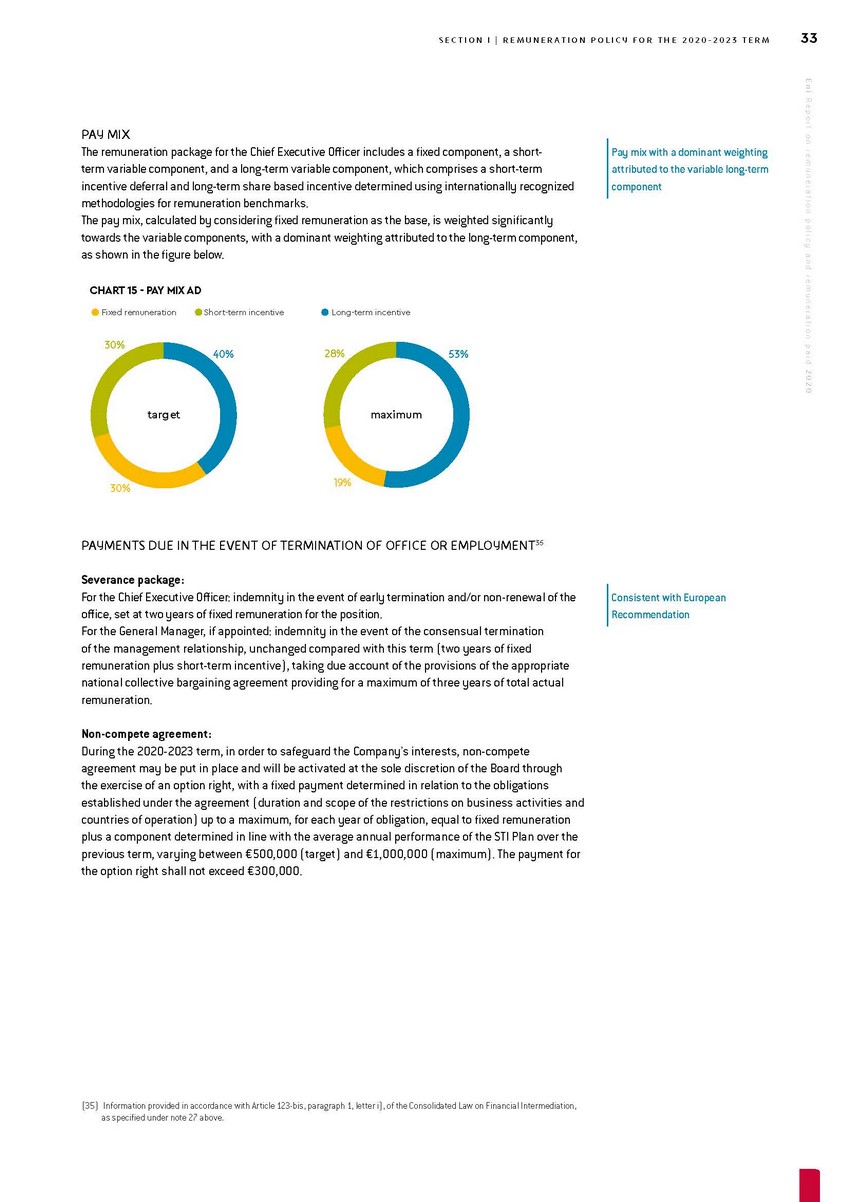 | PAY MIX The remuneration package for the Chief Executive Officer includes a fixed component, a short-term variable component, and a long-term variable component, which comprises a short-term incentive deferral and long-term share based incentive determined using internationally recognized methodologies for remuneration benchmarks. The pay mix, calculated by considering fixed remuneration as the base, is weighted significantly towards the variable components, with a dominant weighting attributed to the long-term component, as shown in the figure below. Eni R eport on r emuner ation policy and r emuner ation paid 20 20 CHART 15 - PAY MIX AD Fixed remunerationShort-term incentiveLong-term incentive 30% 40% target 30% 28% 53% maximum 19% PAYMENTS DUE IN THE EVENT OF TERMINATION OF OFFICE OR EMPLOYMENT35 Severance package: For the Chief Executive Officer: indemnity in the event of early termination and/or non-renewal of the office, set at two years of fixed remuneration for the position. For the General Manager, if appointed: indemnity in the event of the consensual termination of the management relationship, unchanged compared with this term (two years of fi ed remuneration plus short-term incentive), taking due account of the provisions of the appropriate national collective bargaining agreement providing for a maximum of three years of total actual remuneration. Non-compete agreement: During the 2020-2023 term, in order to safeguard the Company’s interests, non-compete agreement may be put in place and will be activated at the sole discretion of the Board through the exercise of an option right, with a fi ed payment determined in relation to the obligations established under the agreement (duration and scope of the restrictions on business activities and countries of operation) up to a maximum, for each year of obligation, equal to fi ed remuneration plus a component determined in line with the average annual performance of the STI Plan over the previous term, varying between €500,000 (target) and €1,000,000 (maximum). The payment for the option right shall not exceed €300,000. Information provided in accordance with Article 123-bis, paragraph 1, letter i), of the Consolidated Law on Financial Intermediation, as specified under note 27 above. Consistent with European Recommendation |
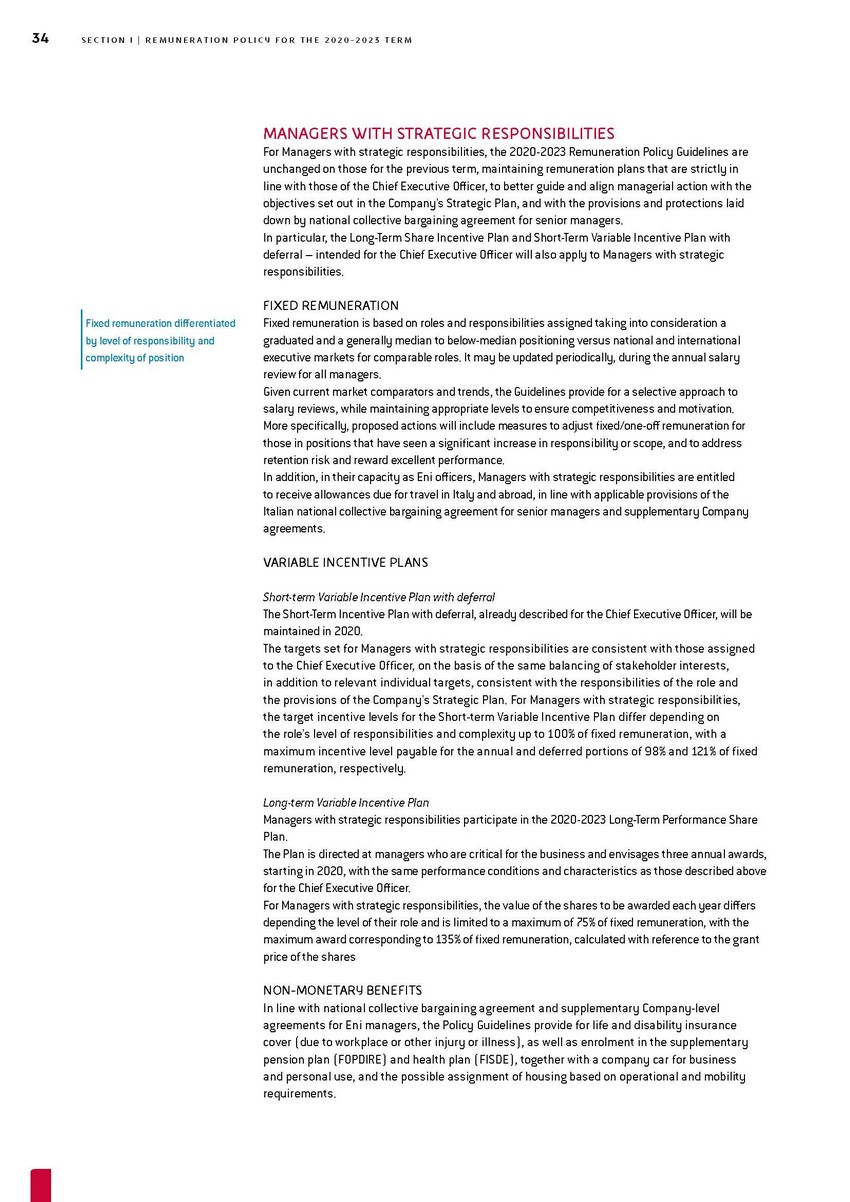 | MANAGERS WITH STRATEGIC RESPONSIBILITIES For Managers with strategic responsibilities, the 2020-2023 Remuneration Policy Guidelines are unchanged on those for the previous term, maintaining remuneration plans that are strictly in line with those of the Chief Executive Offi er, to better guide and align managerial action with the objectives set out in the Company’s Strategic Plan, and with the provisions and protections laid down by national collective bargaining agreement for senior managers. In particular, the Long-Term Share Incentive Plan and Short-Term Variable Incentive Plan with deferral – intended for the Chief Executive Offi er will also apply to Managers with strategic responsibilities. Fixed remuneration differentiated by level of responsibility and complexity of position FIXED REMUNERATION Fixed remuneration is based on roles and responsibilities assigned taking into consideration a graduated and a generally median to below-median positioning versus national and international executive markets for comparable roles. It may be updated periodically, during the annual salary review for all managers. Given current market comparators and trends, the Guidelines provide for a selective approach to salary reviews, while maintaining appropriate levels to ensure competitiveness and motivation. More specifically, proposed actions will include measures to adjust fixed/one-off remuneration for those in positions that have seen a significant increase in responsibility or scope, and to address retention risk and reward excellent performance. In addition, in their capacity as Eni officers, Managers with strategic responsibilities are entitled to receive allowances due for travel in Italy and abroad, in line with applicable provisions of the Italian national collective bargaining agreement for senior managers and supplementary Company agreements. VARIABLE INCENTIVE PLANS Short-term Variable Incentive Plan with deferral The Short-Term Incentive Plan with deferral, already described for the Chief Executive Officer, will be maintained in 2020. The targets set for Managers with strategic responsibilities are consistent with those assigned to the Chief Executive Officer, on the basis of the same balancing of stakeholder interests, in addition to relevant individual targets, consistent with the responsibilities of the role and the provisions of the Company’s Strategic Plan. For Managers with strategic responsibilities, the target incentive levels for the Short-term Variable Incentive Plan differ depending on the role’s level of responsibilities and complexity up to 100% of fixed remuneration, with a maximum incentive level payable for the annual and deferred portions of 98% and 121% of fixed remuneration, respectively. Long-term Variable Incentive Plan Managers with strategic responsibilities participate in the 2020-2023 Long-Term Performance Share Plan. The Plan is directed at managers who are critical for the business and envisages three annual awards, starting in 2020, with the same performance conditions and characteristics as those described above for the Chief Executive Officer. For Managers with strategic responsibilities, the value of the shares to be awarded each year differs depending the level of their role and is limited to a maximum of 75% of fixed remuneration, with the maximum award corresponding to 135% of fixed remuneration, calculated with reference to the grant price of the shares NON-MONETARY BENEFITS In line with national collective bargaining agreement and supplementary Company-level agreements for Eni managers, the Policy Guidelines provide for life and disability insurance cover (due to workplace or other injury or illness), as well as enrolment in the supplementary pension plan (FOPDIRE) and health plan (FISDE), together with a company car for business and personal use, and the possible assignment of housing based on operational and mobility requirements. |
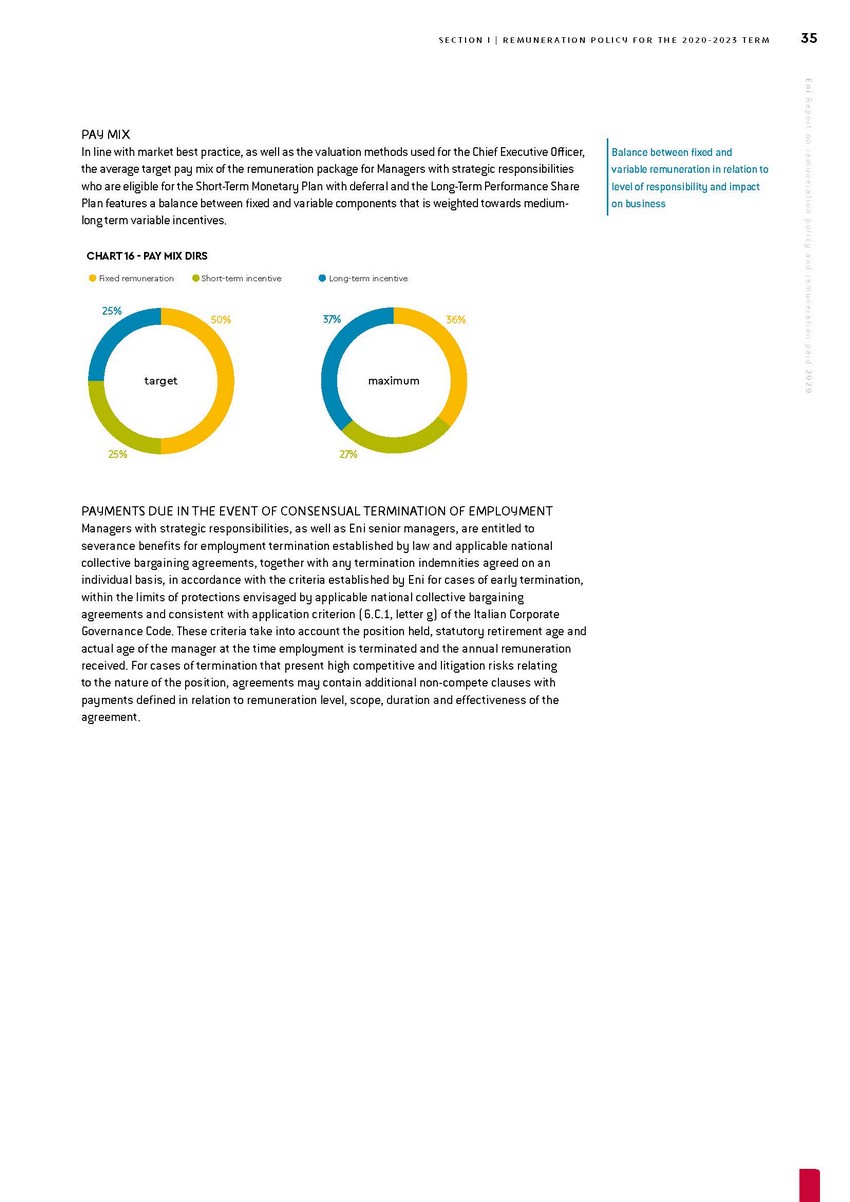 | PAY MIX In line with market best practice, as well as the valuation methods used for the Chief Executive Officer, the average target pay mix of the remuneration package for Managers with strategic responsibilities who are eligible for the Short-Term Monetary Plan with deferral and the Long-Term Performance Share Plan features a balance between fixed and variable components that is weighted towards medium-long term variable incentives. Eni R eport on r emuner ation policy and r emuner ation paid 20 20 CHART 16 - PAY MIX DIRS Fixed remunerationShort-term incentiveLong-term incentive 25% 50% target 25% 37% 36% maximum 27% PAYMENTS DUE IN THE EVENT OF CONSENSUAL TERMINATION OF EMPLOYMENT Managers with strategic responsibilities, as well as Eni senior managers, are entitled to severance benefits for employment termination established by law and applicable national collective bargaining agreements, together with any termination indemnities agreed on an individual basis, in accordance with the criteria established by Eni for cases of early termination, within the limits of protections envisaged by applicable national collective bargaining agreements and consistent with application criterion (6.C.1, letter g) of the Italian Corporate Governance Code. These criteria take into account the position held, statutory retirement age and actual age of the manager at the time employment is terminated and the annual remuneration received. For cases of termination that present high competitive and litigation risks relating to the nature of the position, agreements may contain additional non-compete clauses with payments defined in relation to remuneration level, scope, duration and effectiveness of the agreement. |
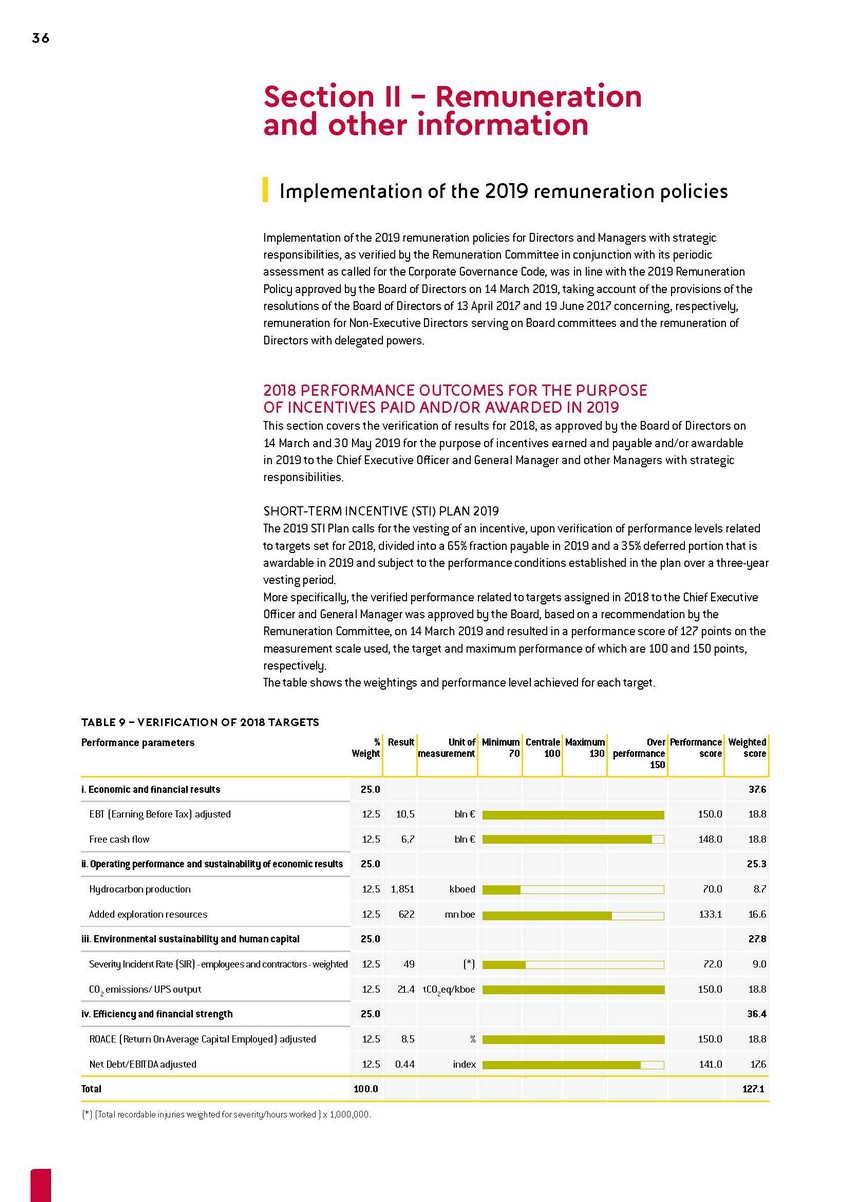 | Section II – Remuneration and other information Implementation of the 2019 remuneration policies Implementation of the 2019 remuneration policies for Directors and Managers with strategic responsibilities, as verified by the Remuneration Committee in conjunction with its periodic assessment as called for the Corporate Governance Code, was in line with the 2019 Remuneration Policy approved by the Board of Directors on 14 March 2019, taking account of the provisions of the resolutions of the Board of Directors of 13 April 2017 and 19 June 2017 concerning, respectively, remuneration for Non-Executive Directors serving on Board committees and the remuneration of Directors with delegated powers. 2018 PERFORMANCE OUTCOMES FOR THE PURPOSE OF INCENTIVES PAID AND/OR AWARDED IN 2019 This section covers the verification of results for 2018, as approved by the Board of Directors on 14 March and 30 May 2019 for the purpose of incentives earned and payable and/or awardable in 2019 to the Chief Executive Offi er and General Manager and other Managers with strategic responsibilities. SHORT-TERM INCENTIVE (STI) PLAN 2019 The 2019 STI Plan calls for the vesting of an incentive, upon verification of performance levels related to targets set for 2018, divided into a 65% fraction payable in 2019 and a 35% deferred portion that is awardable in 2019 and subject to the performance conditions established in the plan over a three-year vesting period. More specifically, the verified performance related to targets assigned in 2018 to the Chief Executive Officer and General Manager was approved by the Board, based on a recommendation by the Remuneration Committee, on 14 March 2019 and resulted in a performance score of 127 points on the measurement scale used, the target and maximum performance of which are 100 and 150 points, respectively. The table shows the weightings and performance level achieved for each target. TABLE 9 – VERIFICATION OF 2018 TARGETS Performance parameters % ResultUnit of Minimum Centrale Maximum Weightmeasurement70100130 Over Performance performancescore 150 Weighted score i. Economic and financial results 25.0 37.6 EBT (Earning Before Tax) adjusted 12.510,5 bln € 150.018.8 Free cash flow 12.56,7 bln € 148.018.8 ii. Operating performance and sustainability of economic results25.0 25.3 Hydrocarbon production 12.5 1,851 kboed 70.0 8.7 Added exploration resources 12.5622 mn boe 133.116.6 iii. Environmental sustainability and human capital 25.0 27.8 Severity Incident Rate (SIR) - employees and contractors - weighted 12.549 (*) 72.0 9.0 CO2 emissions/ UPS output iv. Efficiency and financial strength 12.521.4 tCO2eq/kboe 150.018.8 25.0 36.4 ROACE (Return On Average Capital Employed) adjusted 12.58.5 % 150.018.8 Net Debt/EBITDA adjusted 12.50.44 index 141.017.6 Total 100.0 127.1 (*) (Total recordable injuries weighted for severity/hours worked ) x 1,000,000. |
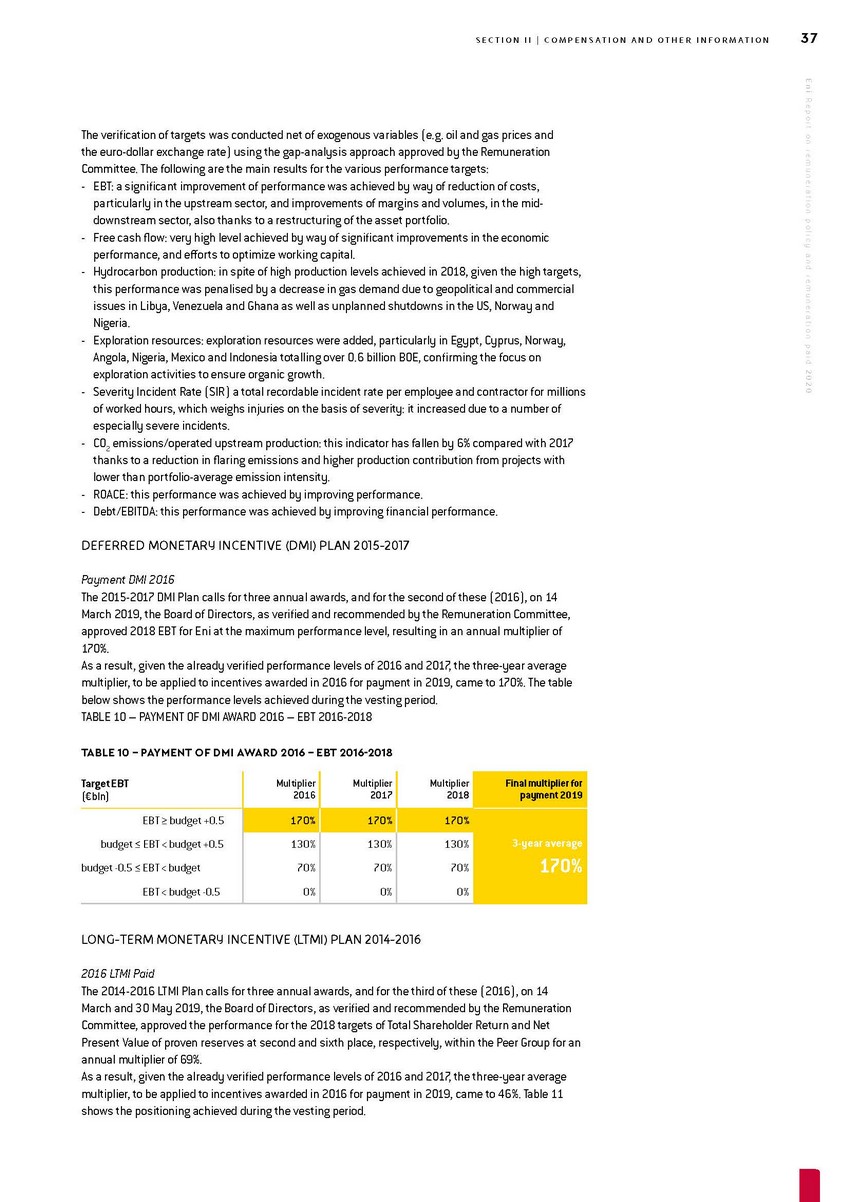 | Eni R eport on r emuner ation policy and r emuner ation paid 20 20 EBT: a significant improvement of performance was achieved by way of reduction of costs, particularly in the upstream sector, and improvements of margins and volumes, in the mid-downstream sector, also thanks to a restructuring of the asset portfolio. Free cash flow: very high level achieved by way of significant improvements in the economic performance, and efforts to optimize working capital. Hydrocarbon production: in spite of high production levels achieved in 2018, given the high targets, this performance was penalised by a decrease in gas demand due to geopolitical and commercial issues in Libya, Venezuela and Ghana as well as unplanned shutdowns in the US, Norway and Nigeria. Exploration resources: exploration resources were added, particularly in Egypt, Cyprus, Norway, Angola, Nigeria, Mexico and Indonesia totalling over 0.6 billion BOE, confirming the focus on exploration activities to ensure organic growth. Severity Incident Rate (SIR) a total recordable incident rate per employee and contractor for millions of worked hours, which weighs injuries on the basis of severity: it increased due to a number of especially severe incidents. CO2 emissions/operated upstream production: this indicator has fallen by 6% compared with 2017 thanks to a reduction in flaring emissions and higher production contribution from projects with lower than portfolio-average emission intensity. ROACE: this performance was achieved by improving performance. Debt/EBITDA: this performance was achieved by improving financial performance. DEFERRED MONETARY INCENTIVE (DMI) PLAN 2015-2017 Payment DMI 2016 The 2015-2017 DMI Plan calls for three annual awards, and for the second of these (2016), on 14 March 2019, the Board of Directors, as verified and recommended by the Remuneration Committee, approved 2018 EBT for Eni at the maximum performance level, resulting in an annual multiplier of 170%. As a result, given the already verified performance levels of 2016 and 2017, the three-year average multiplier, to be applied to incentives awarded in 2016 for payment in 2019, came to 170%. The table below shows the performance levels achieved during the vesting period. TABLE 10 – PAYMENT OF DMI AWARD 2016 – EBT 2016-2018 TABLE 10 – PAYMENT OF DMI AWARD 2016 – EBT 2016-2018 LONG-TERM MONETARY INCENTIVE (LTMI) PLAN 2014-2016 2016 LTMI Paid The 2014-2016 LTMI Plan calls for three annual awards, and for the third of these (2016), on 14 March and 30 May 2019, the Board of Directors, as verified and recommended by the Remuneration Committee, approved the performance for the 2018 targets of Total Shareholder Return and Net Present Value of proven reserves at second and sixth place, respectively, within the Peer Group for an annual multiplier of 69%. As a result, given the already verified performance levels of 2016 and 2017, the three-year average multiplier, to be applied to incentives awarded in 2016 for payment in 2019, came to 46%. Table 11 shows the positioning achieved during the vesting period. |
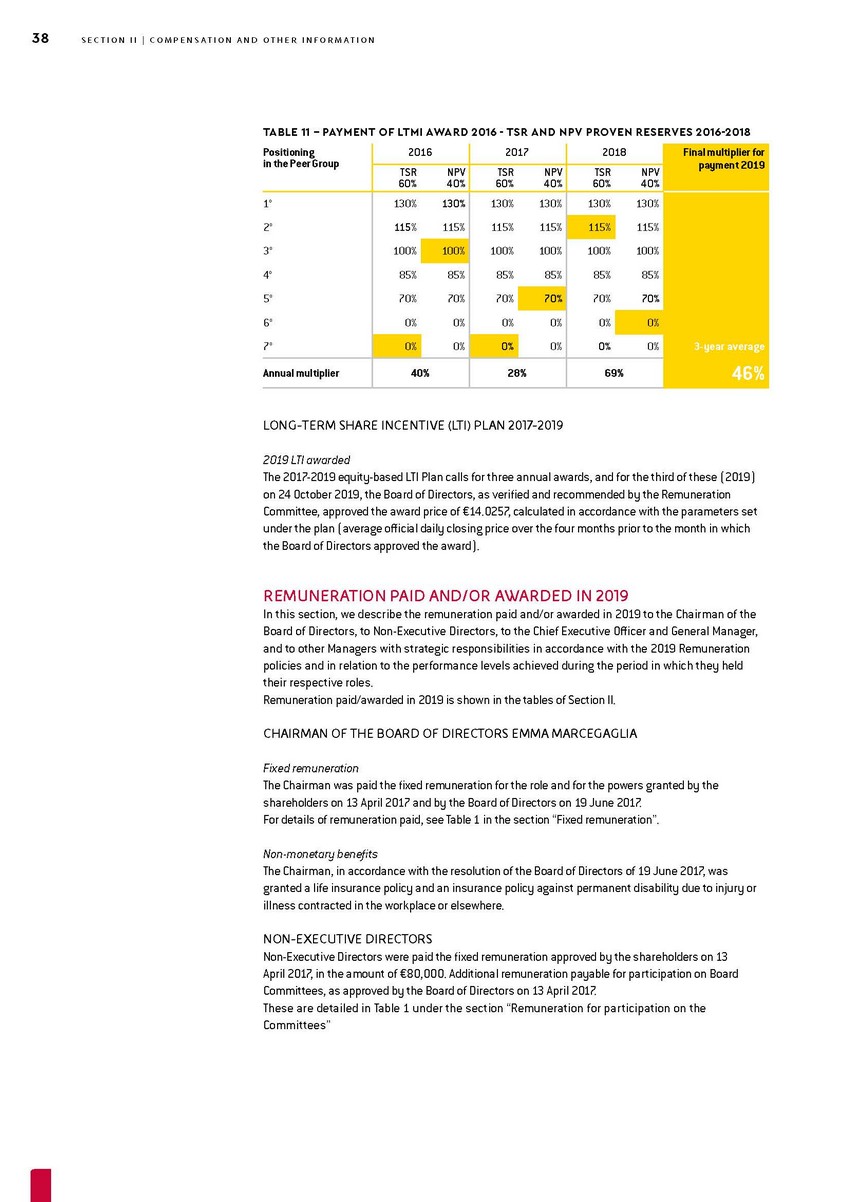 | Final multiplier for payment 2019 3-year average 46% LONG-TERM SHARE INCENTIVE (LTI) PLAN 2017-2019 2019 LTI awarded The 2017-2019 equity-based LTI Plan calls for three annual awards, and for the third of these (2019) on 24 October 2019, the Board of Directors, as verified and recommended by the Remuneration Committee, approved the award price of €14.0257, calculated in accordance with the parameters set under the plan (average official daily closing price over the four months prior to the month in which the Board of Directors approved the award). REMUNERATION PAID AND/OR AWARDED IN 2019 In this section, we describe the remuneration paid and/or awarded in 2019 to the Chairman of the Board of Directors, to Non-Executive Directors, to the Chief Executive Offi er and General Manager, and to other Managers with strategic responsibilities in accordance with the 2019 Remuneration policies and in relation to the performance levels achieved during the period in which they held their respective roles. Remuneration paid/awarded in 2019 is shown in the tables of Section II. CHAIRMAN OF THE BOARD OF DIRECTORS EMMA MARCEGAGLIA Fixed remuneration The Chairman was paid the fixed remuneration for the role and for the powers granted by the shareholders on 13 April 2017 and by the Board of Directors on 19 June 2017. For details of remuneration paid, see Table 1 in the section “Fixed remuneration”. Non-monetary benefits The Chairman, in accordance with the resolution of the Board of Directors of 19 June 2017, was granted a life insurance policy and an insurance policy against permanent disability due to injury or illness contracted in the workplace or elsewhere. NON-EXECUTIVE DIRECTORS Non-Executive Directors were paid the fixed remuneration approved by the shareholders on 13 April 2017, in the amount of €80,000. Additional remuneration payable for participation on Board Committees, as approved by the Board of Directors on 13 April 2017. These are detailed in Table 1 under the section “Remuneration for participation on the Committees” |
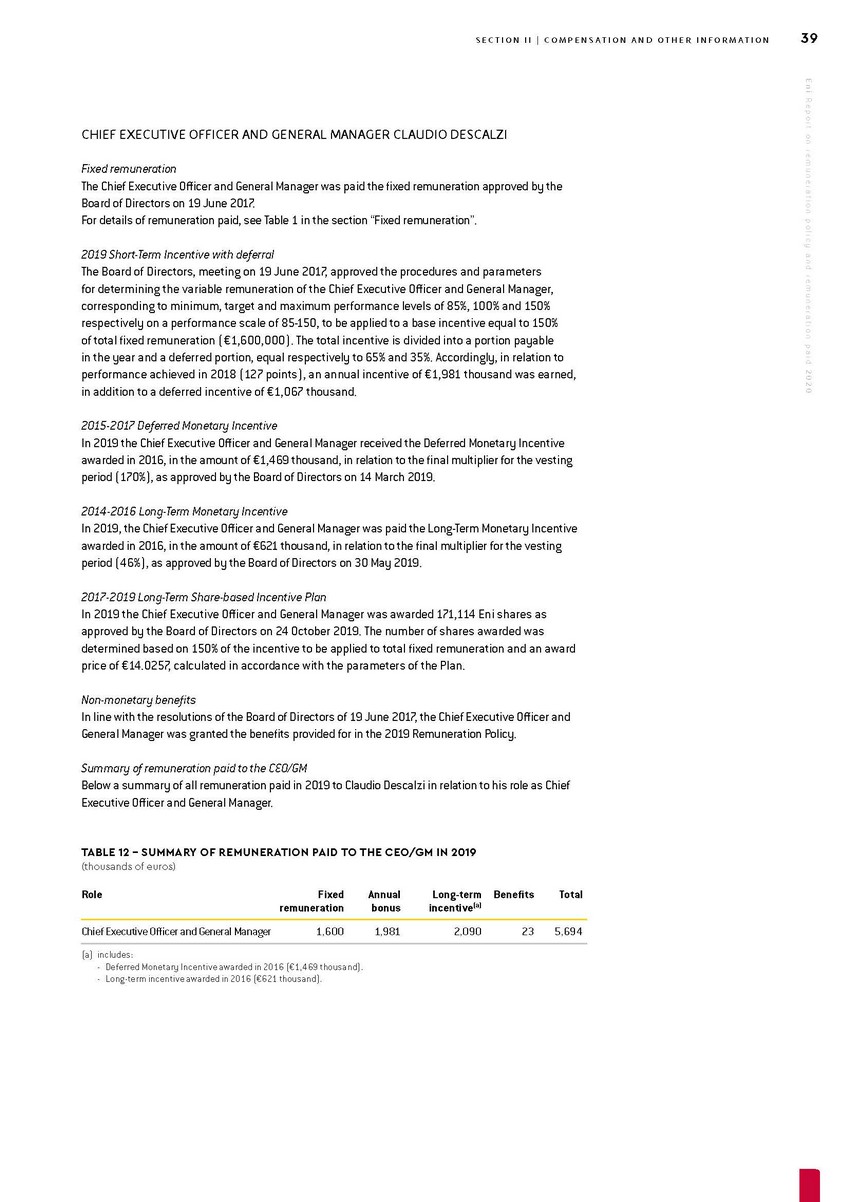 | Eni R eport on r emuner ation policy and r emuner ation paid 20 20 Fixed remuneration The Chief Executive Officer and General Manager was paid the fixed remuneration approved by the Board of Directors on 19 June 2017. For details of remuneration paid, see Table 1 in the section “Fixed remuneration”. 2019 Short-Term Incentive with deferral The Board of Directors, meeting on 19 June 2017, approved the procedures and parameters for determining the variable remuneration of the Chief Executive Offi er and General Manager, corresponding to minimum, target and maximum performance levels of 85%, 100% and 150% respectively on a performance scale of 85-150, to be applied to a base incentive equal to 150% of total fi ed remuneration (€1,600,000). The total incentive is divided into a portion payable in the year and a deferred portion, equal respectively to 65% and 35%. Accordingly, in relation to performance achieved in 2018 (127 points), an annual incentive of €1,981 thousand was earned, in addition to a deferred incentive of €1,067 thousand. 2015-2017 Deferred Monetary Incentive In 2019 the Chief Executive Officer and General Manager received the Deferred Monetary Incentive awarded in 2016, in the amount of €1,469 thousand, in relation to the final multiplier for the vesting period (170%), as approved by the Board of Directors on 14 March 2019. 2014-2016 Long-Term Monetary Incentive In 2019, the Chief Executive Officer and General Manager was paid the Long-Term Monetary Incentive awarded in 2016, in the amount of €621 thousand, in relation to the final multiplier for the vesting period (46%), as approved by the Board of Directors on 30 May 2019. 2017-2019 Long-Term Share-based Incentive Plan In 2019 the Chief Executive Offi er and General Manager was awarded 171,114 Eni shares as approved by the Board of Directors on 24 October 2019. The number of shares awarded was determined based on 150% of the incentive to be applied to total fi ed remuneration and an award price of €14.0257, calculated in accordance with the parameters of the Plan. Non-monetary benefits In line with the resolutions of the Board of Directors of 19 June 2017, the Chief Executive Officer and General Manager was granted the benefits provided for in the 2019 Remuneration Policy. Summary of remuneration paid to the CEO/GM Below a summary of all remuneration paid in 2019 to Claudio Descalzi in relation to his role as Chief Executive Officer and General Manager. TABLE 12 – SUMMARY OF REMUNERATION PAID TO THE CEO/GM IN 2019 (thousands of euros) RoleFixed remuneration Annual bonus Long-term incentive(a) BenefitsTotal Chief Executive Offi er and General Manager1,6001,9812,090235,694 includes: Deferred Monetary Incentive awarded in 2016 (€1,469 thousand). Long-term incentive awarded in 2016 (€621 thousand). |
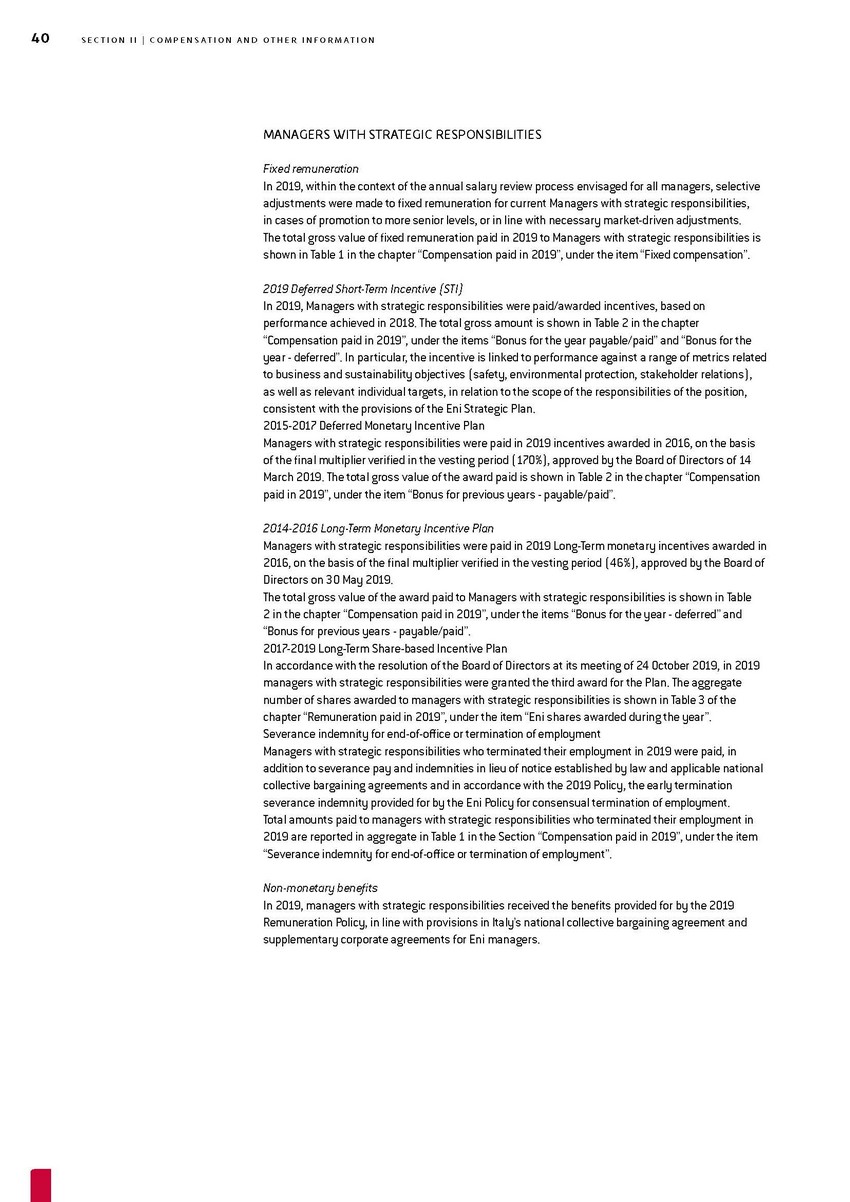 | MANAGERS WITH STRATEGIC RESPONSIBILITIES Fixed remuneration In 2019, within the context of the annual salary review process envisaged for all managers, selective adjustments were made to fixed remuneration for current Managers with strategic responsibilities, in cases of promotion to more senior levels, or in line with necessary market-driven adjustments. The total gross value of fixed remuneration paid in 2019 to Managers with strategic responsibilities is shown in Table 1 in the chapter “Compensation paid in 2019”, under the item “Fixed compensation”. 2019 Deferred Short-Term Incentive (STI) In 2019, Managers with strategic responsibilities were paid/awarded incentives, based on performance achieved in 2018. The total gross amount is shown in Table 2 in the chapter “Compensation paid in 2019”, under the items “Bonus for the year payable/paid” and “Bonus for the year - deferred”. In particular, the incentive is linked to performance against a range of metrics related to business and sustainability objectives (safety, environmental protection, stakeholder relations), as well as relevant individual targets, in relation to the scope of the responsibilities of the position, consistent with the provisions of the Eni Strategic Plan. 2015-2017 Deferred Monetary Incentive Plan Managers with strategic responsibilities were paid in 2019 incentives awarded in 2016, on the basis of the final multiplier verified in the vesting period (170%), approved by the Board of Directors of 14 March 2019. The total gross value of the award paid is shown in Table 2 in the chapter “Compensation paid in 2019”, under the item “Bonus for previous years - payable/paid”. 2014-2016 Long-Term Monetary Incentive Plan Managers with strategic responsibilities were paid in 2019 Long-Term monetary incentives awarded in 2016, on the basis of the final multiplier verified in the vesting period (46%), approved by the Board of Directors on 30 May 2019. The total gross value of the award paid to Managers with strategic responsibilities is shown in Table 2 in the chapter “Compensation paid in 2019”, under the items “Bonus for the year - deferred” and “Bonus for previous years - payable/paid”. 2017-2019 Long-Term Share-based Incentive Plan In accordance with the resolution of the Board of Directors at its meeting of 24 October 2019, in 2019 managers with strategic responsibilities were granted the third award for the Plan. The aggregate number of shares awarded to managers with strategic responsibilities is shown in Table 3 of the chapter “Remuneration paid in 2019”, under the item “Eni shares awarded during the year”. Severance indemnity for end-of-office or termination of employment Managers with strategic responsibilities who terminated their employment in 2019 were paid, in addition to severance pay and indemnities in lieu of notice established by law and applicable national collective bargaining agreements and in accordance with the 2019 Policy, the early termination severance indemnity provided for by the Eni Policy for consensual termination of employment. Total amounts paid to managers with strategic responsibilities who terminated their employment in 2019 are reported in aggregate in Table 1 in the Section “Compensation paid in 2019”, under the item “Severance indemnity for end-of-office or termination of employment”. Non-monetary benefits In 2019, managers with strategic responsibilities received the benefits provided for by the 2019 Remuneration Policy, in line with provisions in Italy’s national collective bargaining agreement and supplementary corporate agreements for Eni managers. |
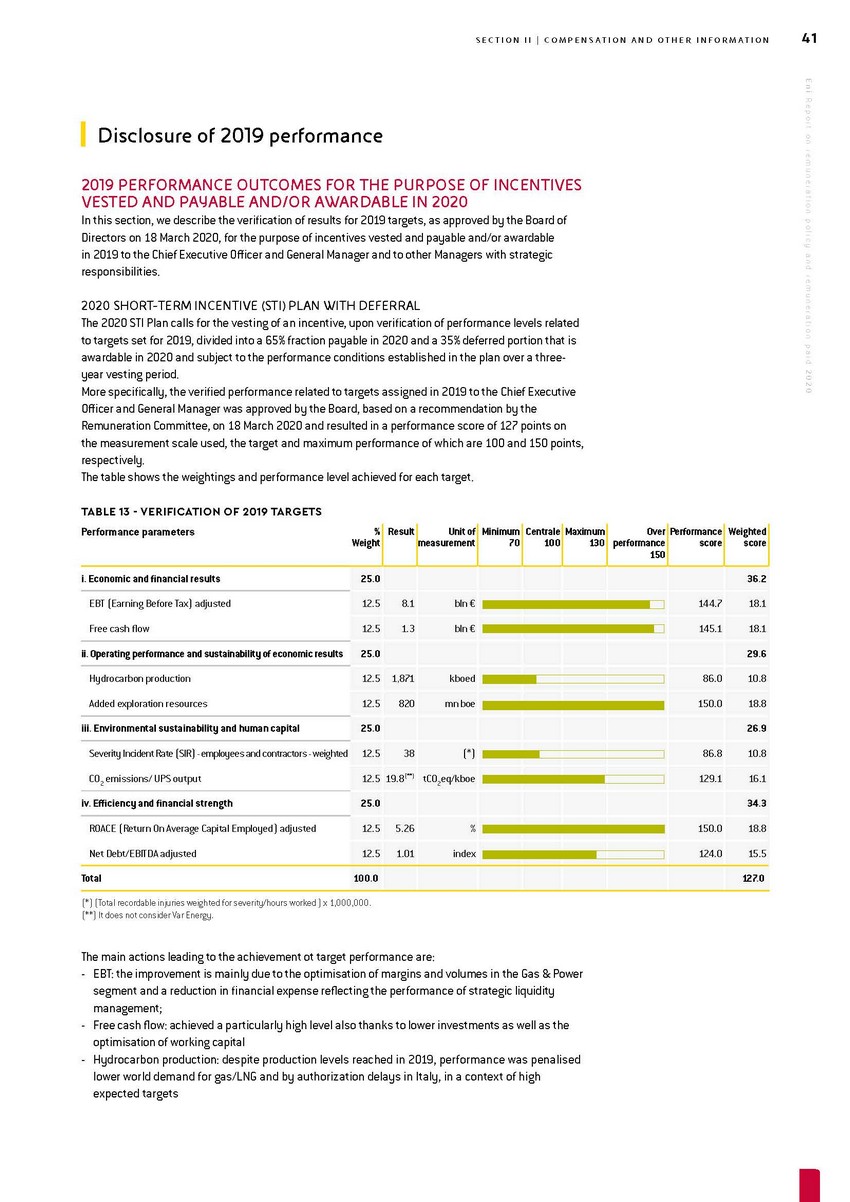 | Eni R eport on r emuner ation policy and r emuner ation paid 20 20 2019 PERFORMANCE OUTCOMES FOR THE PURPOSE OF INCENTIVES VESTED AND PAYABLE AND/OR AWARDABLE IN 2020 In this section, we describe the verification of results for 2019 targets, as approved by the Board of Directors on 18 March 2020, for the purpose of incentives vested and payable and/or awardable in 2019 to the Chief Executive Officer and General Manager and to other Managers with strategic responsibilities. 2020 SHORT-TERM INCENTIVE (STI) PLAN WITH DEFERRAL The 2020 STI Plan calls for the vesting of an incentive, upon verification of performance levels related to targets set for 2019, divided into a 65% fraction payable in 2020 and a 35% deferred portion that is awardable in 2020 and subject to the performance conditions established in the plan over a three-year vesting period. More specifically, the verified performance related to targets assigned in 2019 to the Chief Executive Officer and General Manager was approved by the Board, based on a recommendation by the Remuneration Committee, on 18 March 2020 and resulted in a performance score of 127 points on the measurement scale used, the target and maximum performance of which are 100 and 150 points, respectively. The table shows the weightings and performance level achieved for each target. TABLE 13 - VERIFICATION OF 2019 TARGETS (*) (Total recordable injuries weighted for severity/hours worked ) x 1,000,000. (**) It does not consider Var Energy. The main actions leading to the achievement ot target performance are: EBT: the improvement is mainly due to the optimisation of margins and volumes in the Gas & Power segment and a reduction in financial expense reflecting the performance of strategic liquidity management; Free cash flow: achieved a particularly high level also thanks to lower investments as well as the optimisation of working capital Hydrocarbon production: despite production levels reached in 2019, performance was penalised lower world demand for gas/LNG and by authorization delays in Italy, in a context of high expected targets |
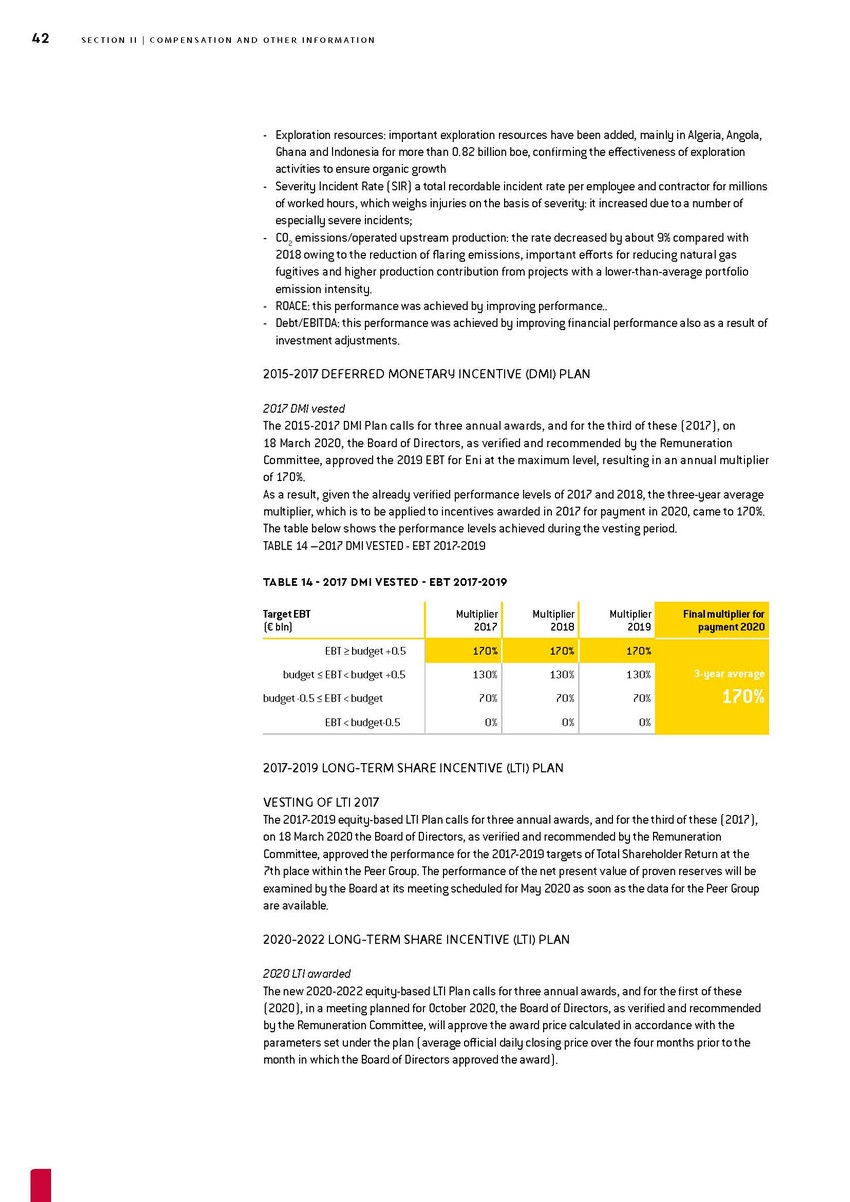 | Exploration resources: important exploration resources have been added, mainly in Algeria, Angola, Ghana and Indonesia for more than 0.82 billion boe, confirming the effectiveness of exploration activities to ensure organic growth Severity Incident Rate (SIR) a total recordable incident rate per employee and contractor for millions of worked hours, which weighs injuries on the basis of severity: it increased due to a number of especially severe incidents; CO2 emissions/operated upstream production: the rate decreased by about 9% compared with 2018 owing to the reduction of flaring emissions, important eff rts for reducing natural gas fugitives and higher production contribution from projects with a lower-than-average portfolio emission intensity. ROACE: this performance was achieved by improving performance.. Debt/EBITDA: this performance was achieved by improving financial performance also as a result of investment adjustments. 2015-2017 DEFERRED MONETARY INCENTIVE (DMI) PLAN 2017 DMI vested The 2015-2017 DMI Plan calls for three annual awards, and for the third of these (2017), on 18 March 2020, the Board of Directors, as verified and recommended by the Remuneration Committee, approved the 2019 EBT for Eni at the maximum level, resulting in an annual multiplier of 170%. As a result, given the already verified performance levels of 2017 and 2018, the three-year average multiplier, which is to be applied to incentives awarded in 2017 for payment in 2020, came to 170%. The table below shows the performance levels achieved during the vesting period. TABLE 14 –2017 DMI VESTED - EBT 2017-2019 TABLE 14 - 2017 DMI VESTED - EBT 2017-2019 2017-2019 LONG-TERM SHARE INCENTIVE (LTI) PLAN VESTING OF LTI 2017 The 2017-2019 equity-based LTI Plan calls for three annual awards, and for the third of these (2017), on 18 March 2020 the Board of Directors, as verified and recommended by the Remuneration Committee, approved the performance for the 2017-2019 targets of Total Shareholder Return at the 7th place within the Peer Group. The performance of the net present value of proven reserves will be examined by the Board at its meeting scheduled for May 2020 as soon as the data for the Peer Group are available. 2020-2022 LONG-TERM SHARE INCENTIVE (LTI) PLAN 2020 LTI awarded The new 2020-2022 equity-based LTI Plan calls for three annual awards, and for the first of these (2020), in a meeting planned for October 2020, the Board of Directors, as verified and recommended by the Remuneration Committee, will approve the award price calculated in accordance with the parameters set under the plan (average official daily closing price over the four months prior to the month in which the Board of Directors approved the award). |
 | Eni R eport on r emuner ation policy and r emuner ation paid 20 20 This section describes the incentives vested in in relation to the verification of 2019 targets and payable and/or awardable in 2020 to the Chief Executive Officer and General Manager and to other Managers with strategic responsibilities. CHIEF EXECUTIVE OFFICER AND GENERAL MANAGER CLAUDIO DESCALZI 2020 Short-Term Incentive with deferral An annual incentive (annual portion) of €1,981 thousand in addition to a deferred incentive (deferred portion) of €1,067 thousand vested in favour of the Chief Executive Officer and General Manager, calculated using the procedures and parameters approved by the Board of Directors on 19 June 2017 and in relation to performance achieved in 2019 (127 points) as approved by the board of Directors on 18 March 2020. 2015-2017 Deferred Monetary Incentive The Chief Executive Officer and General Manager earned the incentive awarded in 2017, payable in 2020, in the amount of €1,469. thousand, vested based on the final multiplier verified over the vesting period (170%), as approved by the Board of Directors on 18 March 2020. MANAGERS WITH STRATEGIC RESPONSIBILITIES 2020 Short-Term Incentive with deferral Managers with strategic responsibilities earned incentives payable/awardable in 2020 based on performance achieved in 2019, in the aggregate amounts that will be disclosed in the 2021 Remuneration Report. More specifically, these incentives were related to company performance and a series of business targets, sustainability targets (i.e. safety, environmental protection, relations with stakeholders), and individual targets assigned in relation to the scope of responsibilities of the given role, in line with the provisions of Eni’s Strategic Plan. 2015-2017 Deferred Monetary Incentive Managers with strategic responsibilities earned the incentive awarded in 2017, payable in 2020, vested based on the final multiplier verified over the vesting period (170%), as approved by the Board of Directors on 18 March 2020. The total aggregate amount of such incentives will be published in 2021 Remuneration Report. |
 | 44 S E C T I O N I I | R E M U N E R A T I O N A N D O T H E R I N F O RM A T I O N Remuneration paid in 2019 TABLE 1 - REMUNERATION PAID TO DIRECTORS, STATUTORY AUDITORS, THE CHIEF EXECUTIVE OFFICER AND GENERAL MANAGER AND OTHER MANAGERS WITH STRATEGIC RESPONSIBILITIES The table below reports the remuneration paid to Directors, Statutory Auditors, the Chief Executive Officer and General Manager and, in aggregate form, Managers with strategic responsibilities. The remuneration received from subsidiaries and/or associates, except that waived or paid to the company, are shown separately. All parties who filled these roles during the period are included, even if they only held office for a fraction of the year. In particular: - the column labelled "Fixed Remuneration" reports fixed remuneration and fixed salary from employment due for the year (on an accrual basis), gross of social security contributions and taxes to be paid by the employee. Details of the compensation are provided in the notes, and any indemnities or payments with reference to the employment relationship are indicated separately; - the column labelled "Remuneration for participation on Committees" reports (on an accrual basis) the compensation due to Directors for participation in Committees established by the Board. In the notes, compensation for each Committee in which each Director participates is indicated separately; - the column labelled "Variable non-equity remuneration" under the item "Bonuses and other incentives" shows the incentives paid during the year due to rights vested following the assessment and approval of related performance results by relevant corporate bodies, in accordance with that specified, in greater detail, in the Table "Monetary incentive plans for the Chief Executive Officer and General Manager and other Managers with strategic responsibilities"; - the column labelled "Profit-sharing" does not show any figures since no profit- sharing mechanisms are in place; - the column labelled "Benefits in kind" reports (on an accrual and taxability basis) the value of any fringe benefits awarded; - the column labelled "Other remuneration" reports (on an accrual basis) any other remuneration deriving from other services provided; - the column labelled "Total" reports the sum of the amounts of all the previous items; - the column labelled "Fair value of equity compensation" reports the relevant fair value for the year related to the existing stock option plans, estimated in accordance with the international accounting standards that allocate the related cost in the vesting period; - the column labelled "Severance indemnity for end-of-office or termination of employment" reports indemnities accrued, even if not yet paid, for terminations that occurred during the financial year, or in relation to the end of term in office and/or employment. TABLE 1 - REMUNERATION PAID TO DIRECTORS, STATUTORY AUDITORS, THE CHIEF EXECUTIVE OFFICER AND GENERAL MANAGER AND OTHER MANAGERS WITH STRATEGIC RESPONSIBILITIES (amounts in euro thousands) Variable non-equity remuneration Name Note Position Period for which the position was held Expiration of office(*) Fixed remuneration Remuneration for participation in Committees Bonuses and other incentives Profit sharing Non-monetary benefits Other remuneration Total Fair value of equity-based remuneration Severance indemnity for end of office or termination of employment Board of Directors Emma Marcegaglia (1) Chairman 01.01 - 31.12 2020 500(a) 500 Claudio Descalzi (2) CEO/General manager 01.01 - 31.12 2020 1,600(a) 4,071(b) 23(c) 5,694 933 Andrea Gemma (3) Director 01.01 - 31.12 2020 56(a) 90(b) 146 Pietro Angelo Guindani (4) Director 01.01 - 31.12 2020 80(a) 85(b) 165 Karina Litvack (5) Director 01.01 - 31.12 2020 80(a) 85(b) 165 Alessandro Lorenzi (6) Director 01.01 - 31.12 2020 80(a) 110(b) 190 Diva Moriani (7) Director 01.01 - 31.12 2020 80(a) 125(b) 205 Fabrizio Pagani (8) Director 01.01 - 31.12 2020 80(a) 65(b) 50(c) 195 Domenico Livio Trombone (9) Director 01.01 - 31.12 2020 80(a) 65(b) 145 Board of Statutory Auditors Rosalba Casiraghi (10) Chairman 01.01 - 31.12 2020 80(a) 80 Enrico Maria Bignami (11) Statutory auditor 01.01 - 31.12 2020 70(a) 70 Paola Camagni (12) Statutory auditor 01.01 - 31.12 2020 70(a) 112(b) 182 Andrea Parolini (13) Statutory auditor 01.01 - 31.12 2020 70(a) 70 Marco Seracini (14) Statutory auditor 01.01 - 31.12 2020 70(a) 127(b) 197 Other Managers with strategic responsibilities(**) (15) Remuneration in the company that prepares the Financial Statements 9,605 13,588 264 155 23,612 1,430 4,126 Remuneration from subsidiaries and associates Total 9,605(a) 13,588(b) 264(c) 155(d) 23,612 1,430 4,126(e) 12,601 625 17,659 287 444 31,616 2,363 4,126 |
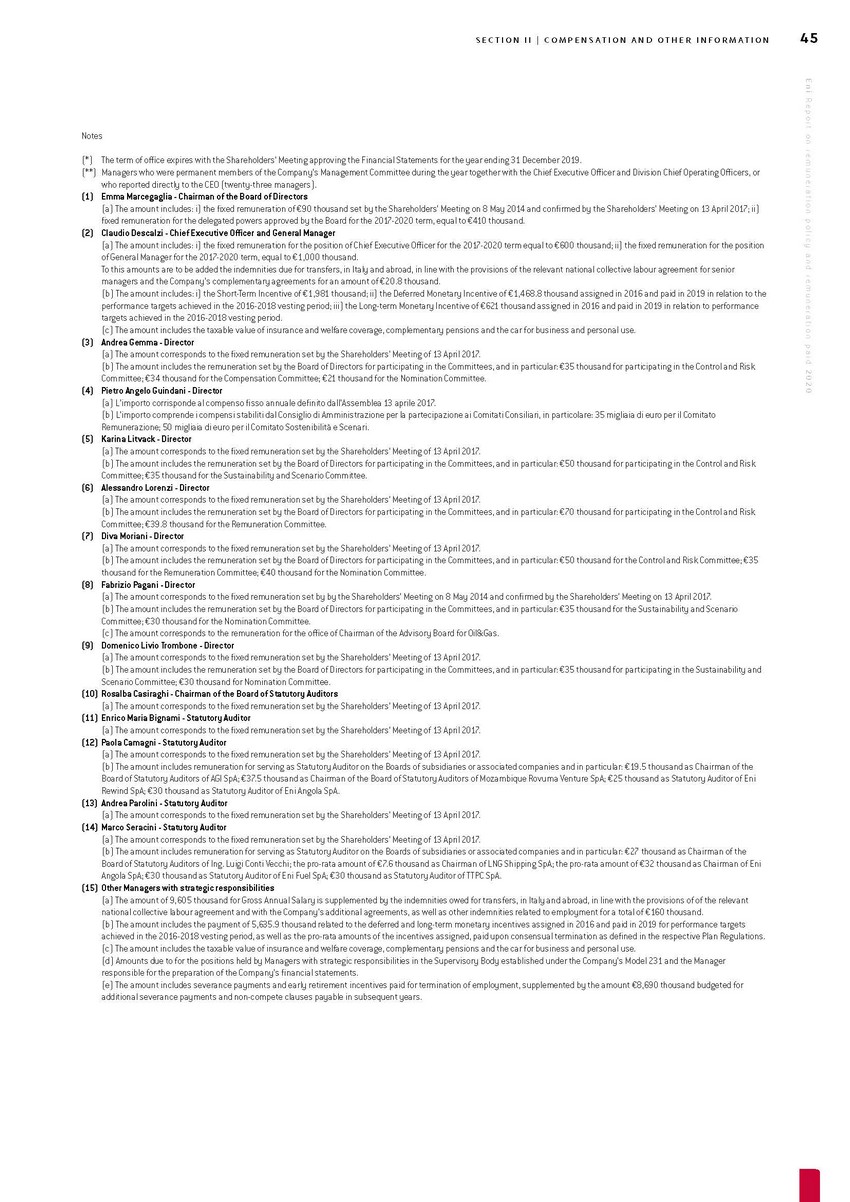 | Eni R eport on r emuner ation policy and r emuner ation paid 20 20 (*) The term of office expires with the Shareholders' Meeting approving the Financial Statements for the year ending 31 December 2019. (**) Managers who were permanent members of the Company's Management Committee during the year together with the Chief Executive Officer and Division Chief Operating Officers, or who reported directly to the CEO (twenty-three managers). Emma Marcegaglia - Chairman of the Board of Directors The amount includes: i) the fixed remuneration of €90 thousand set by the Shareholders' Meeting on 8 May 2014 and confirmed by the Shareholders' Meeting on 13 April 2017; ii) fixed remuneration for the delegated powers approved by the Board for the 2017-2020 term, equal to €410 thousand. Claudio Descalzi - Chief Executive Officer and General Manager The amount includes: i) the fixed remuneration for the position of Chief Executive Officer for the 2017-2020 term equal to €600 thousand; ii) the fixed remuneration for the position of General Manager for the 2017-2020 term, equal to €1,000 thousand. To this amounts are to be added the indemnities due for transfers, in Italy and abroad, in line with the provisions of the relevant national collective labour agreement for senior managers and the Company's complementary agreements for an amount of €20.8 thousand. The amount includes: i) the Short-Term Incentive of €1,981 thousand; ii) the Deferred Monetary Incentive of €1,468.8 thousand assigned in 2016 and paid in 2019 in relation to the performance targets achieved in the 2016-2018 vesting period; iii) the Long-term Monetary Incentive of €621 thousand assigned in 2016 and paid in 2019 in relation to performance targets achieved in the 2016-2018 vesting period. The amount includes the taxable value of insurance and welfare coverage, complementary pensions and the car for business and personal use. Andrea Gemma - Director The amount corresponds to the fixed remuneration set by the Shareholders' Meeting of 13 April 2017. The amount includes the remuneration set by the Board of Directors for participating in the Committees, and in particular: €35 thousand for participating in the Control and Risk Committee; €34 thousand for the Compensation Committee; €21 thousand for the Nomination Committee. Pietro Angelo Guindani - Director L'importo corrisponde al compenso fisso annuale definito dall'Assemblea 13 aprile 2017. L'importo comprende i compensi stabiliti dal Consiglio di Amministrazione per la partecipazione ai Comitati Consiliari, in particolare: 35 migliaia di euro per il Comitato Remunerazione; 50 migliaia di euro per il Comitato Sostenibilità e Scenari. Karina Litvack - Director The amount corresponds to the fixed remuneration set by the Shareholders' Meeting of 13 April 2017. The amount includes the remuneration set by the Board of Directors for participating in the Committees, and in particular: €50 thousand for participating in the Control and Risk Committee; €35 thousand for the Sustainability and Scenario Committee. Alessandro Lorenzi - Director The amount corresponds to the fixed remuneration set by the Shareholders' Meeting of 13 April 2017. The amount includes the remuneration set by the Board of Directors for participating in the Committees, and in particular: €70 thousand for participating in the Control and Risk Committee; €39.8 thousand for the Remuneration Committee. Diva Moriani - Director The amount corresponds to the fixed remuneration set by the Shareholders' Meeting of 13 April 2017. The amount includes the remuneration set by the Board of Directors for participating in the Committees, and in particular: €50 thousand for the Control and Risk Committee; €35 thousand for the Remuneration Committee; €40 thousand for the Nomination Committee. Fabrizio Pagani - Director The amount corresponds to the fixed remuneration set by by the Shareholders' Meeting on 8 May 2014 and confirmed by the Shareholders' Meeting on 13 April 2017. The amount includes the remuneration set by the Board of Directors for participating in the Committees, and in particular: €35 thousand for the Sustainability and Scenario Committee; €30 thousand for the Nomination Committee. The amount corresponds to the remuneration for the office of Chairman of the Advisory Board for Oil&Gas. Domenico Livio Trombone - Director The amount corresponds to the fixed remuneration set by the Shareholders' Meeting of 13 April 2017. The amount includes the remuneration set by the Board of Directors for participating in the Committees, and in particular: €35 thousand for participating in the Sustainability and Scenario Committee; €30 thousand for Nomination Committee. Rosalba Casiraghi - Chairman of the Board of Statutory Auditors The amount corresponds to the fixed remuneration set by the Shareholders' Meeting of 13 April 2017. Enrico Maria Bignami - Statutory Auditor The amount corresponds to the fixed remuneration set by the Shareholders' Meeting of 13 April 2017. Paola Camagni - Statutory Auditor The amount corresponds to the fixed remuneration set by the Shareholders' Meeting of 13 April 2017. The amount includes remuneration for serving as Statutory Auditor on the Boards of subsidiaries or associated companies and in particular: €19.5 thousand as Chairman of the Board of Statutory Auditors of AGI SpA; €37.5 thousand as Chairman of the Board of Statutory Auditors of Mozambique Rovuma Venture SpA; €25 thousand as Statutory Auditor of Eni Rewind SpA; €30 thousand as Statutory Auditor of Eni Angola SpA. Andrea Parolini - Statutory Auditor The amount corresponds to the fixed remuneration set by the Shareholders' Meeting of 13 April 2017. Marco Seracini - Statutory Auditor The amount corresponds to the fixed remuneration set by the Shareholders' Meeting of 13 April 2017. The amount includes remuneration for serving as Statutory Auditor on the Boards of subsidiaries or associated companies and in particular: €27 thousand as Chairman of the Board of Statutory Auditors of Ing. Luigi Conti Vecchi; the pro-rata amount of €7.6 thousand as Chairman of LNG Shipping SpA; the pro-rata amount of €32 thousand as Chairman of Eni Angola SpA; €30 thousand as Statutory Auditor of Eni Fuel SpA; €30 thousand as Statutory Auditor of TTPC SpA. Other Managers with strategic responsibilities The amount of 9,605 thousand for Gross Annual Salary is supplemented by the indemnities owed for transfers, in Italy and abroad, in line with the provisions of of the relevant national collective labour agreement and with the Company's additional agreements, as well as other indemnities related to employment for a total of €160 thousand. The amount includes the payment of 5,635.9 thousand related to the deferred and long-term monetary incentives assigned in 2016 and paid in 2019 for performance targets achieved in the 2016-2018 vesting period, as well as the pro-rata amounts of the incentives assigned, paid upon consensual termination as defined in the respective Plan Regulations. The amount includes the taxable value of insurance and welfare coverage, complementary pensions and the car for business and personal use. Amounts due to for the positions held by Managers with strategic responsibilities in the Supervisory Body established under the Company's Model 231 and the Manager responsible for the preparation of the Company's financial statements. The amount includes severance payments and early retirement incentives paid for termination of employment, supplemented by the amount €8,690 thousand budgeted for additional severance payments and non-compete clauses payable in subsequent years. |
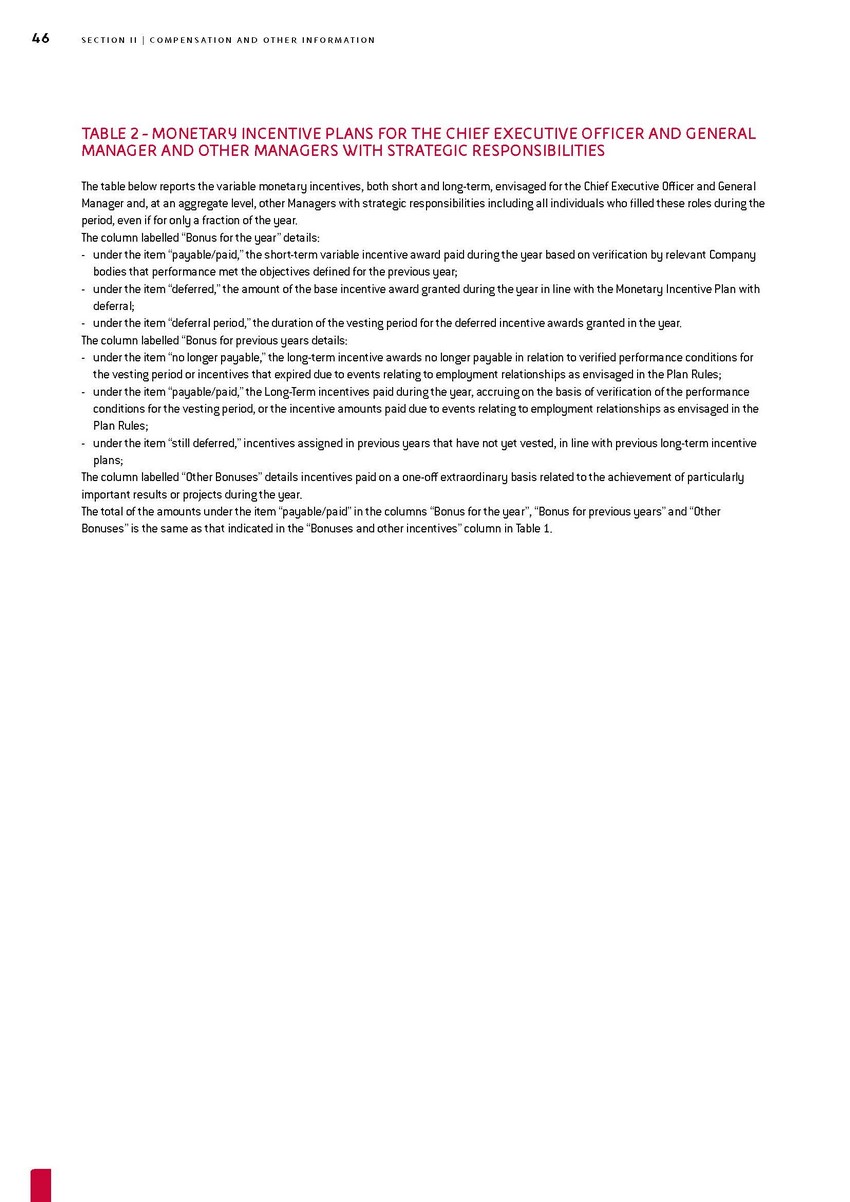 | TABLE 2 - MONETARY INCENTIVE PLANS FOR THE CHIEF EXECUTIVE OFFICER AND GENERAL MANAGER AND OTHER MANAGERS WITH STRATEGIC RESPONSIBILITIES The table below reports the variable monetary incentives, both short and long-term, envisaged for the Chief Executive Officer and General Manager and, at an aggregate level, other Managers with strategic responsibilities including all individuals who filled these roles during the period, even if for only a fraction of the year. The column labelled “Bonus for the year” details: under the item “payable/paid,” the short-term variable incentive award paid during the year based on verification by relevant Company bodies that performance met the objectives defined for the previous year; under the item “deferred,” the amount of the base incentive award granted during the year in line with the Monetary Incentive Plan with deferral; under the item “deferral period,” the duration of the vesting period for the deferred incentive awards granted in the year. The column labelled “Bonus for previous years details: under the item “no longer payable,” the long-term incentive awards no longer payable in relation to verified performance conditions for the vesting period or incentives that expired due to events relating to employment relationships as envisaged in the Plan Rules; under the item “payable/paid,” the Long-Term incentives paid during the year, accruing on the basis of verification of the performance conditions for the vesting period, or the incentive amounts paid due to events relating to employment relationships as envisaged in the Plan Rules; under the item “still deferred,” incentives assigned in previous years that have not yet vested, in line with previous long-term incentive plans; The column labelled “Other Bonuses” details incentives paid on a one-off extraordinary basis related to the achievement of particularly important results or projects during the year. The total of the amounts under the item “payable/paid” in the columns “Bonus for the year”, “Bonus for previous years” and “Other Bonuses” is the same as that indicated in the “Bonuses and other incentives” column in Table 1. |
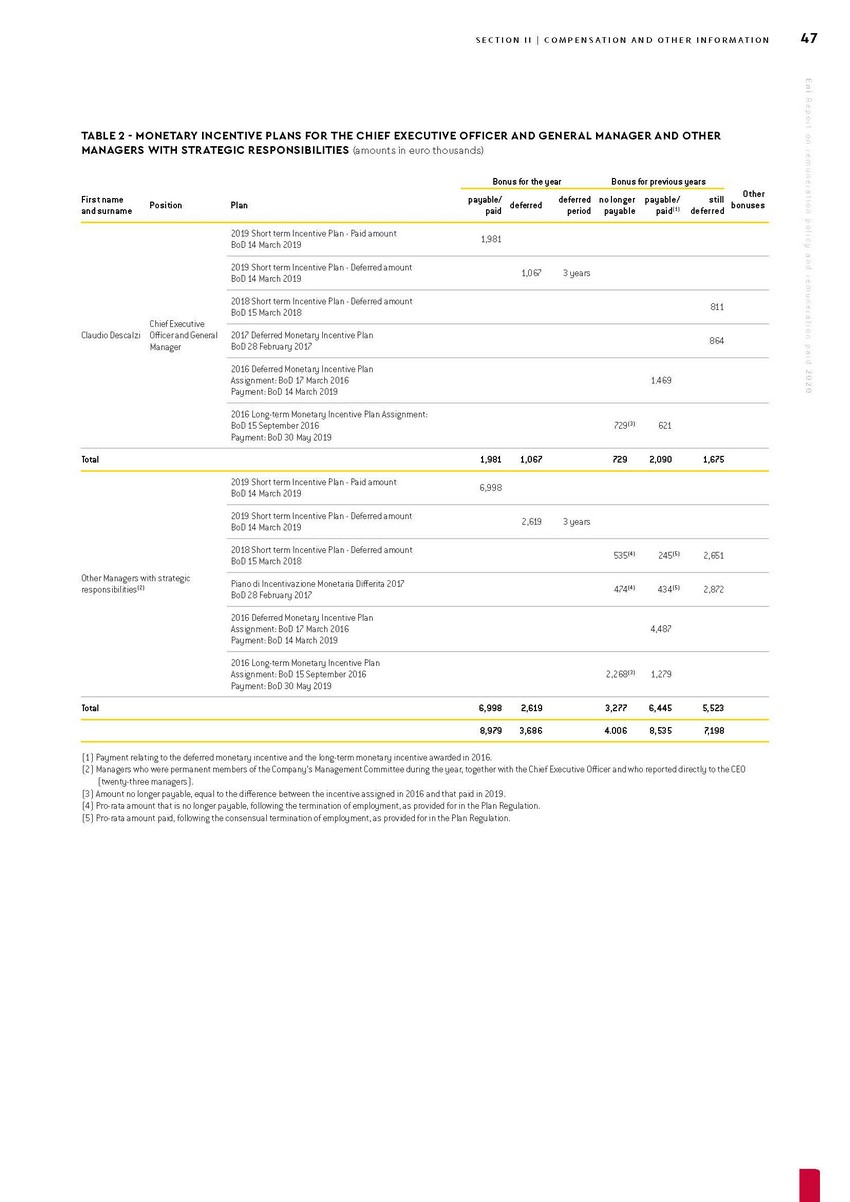 | Eni R eport on r emuner ation policy and r emuner ation paid 20 20 MANAGERS WITH STRATEGIC RESPONSIBILITIES (amounts in euro thousands) Bonus for the yearBonus for previous years Other First name and surnamePositionPlan payable/ paid deferred deferred period no longer payable payable/ paid(1) still bonuses deferred 2019 Short term Incentive Plan - Paid amount BoD 14 March 20191,981 2019 Short term Incentive Plan - Deferred amount BoD 14 March 20191,0673 years Claudio Descalzi Chief Executive Offi er and General Manager 2018 Short term Incentive Plan - Deferred amount BoD 15 March 2018811 2017 Deferred Monetary Incentive Plan BoD 28 February 2017864 2016 Deferred Monetary Incentive Plan Assignment: BoD 17 March 2016 Payment: BoD 14 March 2019 1.469 2016 Long-term Monetary Incentive Plan Assignment: BoD 15 September 2016 Payment: BoD 30 May 2019 729(3)621 Total1,9811,0677292,0901,675 2019 Short term Incentive Plan - Paid amount BoD 14 March 20196,998 2019 Short term Incentive Plan - Deferred amount BoD 14 March 20192,6193 years 2016 Deferred Monetary Incentive Plan Assignment: BoD 17 March 2016 Payment: BoD 14 March 2019 4,487 2016 Long-term Monetary Incentive Plan Assignment: BoD 15 September 2016 Payment: BoD 30 May 2019 2,268(3)1,279 Total6,9982,6193,2776,4455,523 8,9793,6864.0068,5357,198 Payment relating to the deferred monetary incentive and the long-term monetary incentive awarded in 2016. Managers who were permanent members of the Company's Management Committee during the year, together with the Chief Executive Officer and who reported directly to the CEO (twenty-three managers). Amount no longer payable, equal to the difference between the incentive assigned in 2016 and that paid in 2019. Pro-rata amount that is no longer payable, following the termination of employment, as provided for in the Plan Regulation. Pro-rata amount paid, following the consensual termination of employment, as provided for in the Plan Regulation. |
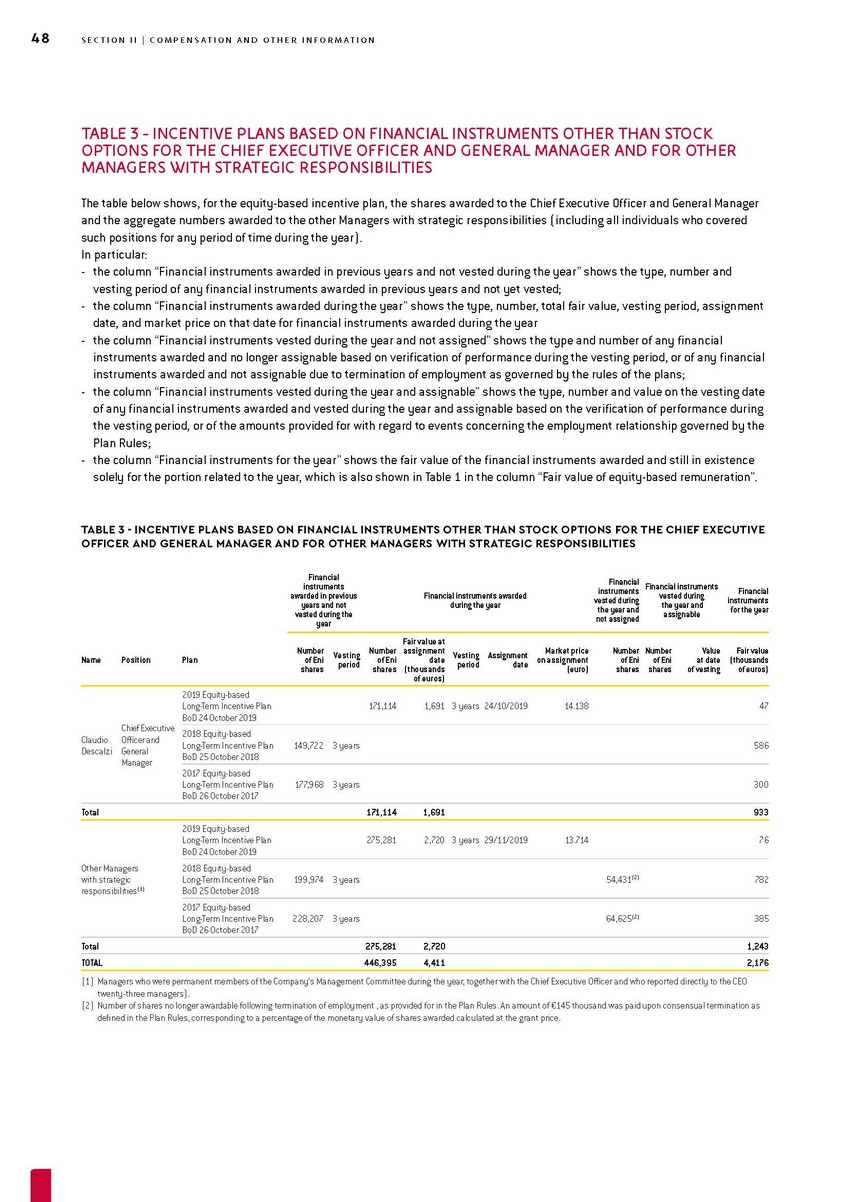 | TABLE 3 - INCENTIVE PLANS BASED ON FINANCIAL INSTRUMENTS OTHER THAN STOCK OPTIONS FOR THE CHIEF EXECUTIVE OFFICER AND GENERAL MANAGER AND FOR OTHER MANAGERS WITH STRATEGIC RESPONSIBILITIES The table below shows, for the equity-based incentive plan, the shares awarded to the Chief Executive Officer and General Manager and the aggregate numbers awarded to the other Managers with strategic responsibilities (including all individuals who covered such positions for any period of time during the year). In particular: the column “Financial instruments awarded in previous years and not vested during the year” shows the type, number and vesting period of any financial instruments awarded in previous years and not yet vested; the column “Financial instruments awarded during the year” shows the type, number, total fair value, vesting period, assignment date, and market price on that date for financial instruments awarded during the year the column “Financial instruments vested during the year and not assigned” shows the type and number of any financial instruments awarded and no longer assignable based on verification of performance during the vesting period, or of any financial instruments awarded and not assignable due to termination of employment as governed by the rules of the plans; the column “Financial instruments vested during the year and assignable” shows the type, number and value on the vesting date of any financial instruments awarded and vested during the year and assignable based on the verification of performance during the vesting period, or of the amounts provided for with regard to events concerning the employment relationship governed by the Plan Rules; the column “Financial instruments for the year” shows the fair value of the financial instruments awarded and still in existence solely for the portion related to the year, which is also shown in Table 1 in the column “Fair value of equity-based remuneration”. TABLE 3 - INCENTIVE PLANS BASED ON FINANCIAL INSTRUMENTS OTHER THAN STOCK OPTIONS FOR THE CHIEF EXECUTIVE OFFICER AND GENERAL MANAGER AND FOR OTHER MANAGERS WITH STRATEGIC RESPONSIBILITIES Financial instruments Financial Financial instruments instruments Financial awarded in previous years and not vested during the year Financial instruments awarded during the year Fair value at vested during the year and not assigned vested during the year and assignable instruments for the year Number Vesting Number assignment Vesting Assignment Market price Number Number Value Fair value NamePositionPlan of Eni shares period of Eni shares date (thousands of euros) period date on assignment (euro) of Eni shares of Eni shares at date of vesting (thousands of euros) Claudio Descalzi Chief Executive Offi er and General Manager 2019 Equity-based Long-Term Incentive Plan 171,114 1,691 3 years 24/10/2019 14.138 47 BoD 24 October 2019 2018 Equity-based Long-Term Incentive Plan 149,722 3 years 586 BoD 25 October 2018 Long-Term Incentive Plan BoD 26 October 2017 177,968 3 years300 Total171,1141,691933 2019 Equity-based Other Managers with strategic responsibilities(1) Long-Term Incentive Plan BoD 24 October 2019 2018 Equity-based Long-Term Incentive Plan BoD 25 October 2018 2017 Equity-based Long-Term Incentive Plan BoD 26 October 2017 275,2812,720 3 years 29/11/201913.71476 199,974 3 years54,431(2)782 228,207 3 years64,625(2)385 Total275,2812,7201,243 TOTAL446,3954,4112,176 Managers who were permanent members of the Company's Management Committee during the year, together with the Chief Executive Officer and who reported directly to the CEO twenty-three managers). Number of shares no longer awardable following termination of employment , as provided for in the Plan Rules. An amount of €145 thousand was paid upon consensual termination as defined in the Plan Rules, corresponding to a percentage of the monetary value of shares awarded calculated at the grant price. |
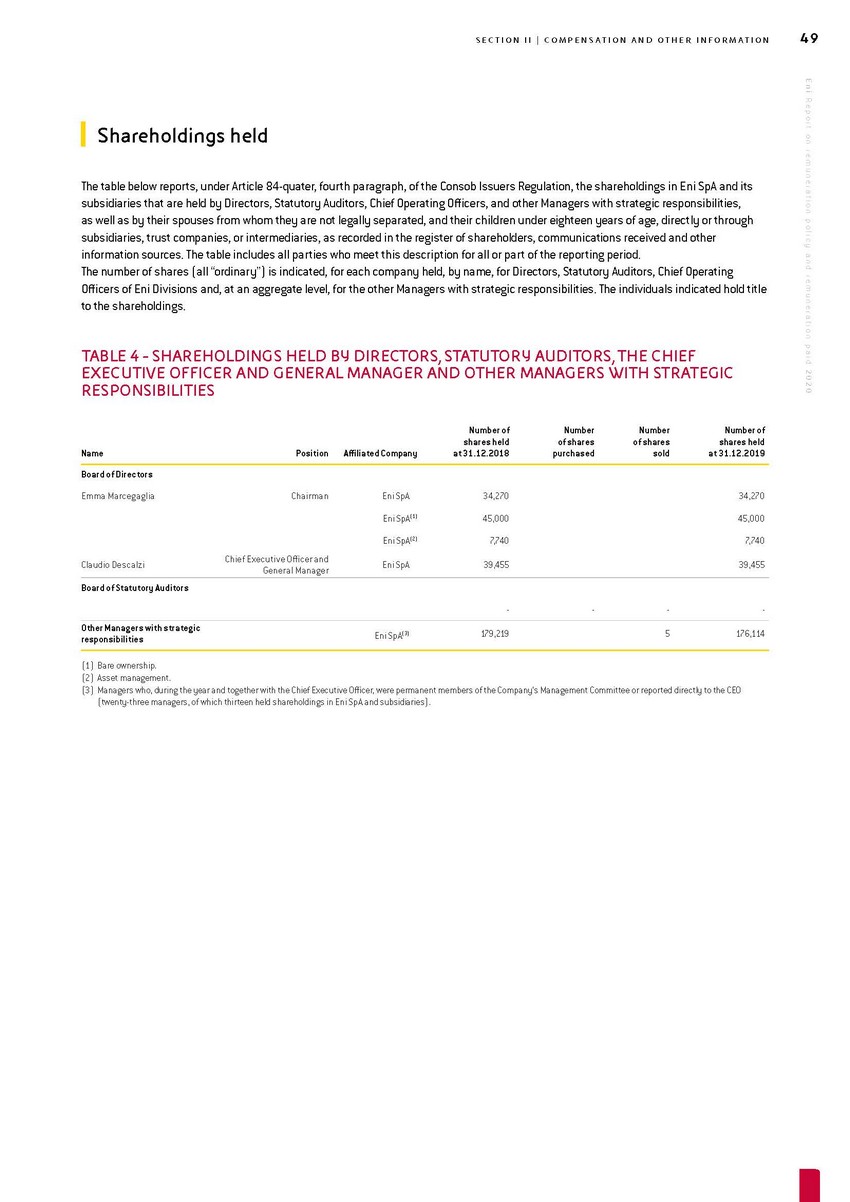 | Eni R eport on r emuner ation policy and r emuner ation paid 20 20 The table below reports, under Article 84-quater, fourth paragraph, of the Consob Issuers Regulation, the shareholdings in Eni SpA and its subsidiaries that are held by Directors, Statutory Auditors, Chief Operating Officers, and other Managers with strategic responsibilities, as well as by their spouses from whom they are not legally separated, and their children under eighteen years of age, directly or through subsidiaries, trust companies, or intermediaries, as recorded in the register of shareholders, communications received and other information sources. The table includes all parties who meet this description for all or part of the reporting period. The number of shares (all “ordinary”) is indicated, for each company held, by name, for Directors, Statutory Auditors, Chief Operating Officers of Eni Divisions and, at an aggregate level, for the other Managers with strategic responsibilities. The individuals indicated hold title to the shareholdings. TABLE 4 - SHAREHOLDINGS HELD BY DIRECTORS, STATUTORY AUDITORS, THE CHIEF EXECUTIVE OFFICER AND GENERAL MANAGER AND OTHER MANAGERS WITH STRATEGIC RESPONSIBILITIES Claudio Descalzi General ManagerEni SpA39,45539,455 Board of Statutory Auditors Other Managers with strategic ----responsibilitiesEni SpA(3)179,2195176,114 Bare ownership. Asset management. Managers who, during the year and together with the Chief Executive Officer, were permanent members of the Company's Management Committee or reported directly to the CEO (twenty-three managers, of which thirteen held shareholdings in Eni SpA and subsidiaries). |
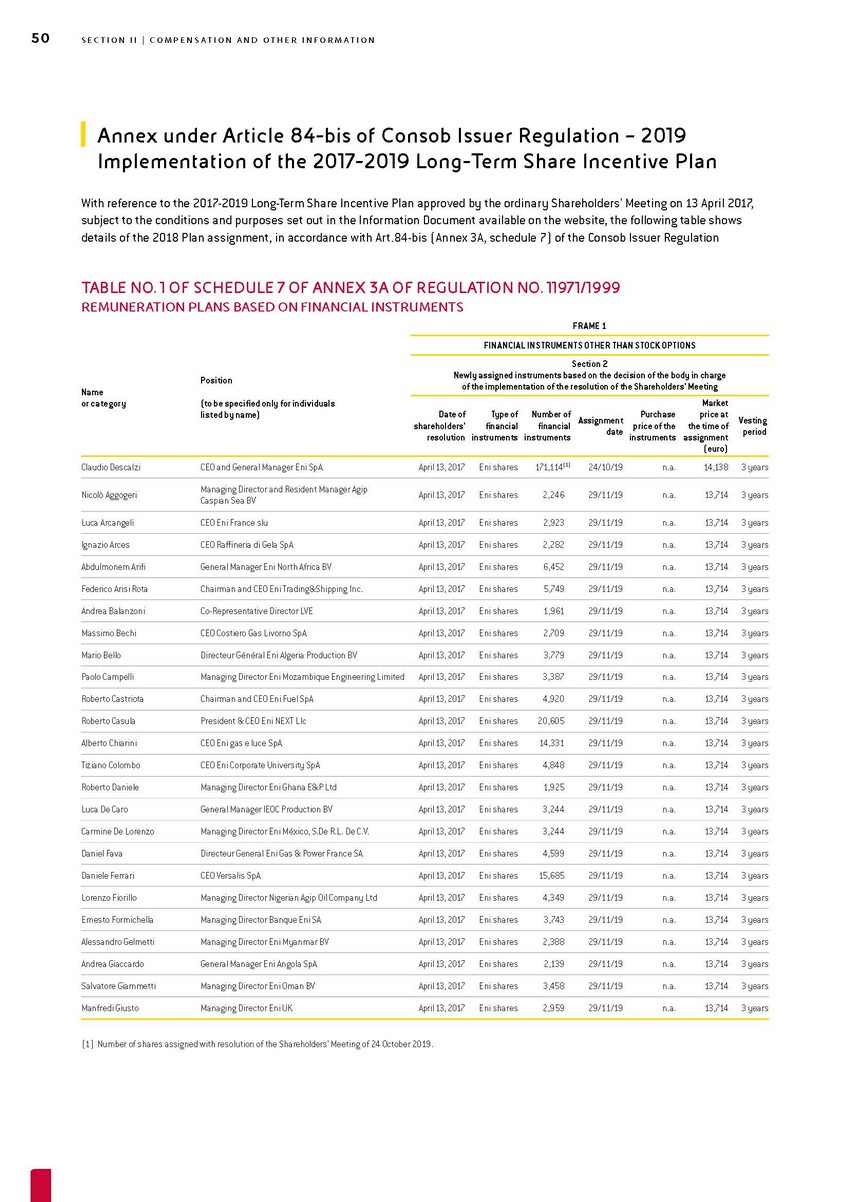 | Annex under Article 84-bis of Consob Issuer Regulation – 2019 Implementation of the 2017-2019 Long-Term Share Incentive Plan With reference to the 2017-2019 Long-Term Share Incentive Plan approved by the ordinary Shareholders’ Meeting on 13 April 2017, subject to the conditions and purposes set out in the Information Document available on the website, the following table shows details of the 2018 Plan assignment, in accordance with Art.84-bis (Annex 3A, schedule 7) of the Consob Issuer Regulation TABLE NO. 1 OF SCHEDULE 7 OF ANNEX 3A OF REGULATION NO. 11971/1999 REMUNERATION PLANS BASED ON FINANCIAL INSTRUMENTS Name or category Position (to be specified only for individuals FRAME 1 FINANCIAL INSTRUMENTS OTHER THAN STOCK OPTIONS Section 2 Newly assigned instruments based on the decision of the body in charge of the implementation of the resolution of the Shareholders' Meeting Market listed by name) Date of shareholders' Type of financial Number of financial Assignment date Purchase price of the price at the time of Vesting period resolution instruments instruments instruments assignment (euro) Claudio DescalziCEO and General Manager Eni SpAApril 13, 2017 Eni shares171,114(1)24/10/19n.a.14,138 3 years Number of shares assigned with resolution of the Shareholders' Meeting of 24 October 2019. |
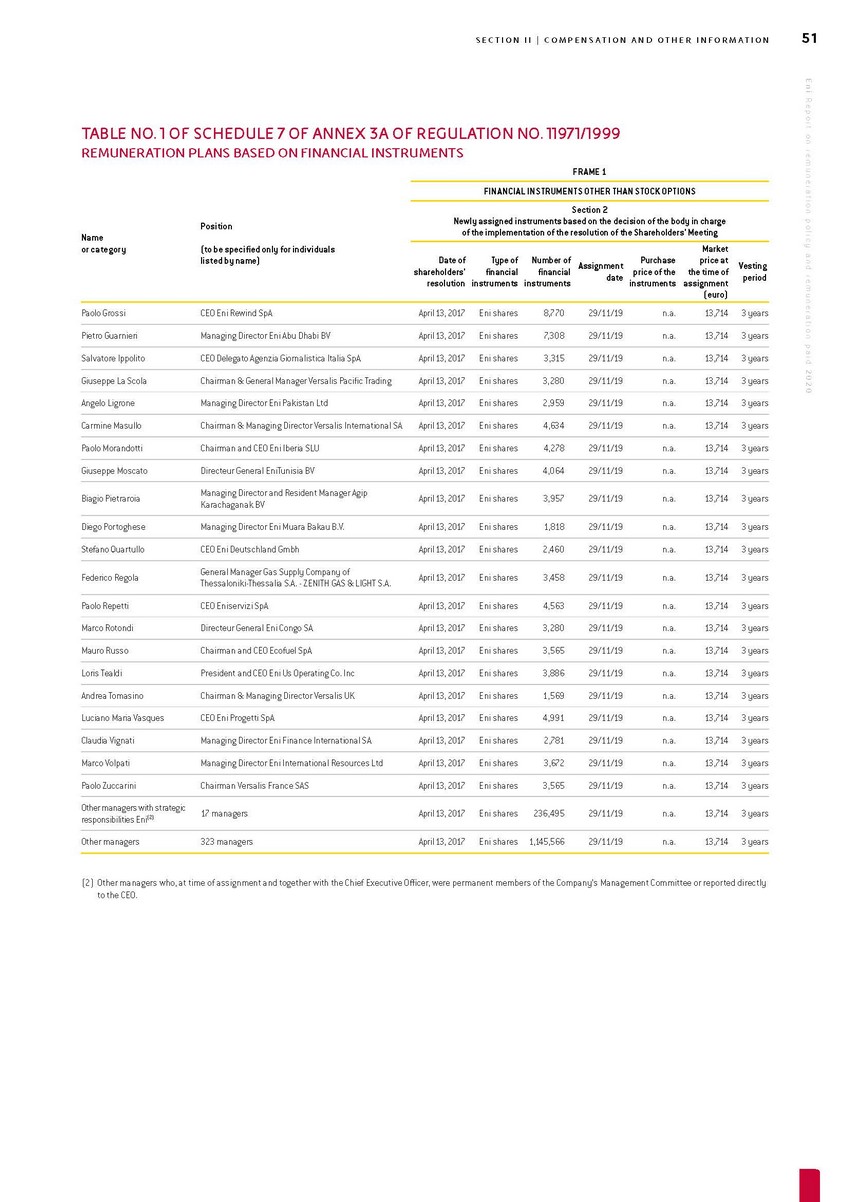 | Eni R eport on r emuner ation policy and r emuner ation paid 20 20 REMUNERATION PLANS BASED ON FINANCIAL INSTRUMENTS Name or category Position (to be specified only for individuals FRAME 1 FINANCIAL INSTRUMENTS OTHER THAN STOCK OPTIONS Section 2 Newly assigned instruments based on the decision of the body in charge of the implementation of the resolution of the Shareholders' Meeting Market listed by name) Date of shareholders' Type of financial Number of financial Assignment date Purchase price of the price at the time of Vesting period resolution instruments instruments instruments assignment Other managers who, at time of assignment and together with the Chief Executive Offi er, were permanent members of the Company's Management Committee or reported directly to the CEO. |
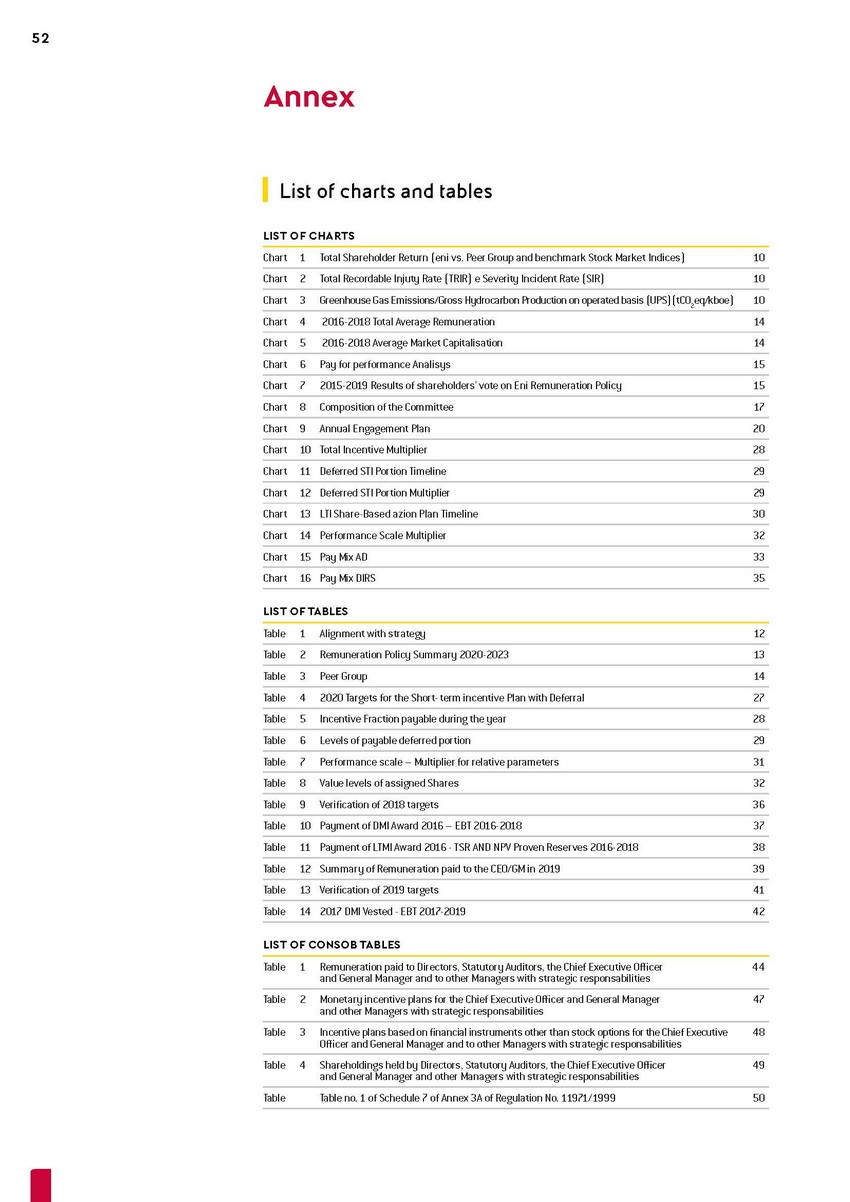 | Annex List of charts and tables LIST OF CHARTS LIST OF CONSOB TABLES Table 1 Remuneration paid to Directors, Statutory Auditors, the Chief Executive Officer44 and General Manager and to other Managers with strategic responsabilities Table 2 Monetary incentive plans for the Chief Executive Officer and General Manager47 and other Managers with strategic responsabilities Table 3 Incentive plans based on fi ancial instruments other than stock options for the Chief Executive48 Officer and General Manager and to other Managers with strategic responsabilities Table 4 Shareholdings held by Directors, Statutory Auditors, the Chief Executive Officer49 and General Manager and other Managers with strategic responsabilities TableTable no. 1 of Schedule 7 of Annex 3A of Regulation No. 11971/199950 |
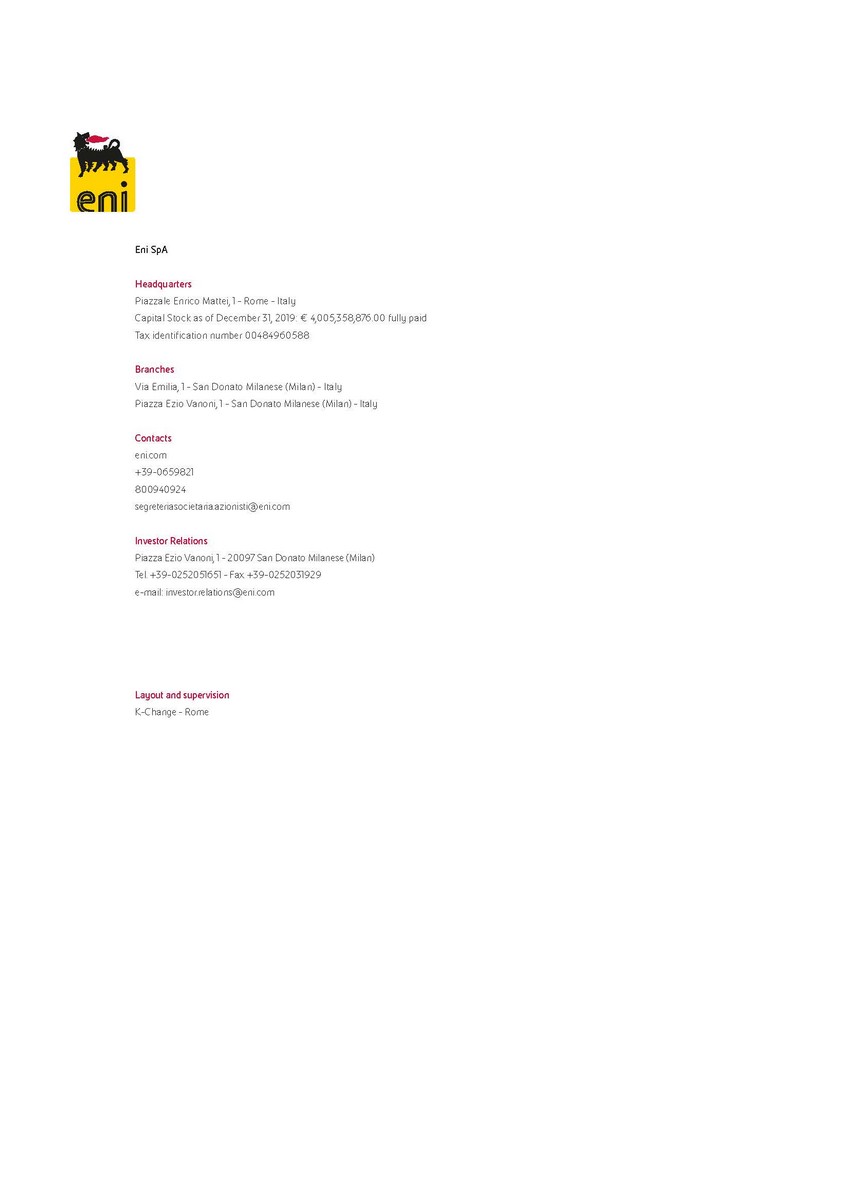 | Eni SpA Headquarters Piazzale Enrico Mattei, 1 - Rome - Italy Capital Stock as of December 31, 2019: € 4,005,358,876.00 fully paid Tax identification number 00484960588 Branches Via Emilia, 1 - San Donato Milanese (Milan) - Italy Piazza Ezio Vanoni, 1 - San Donato Milanese (Milan) - Italy Contacts eni.com +39-0659821 800940924 segreteriasocietaria.azionisti@eni.com Investor Relations Piazza Ezio Vanoni, 1 - 20097 San Donato Milanese (Milan) Tel. +39-0252051651 - Fax +39-0252031929 e-mail: investor.relations@eni.com Layout and supervision K-Change - Rome |
 | [LOGO] |